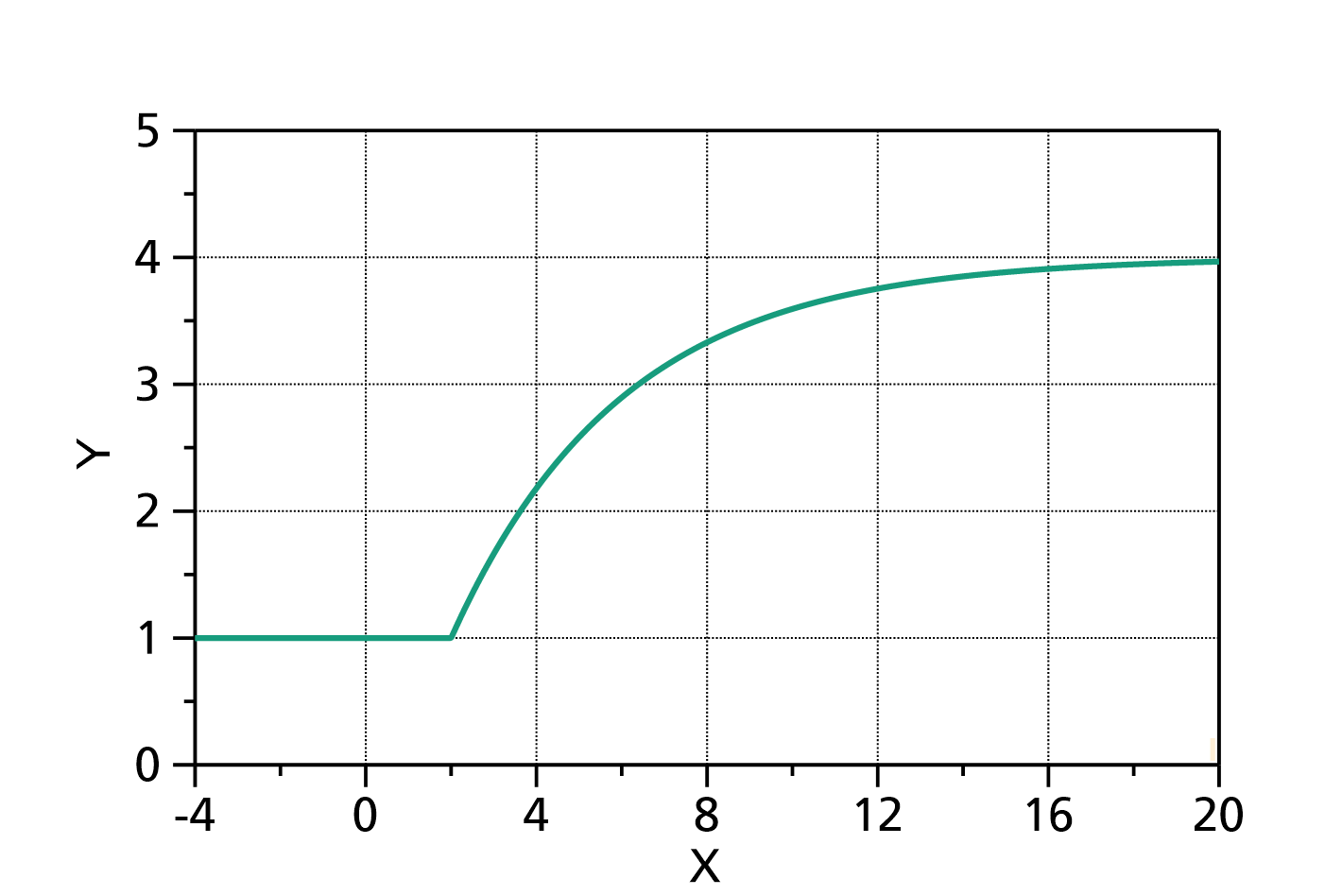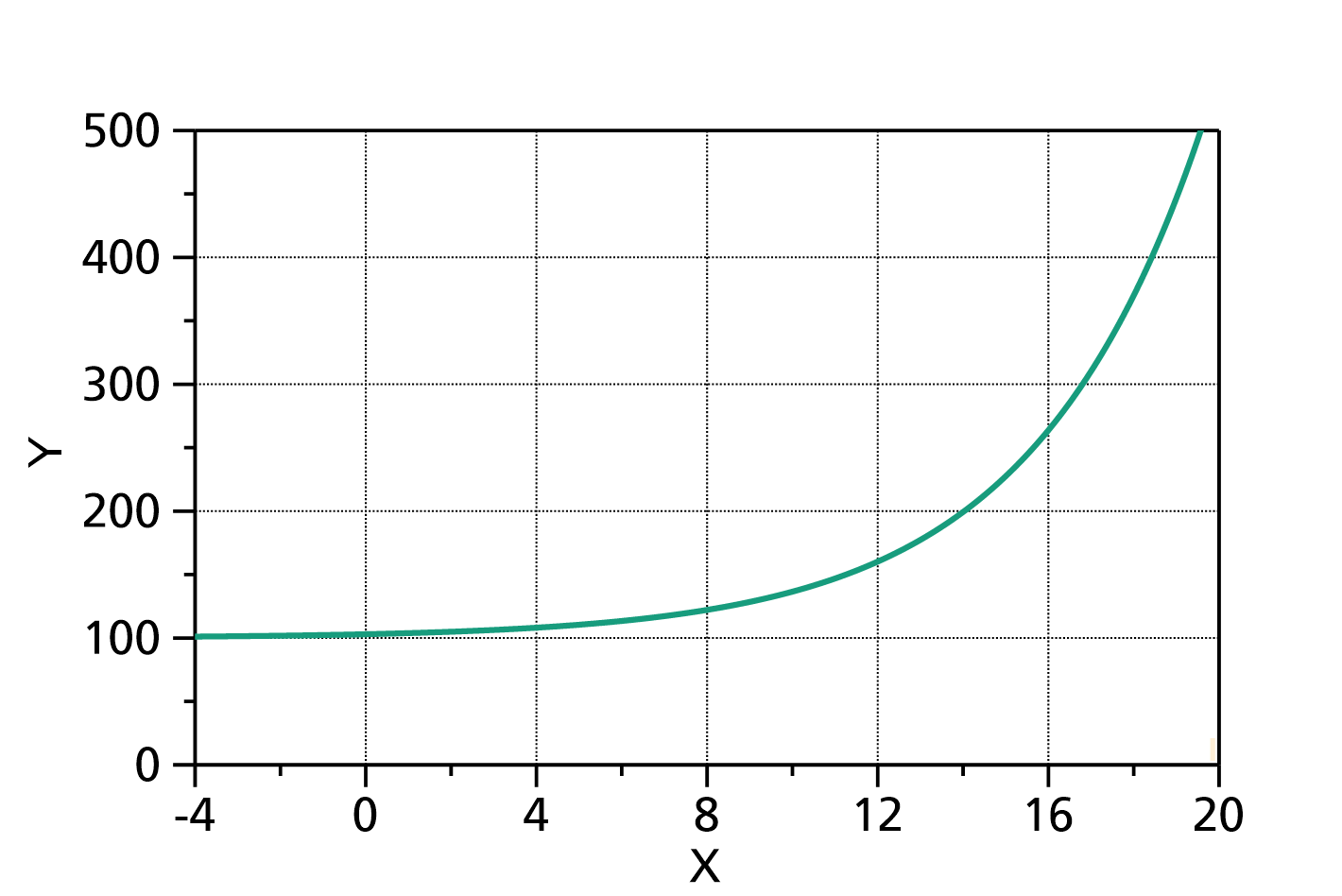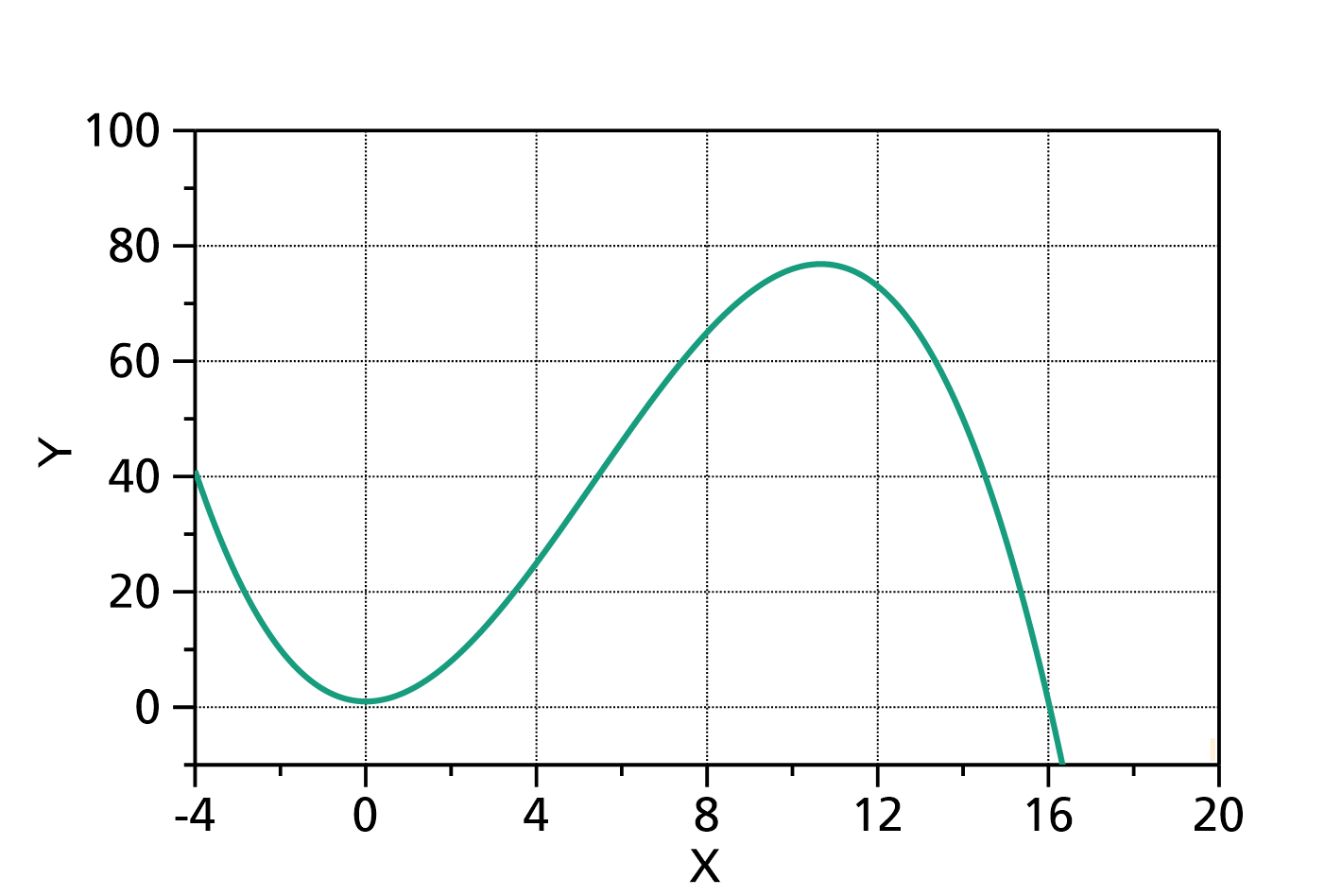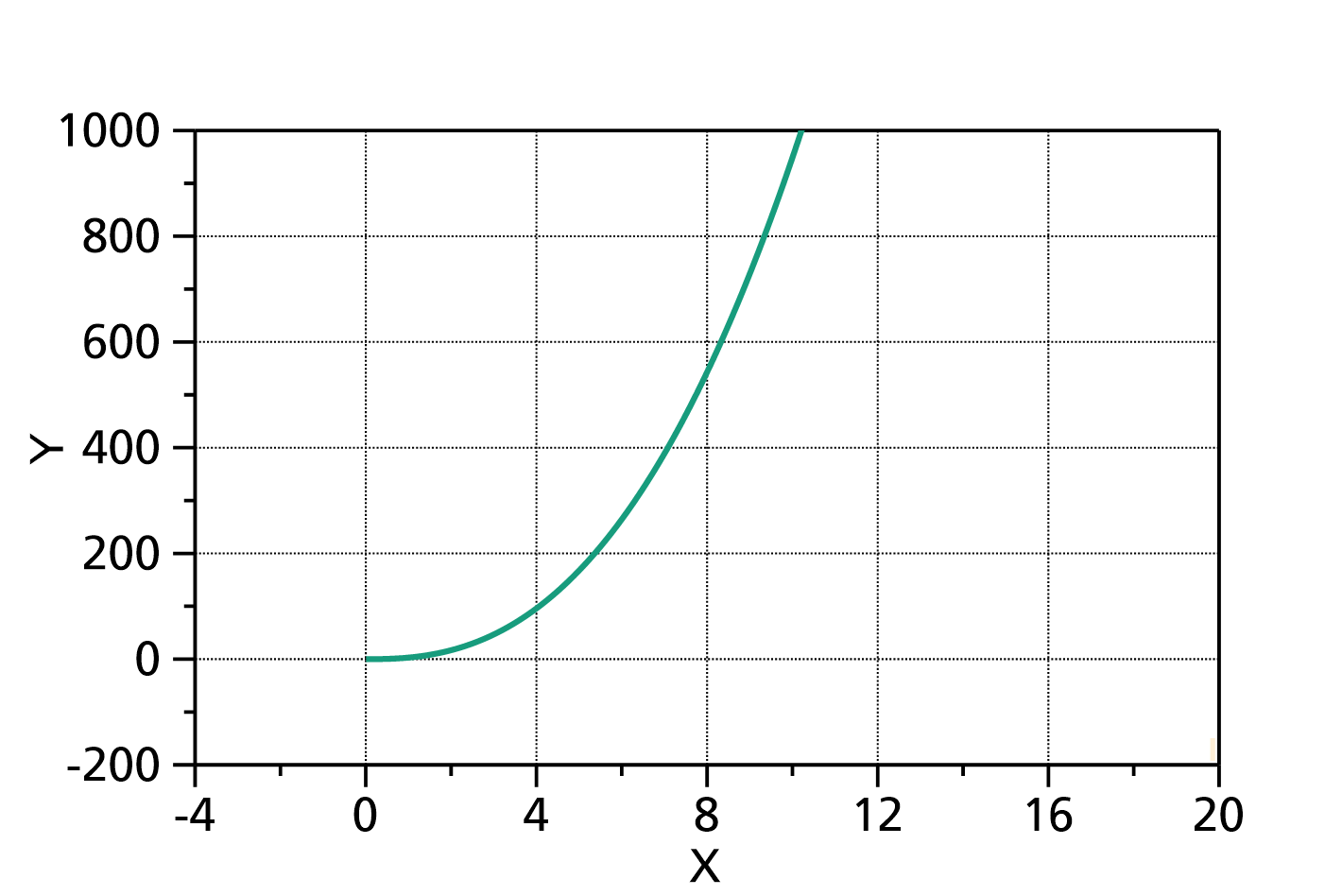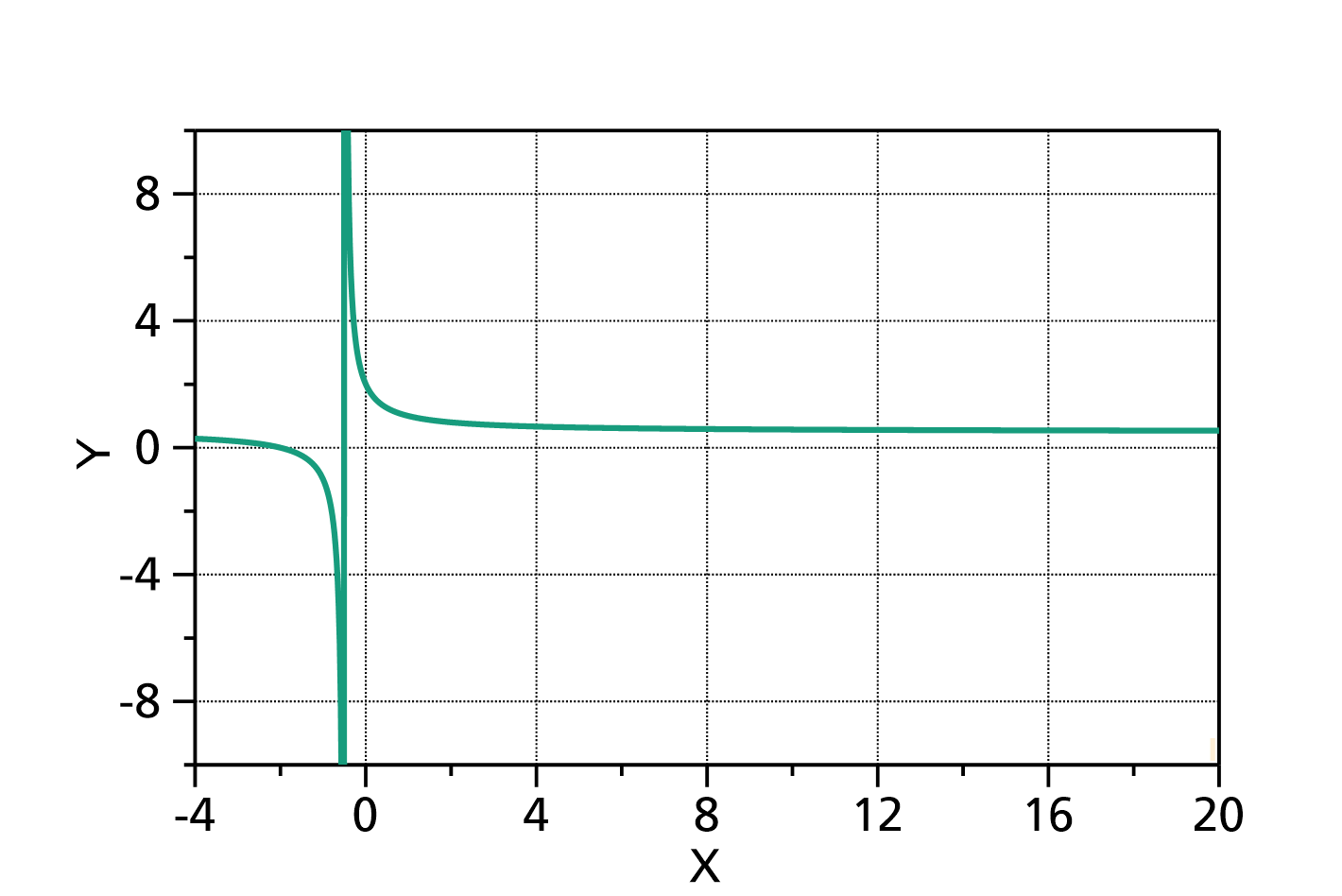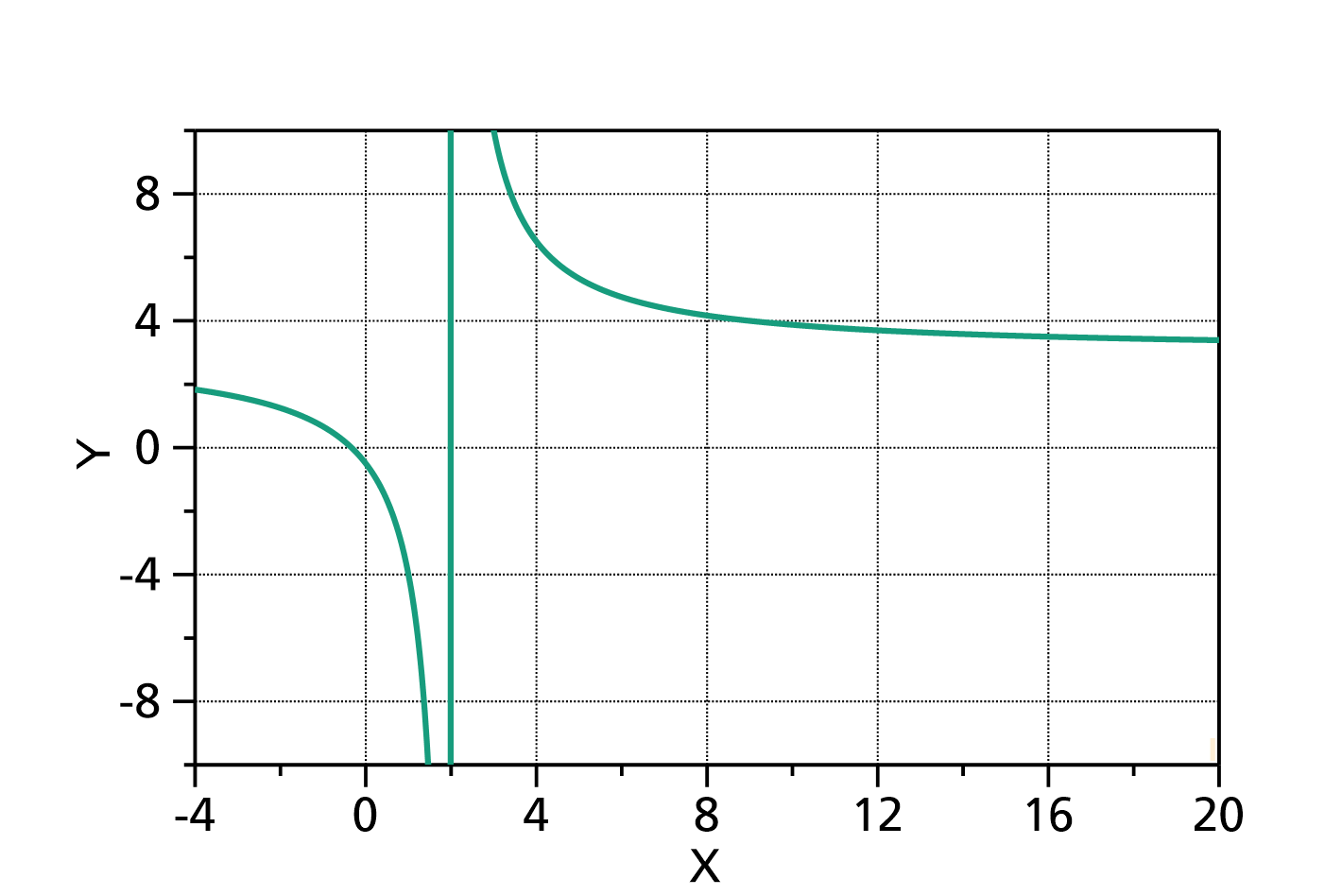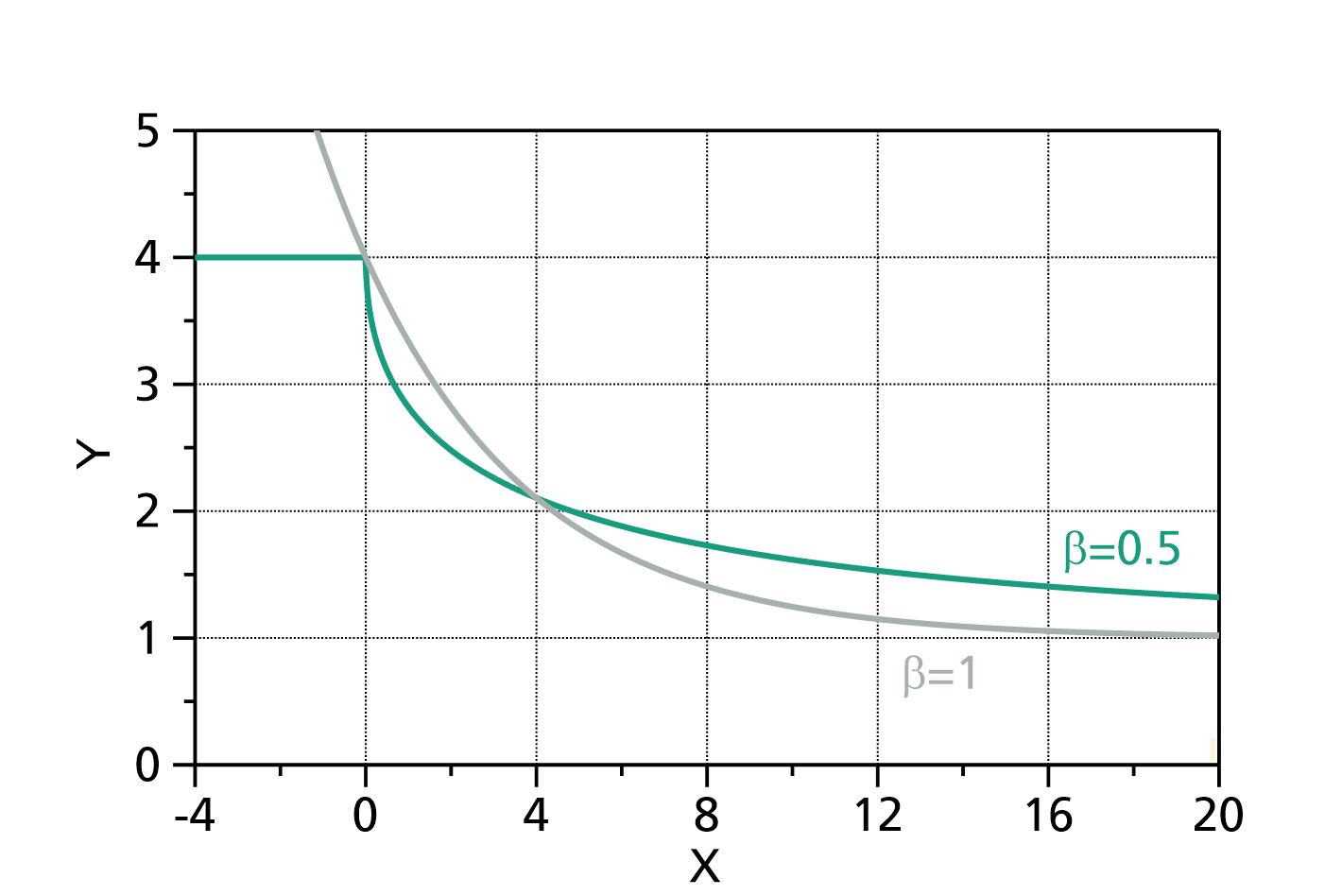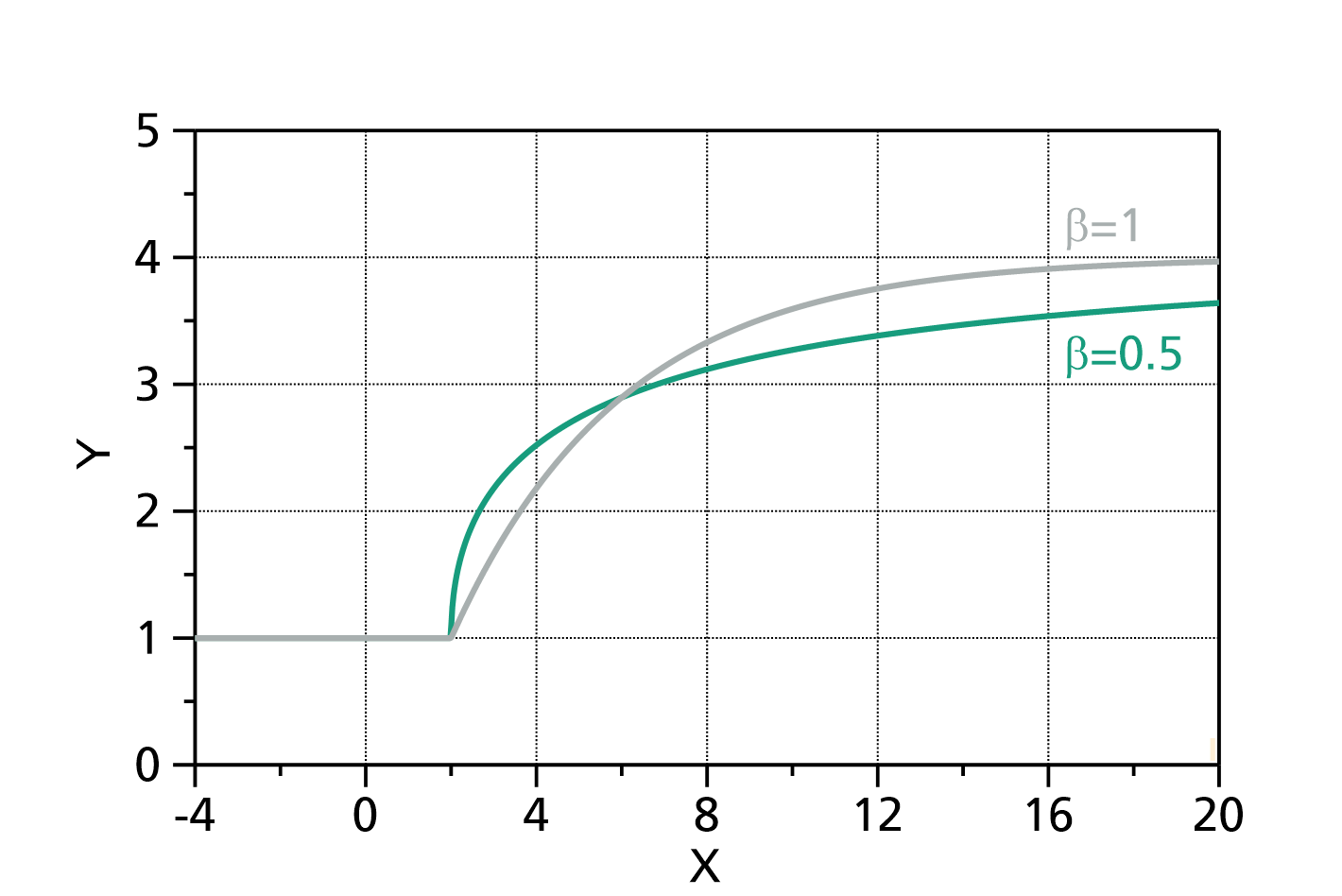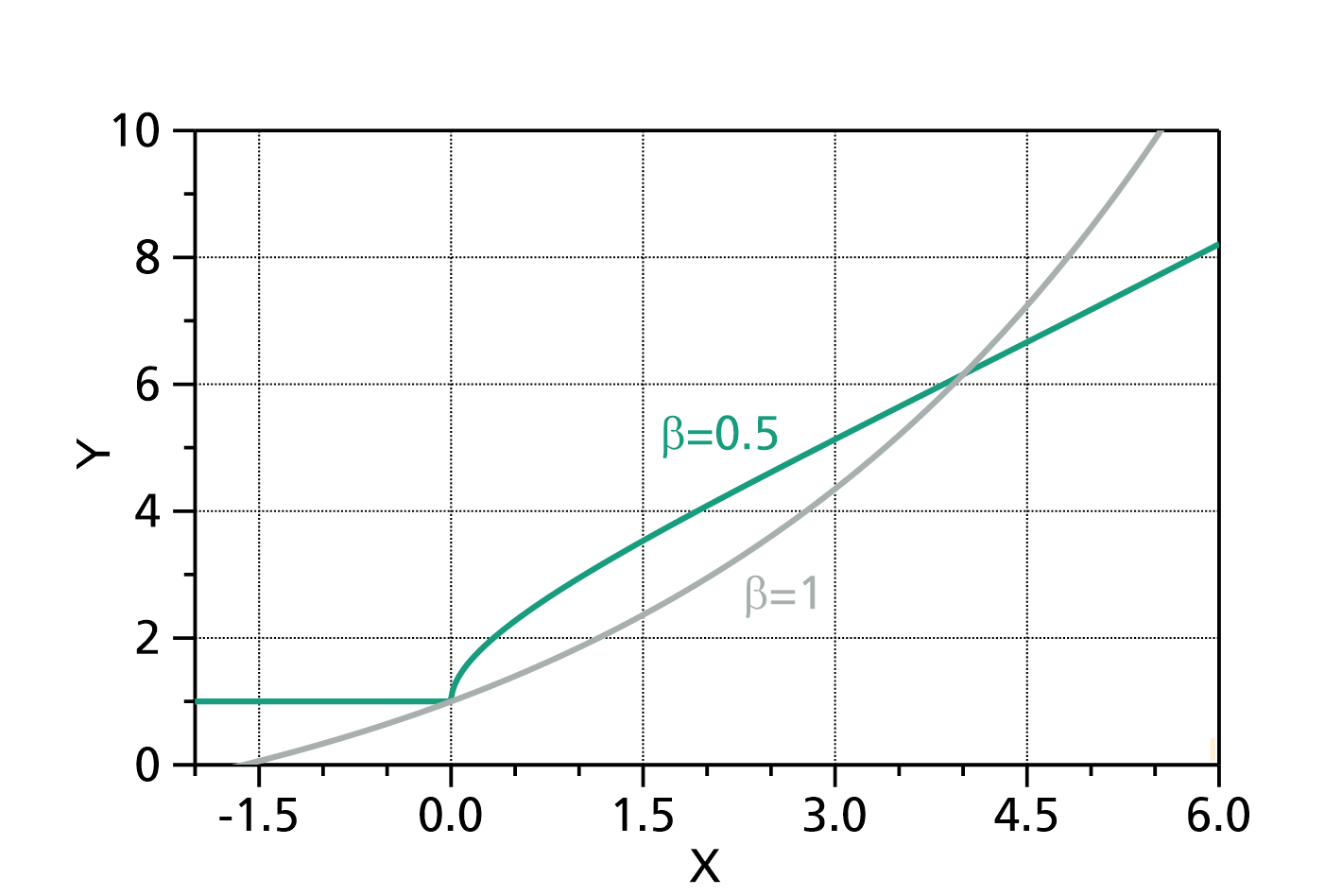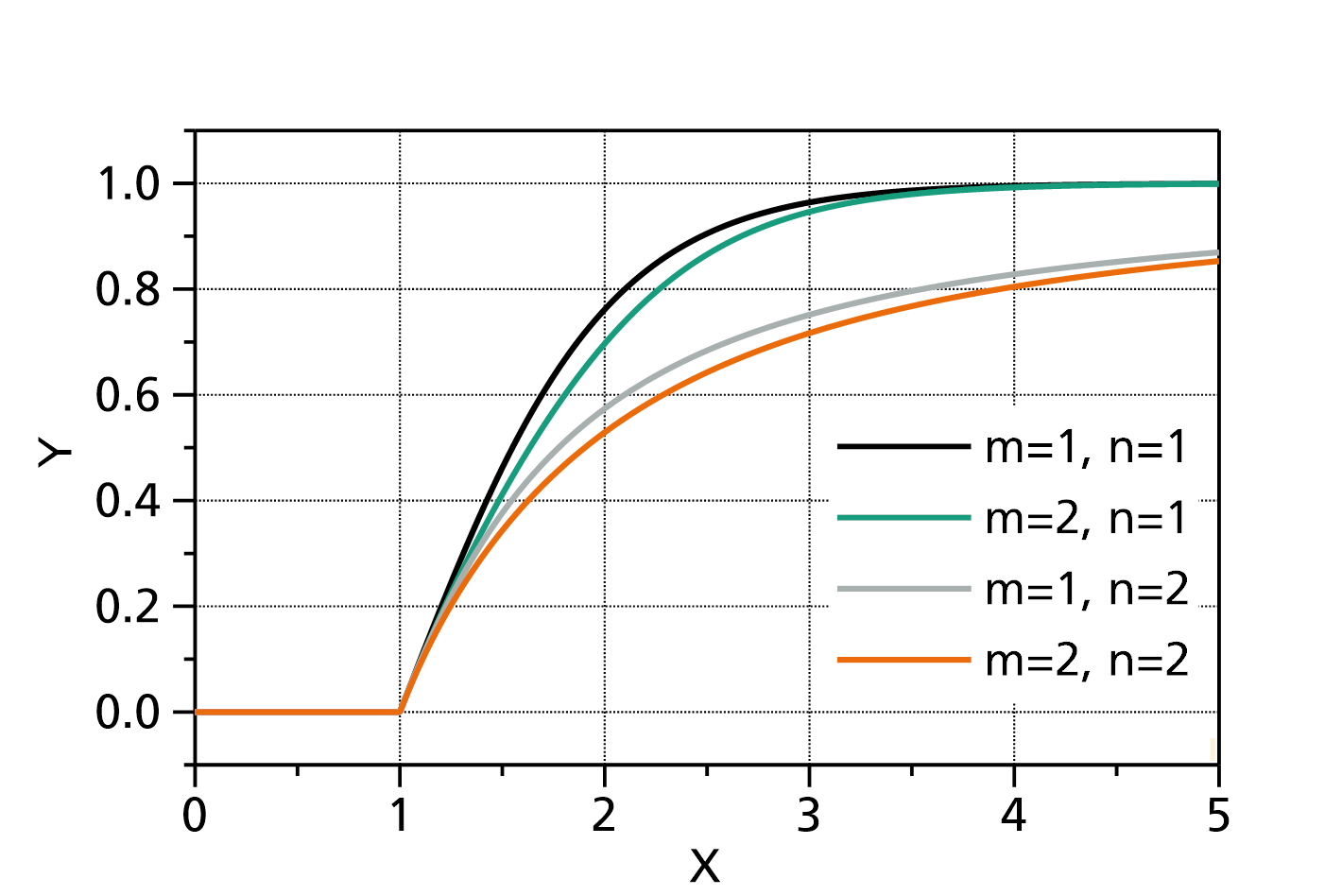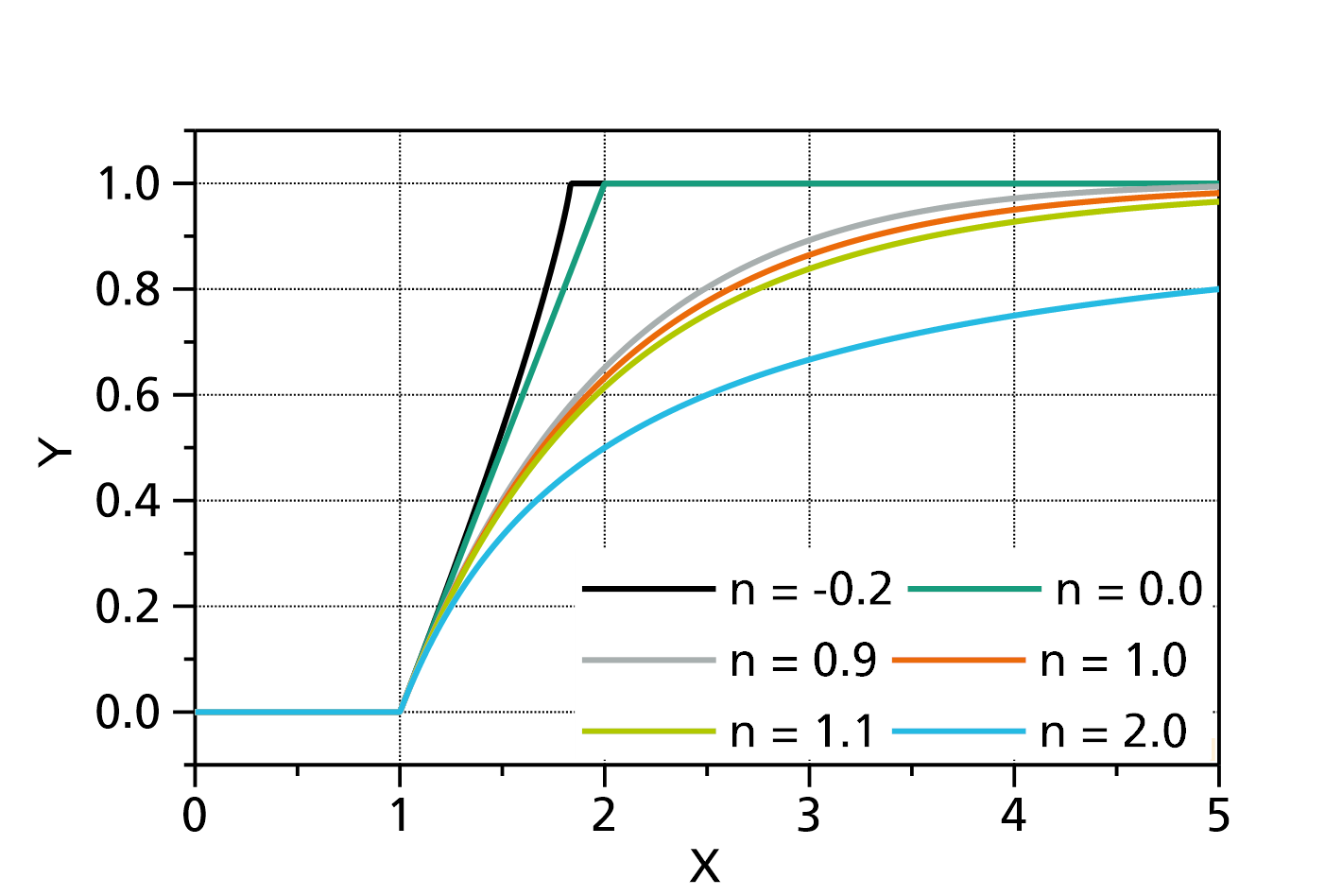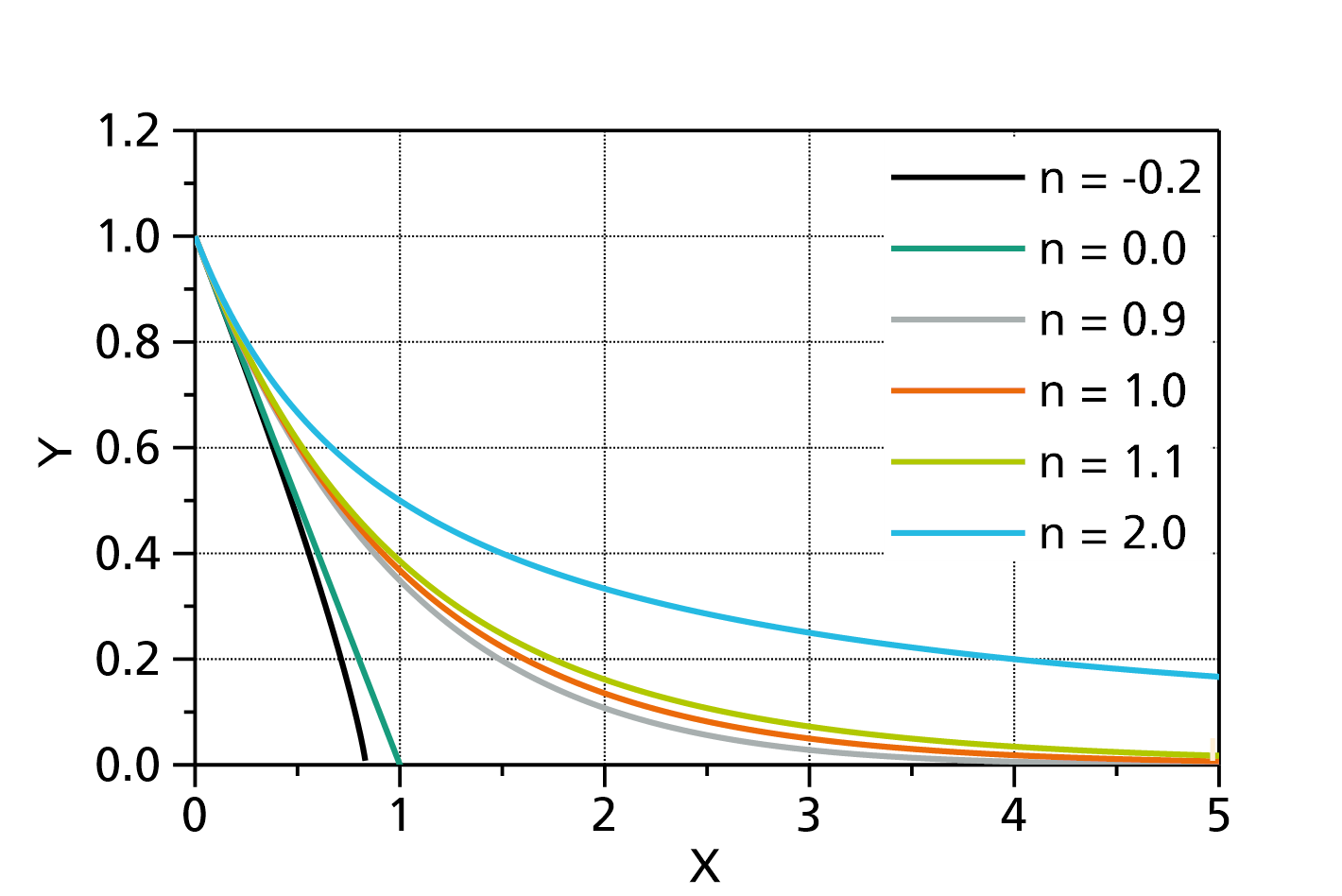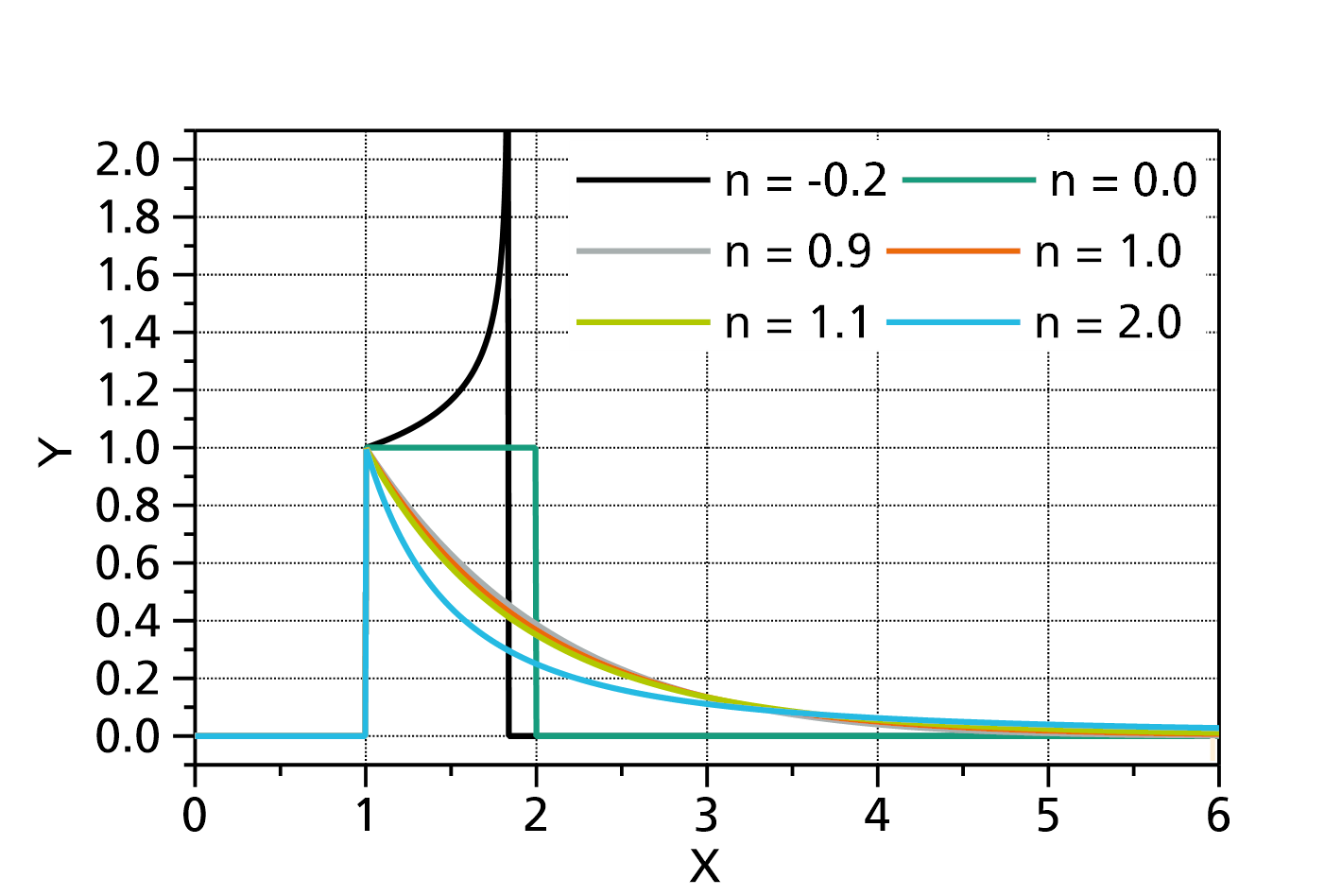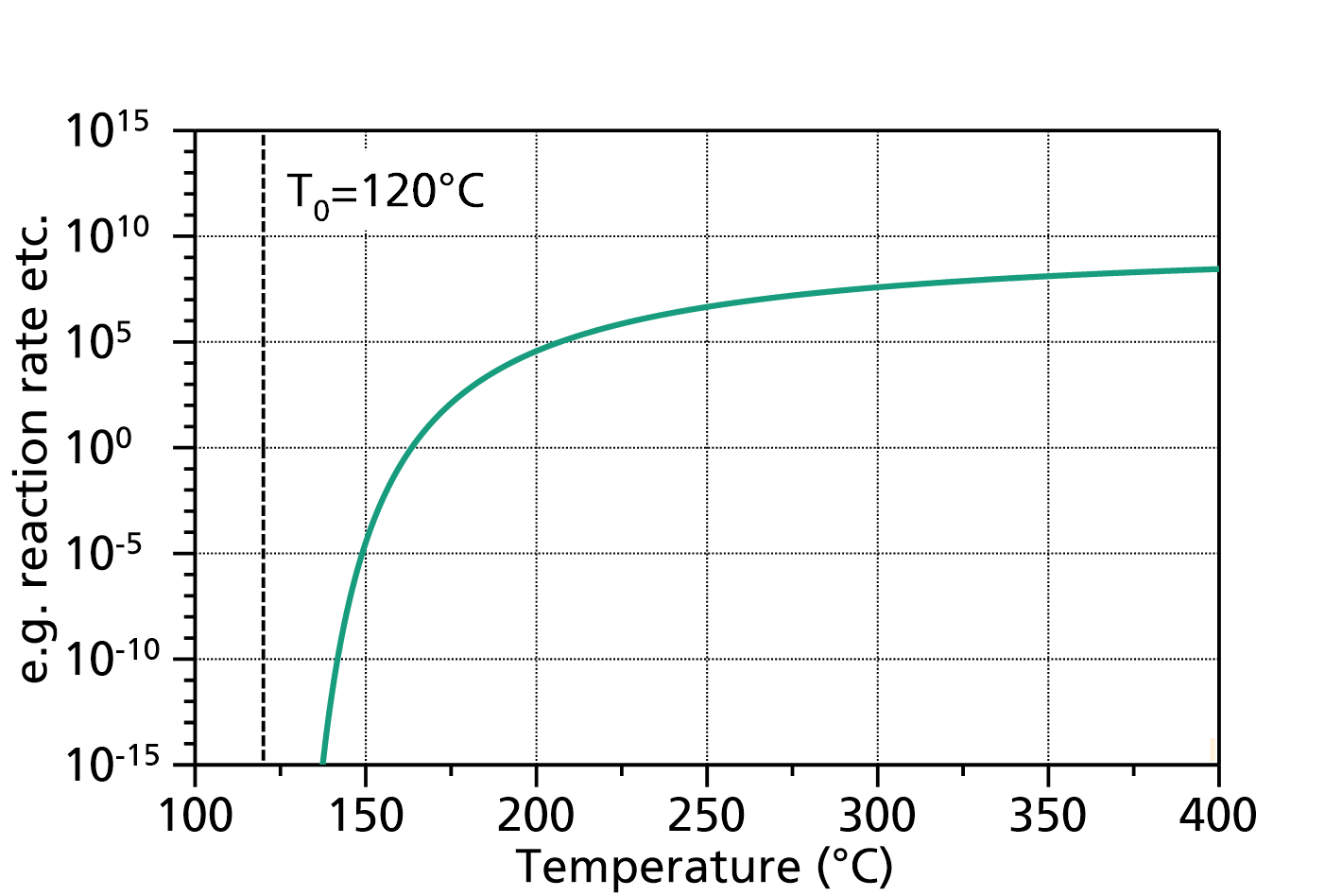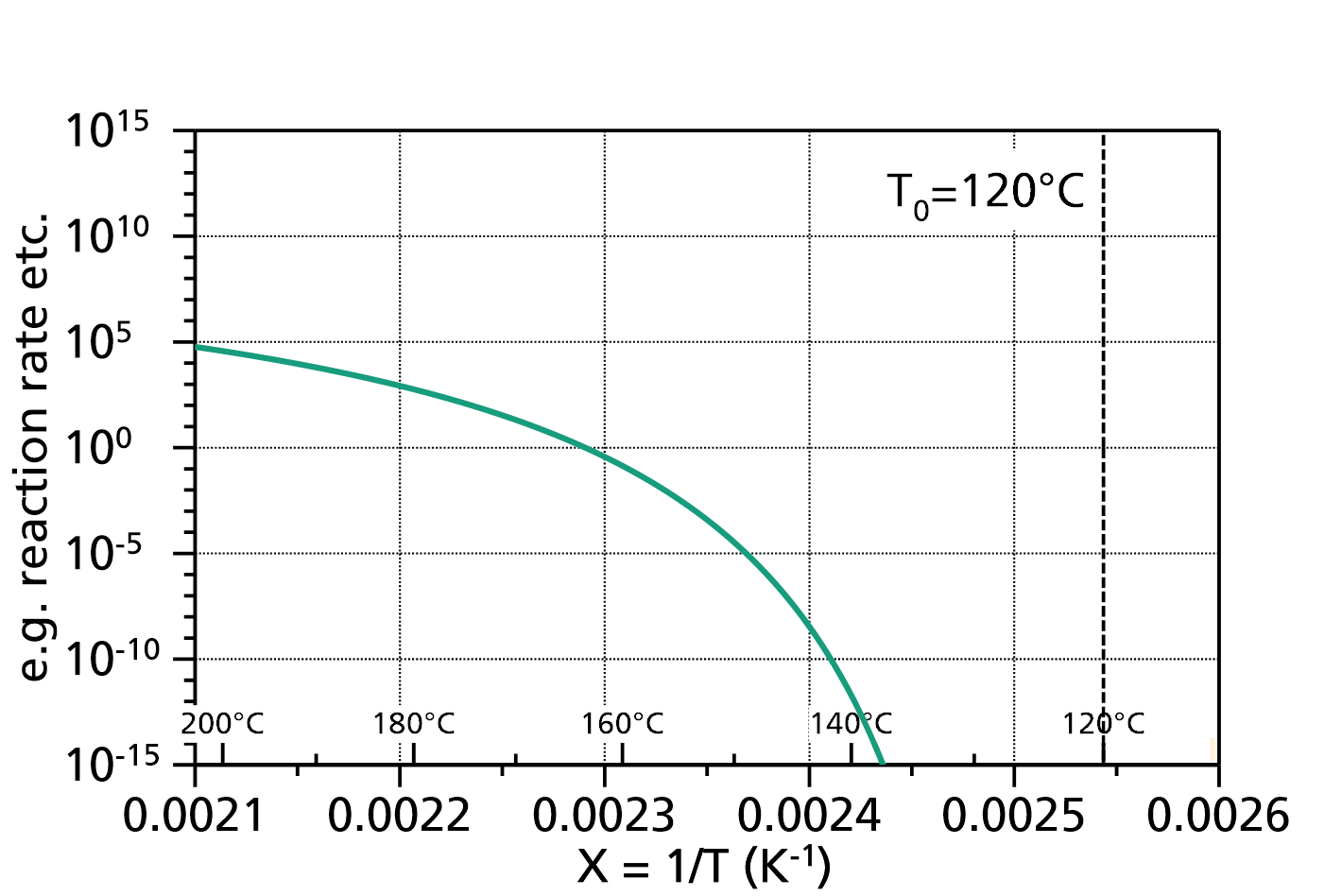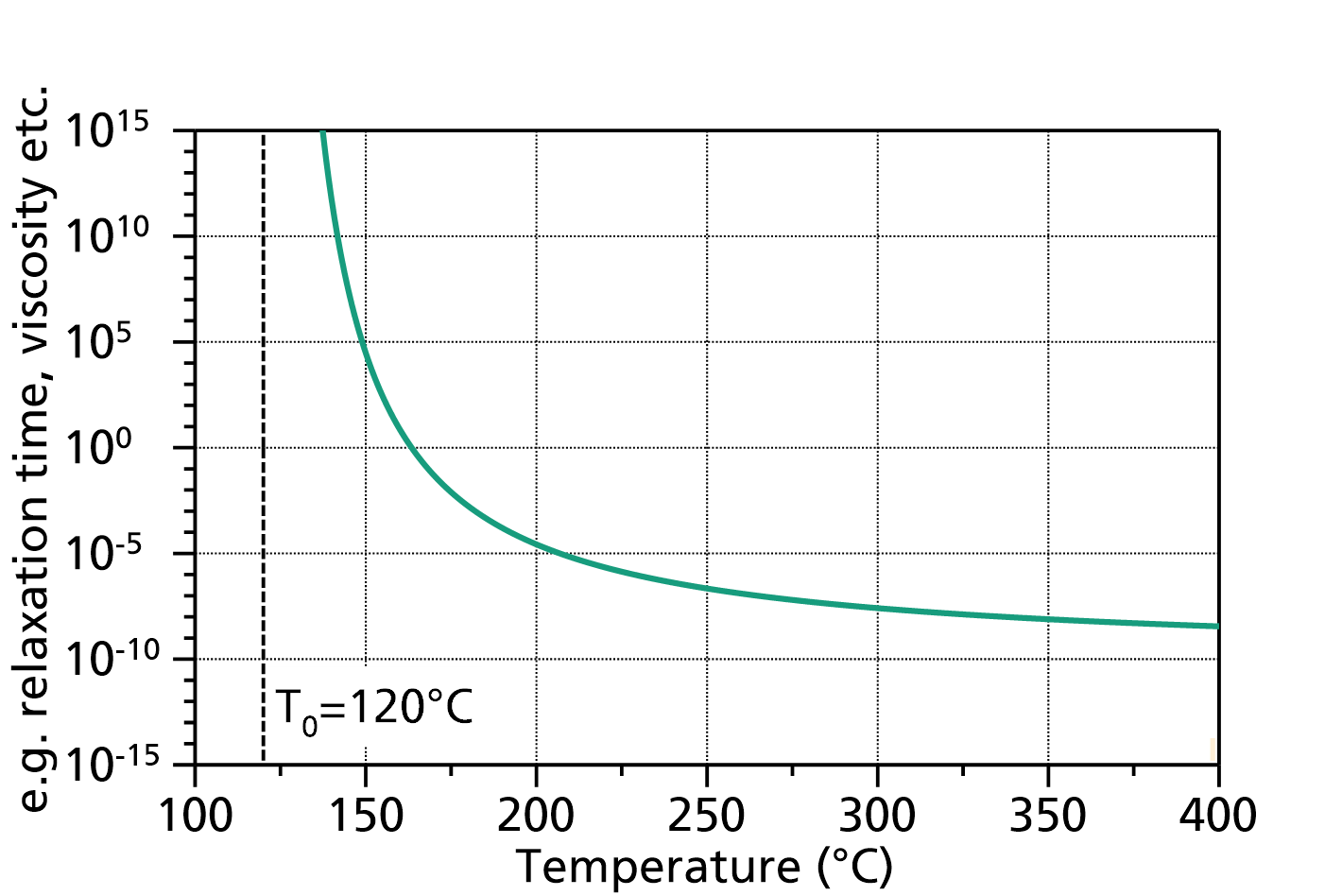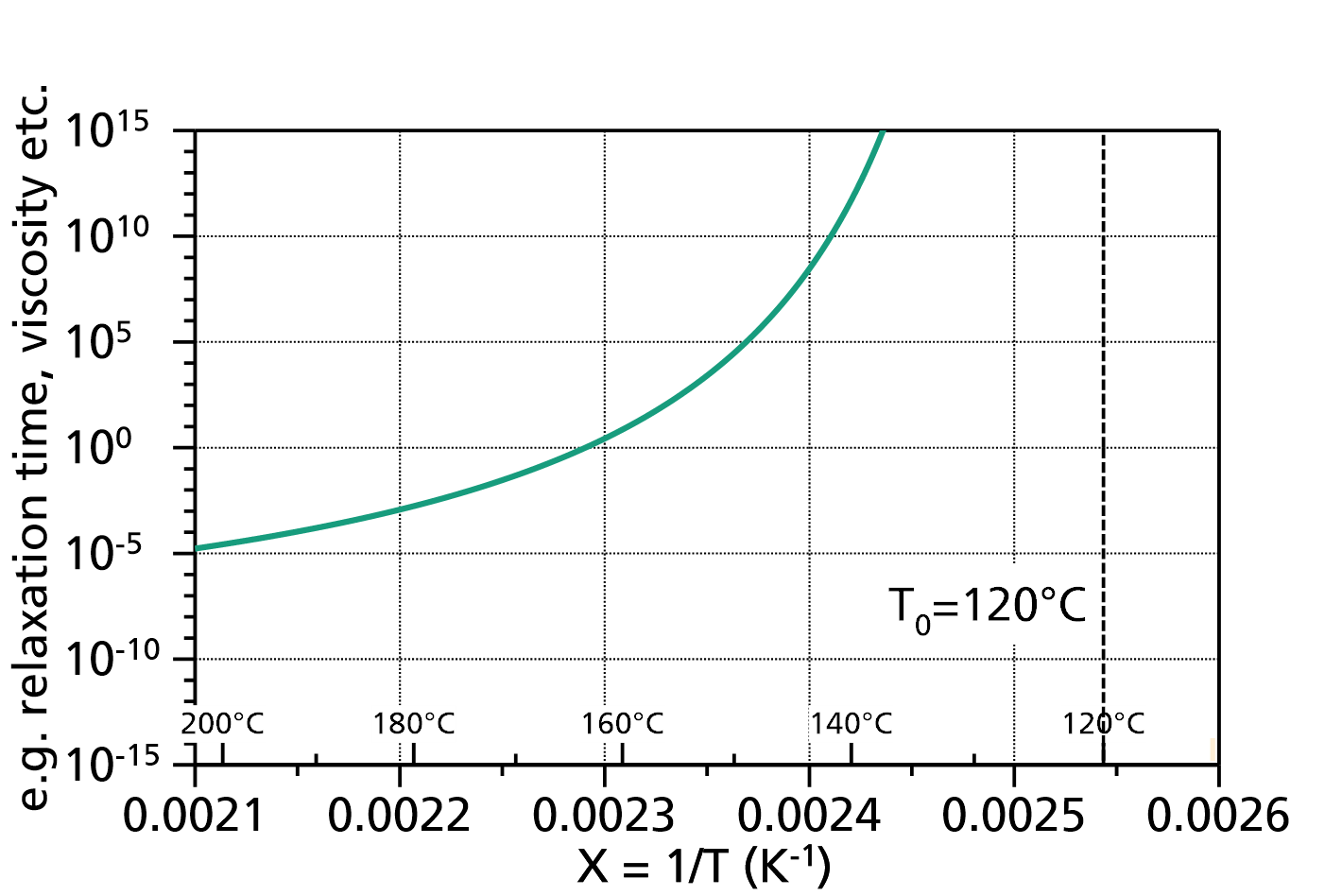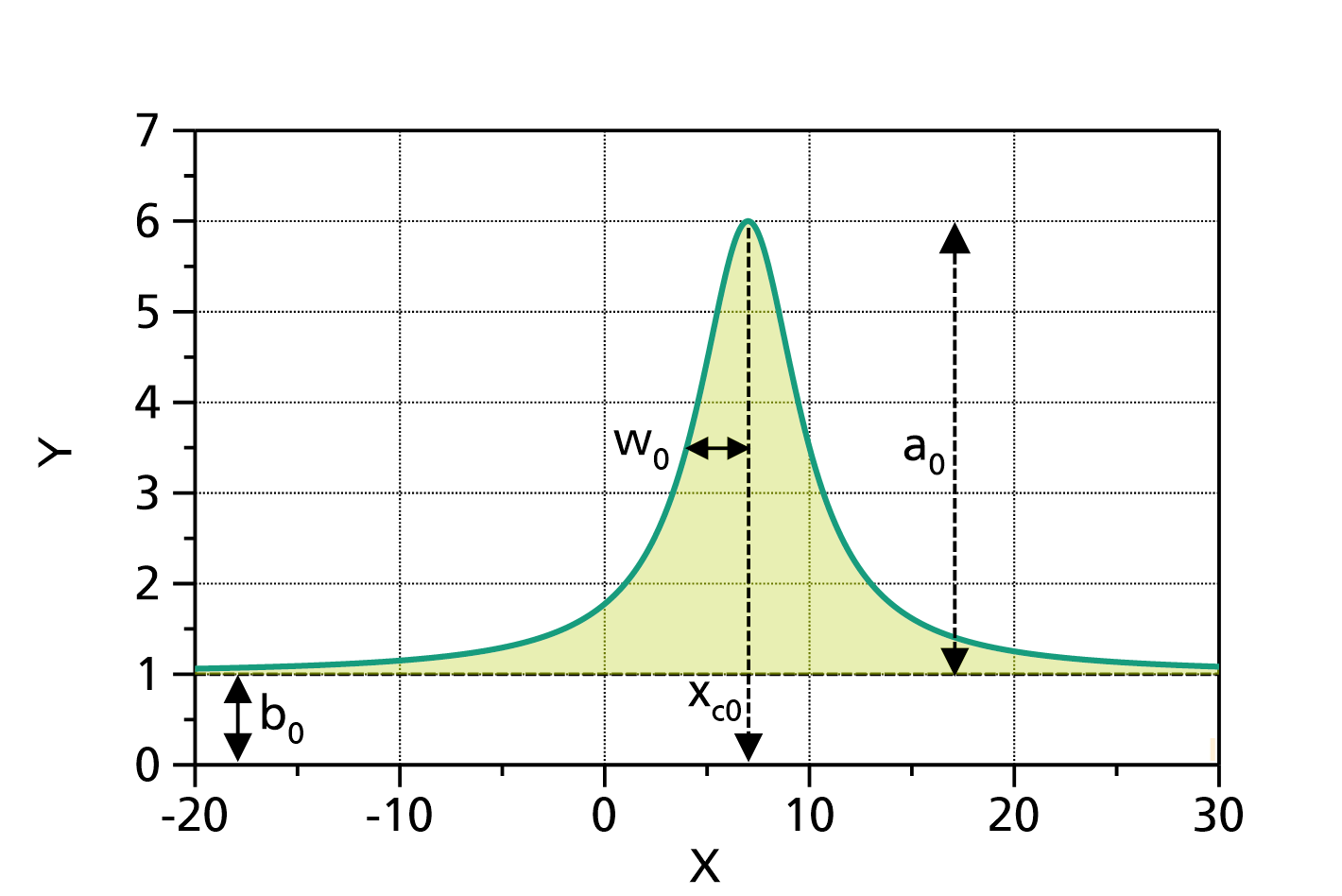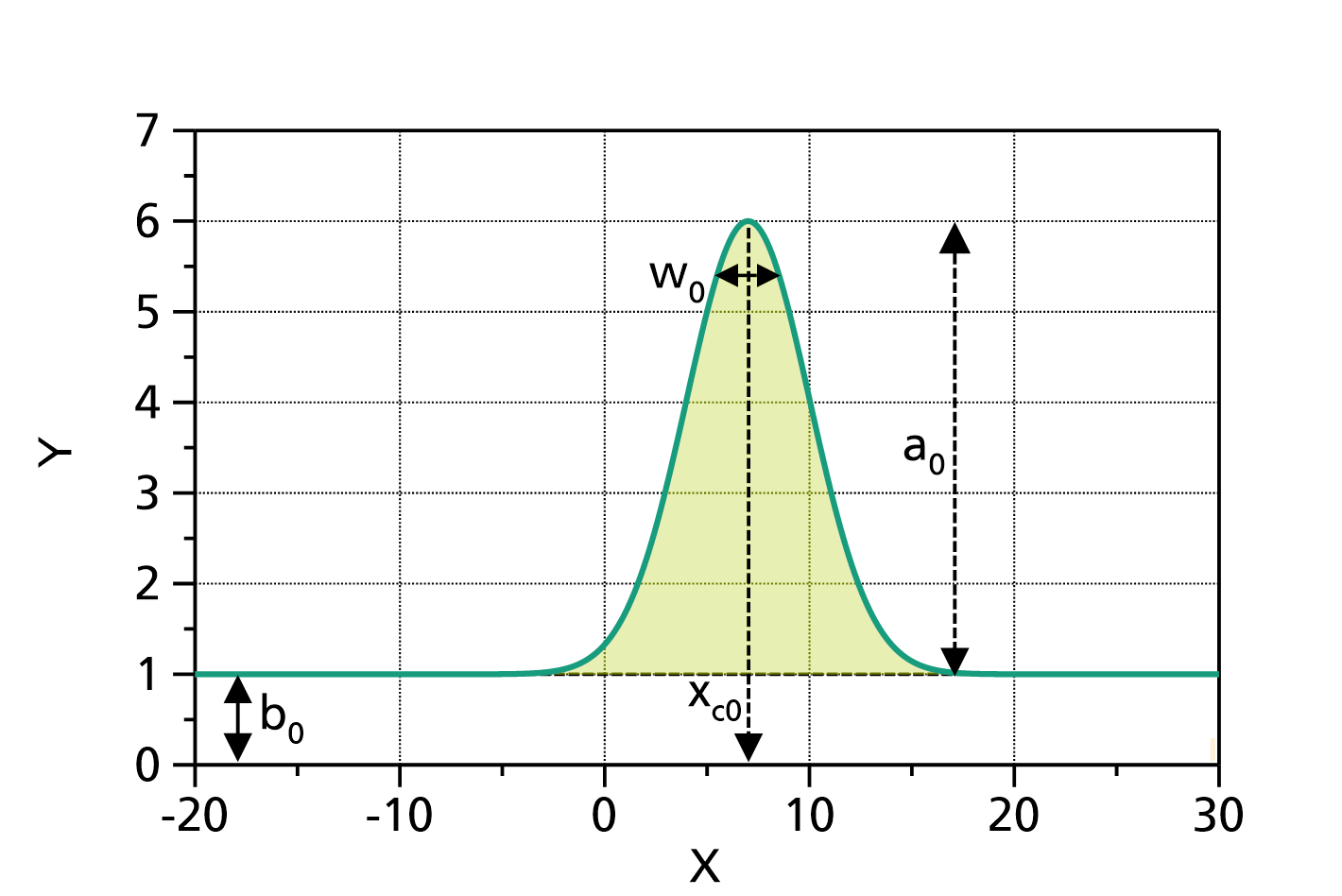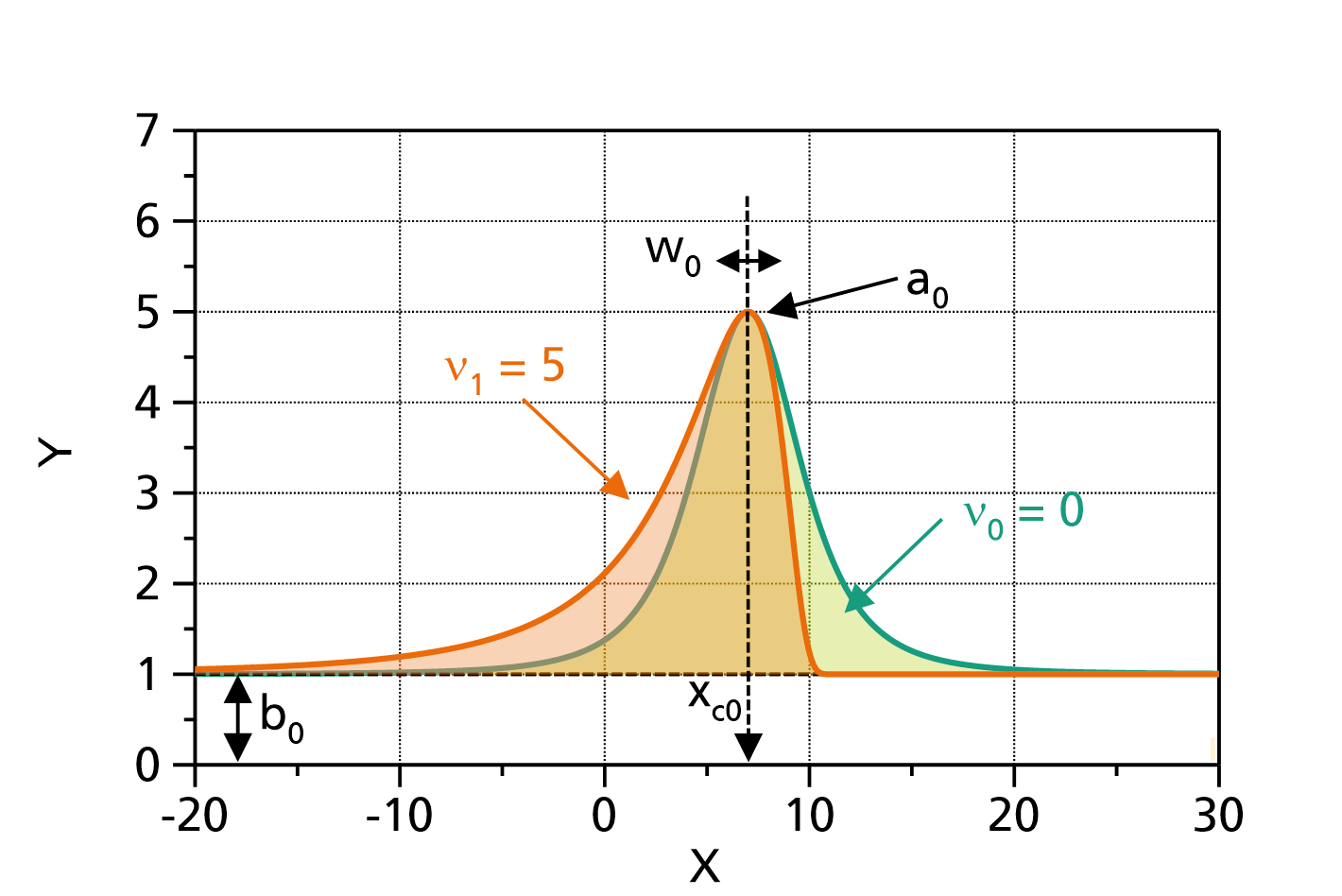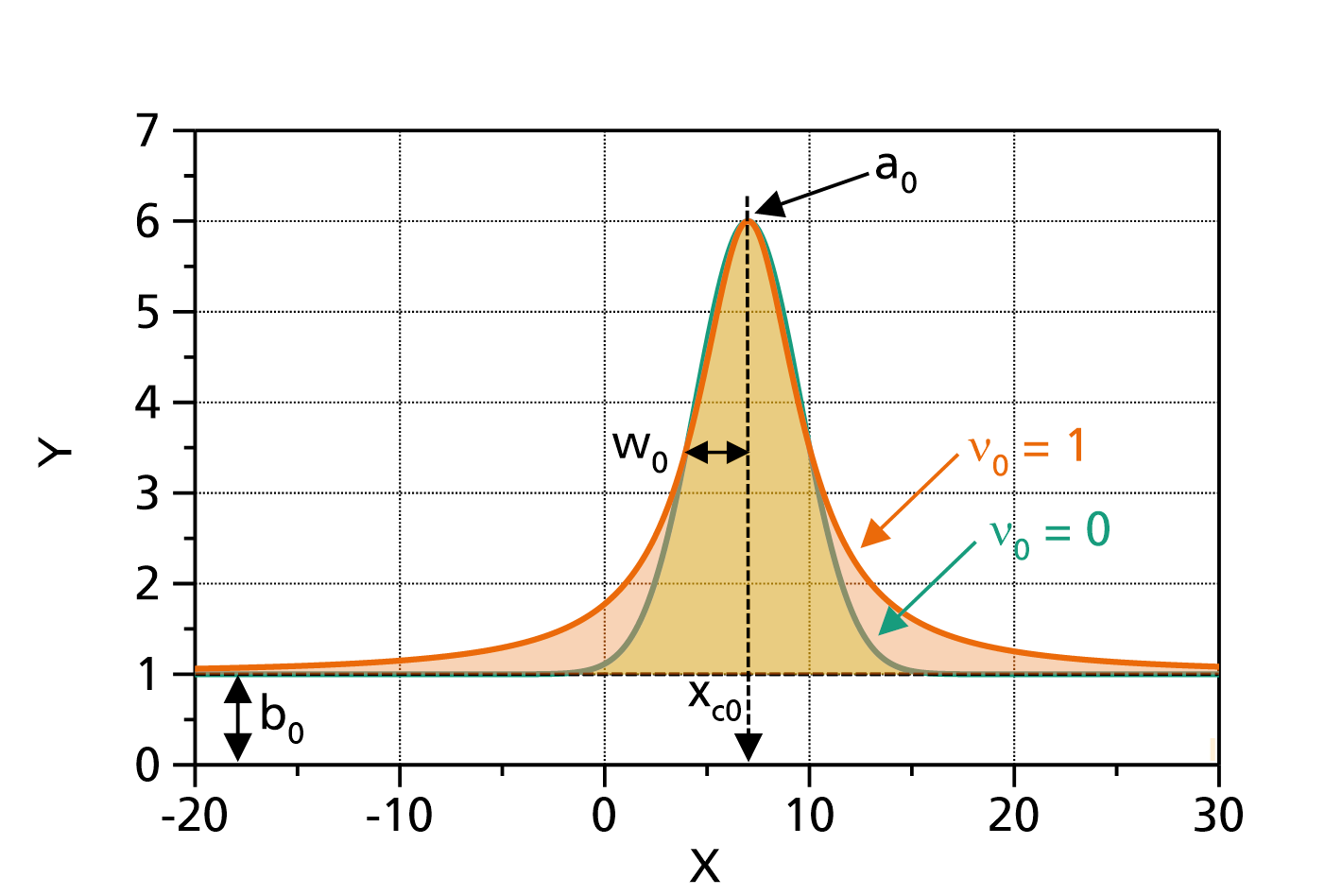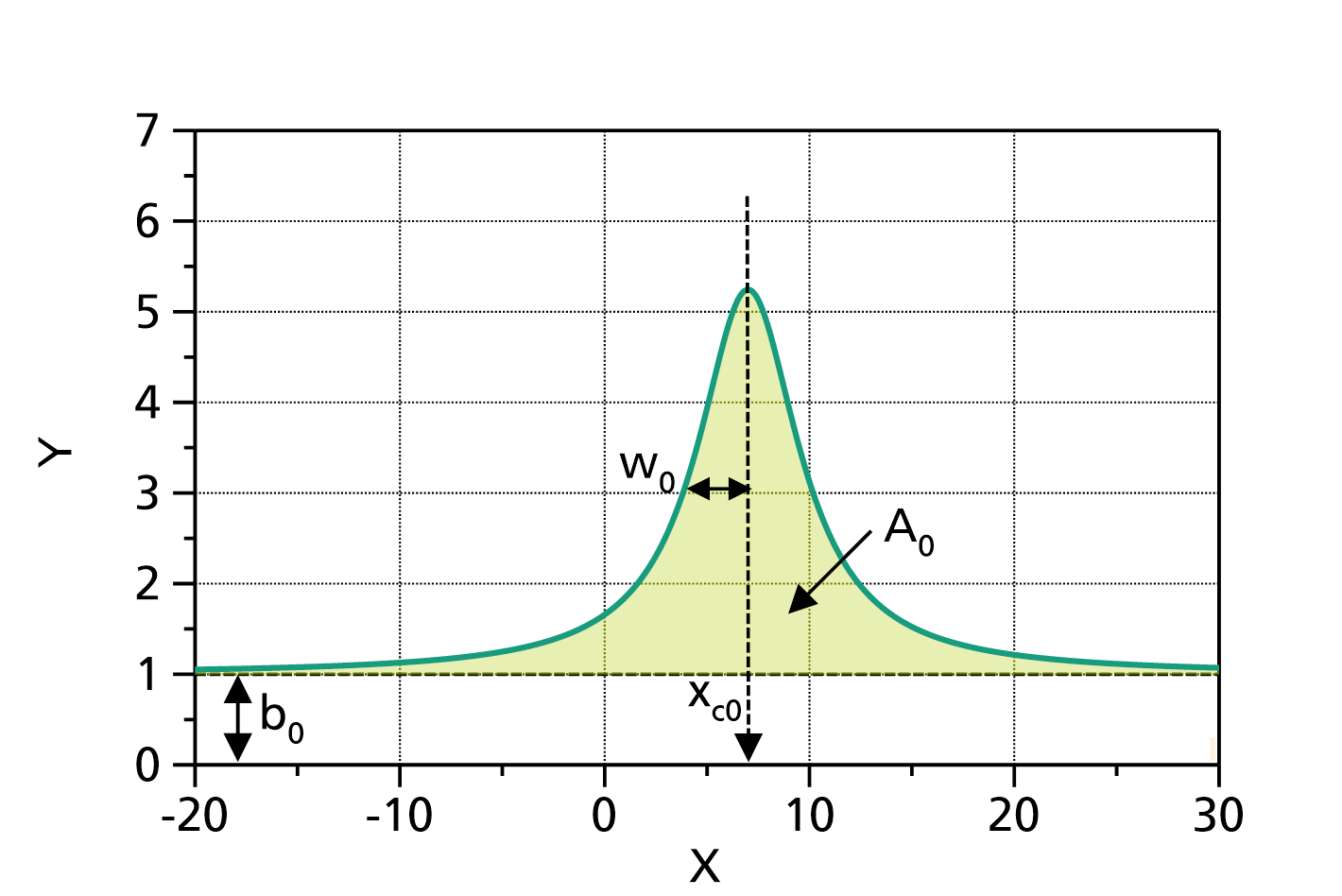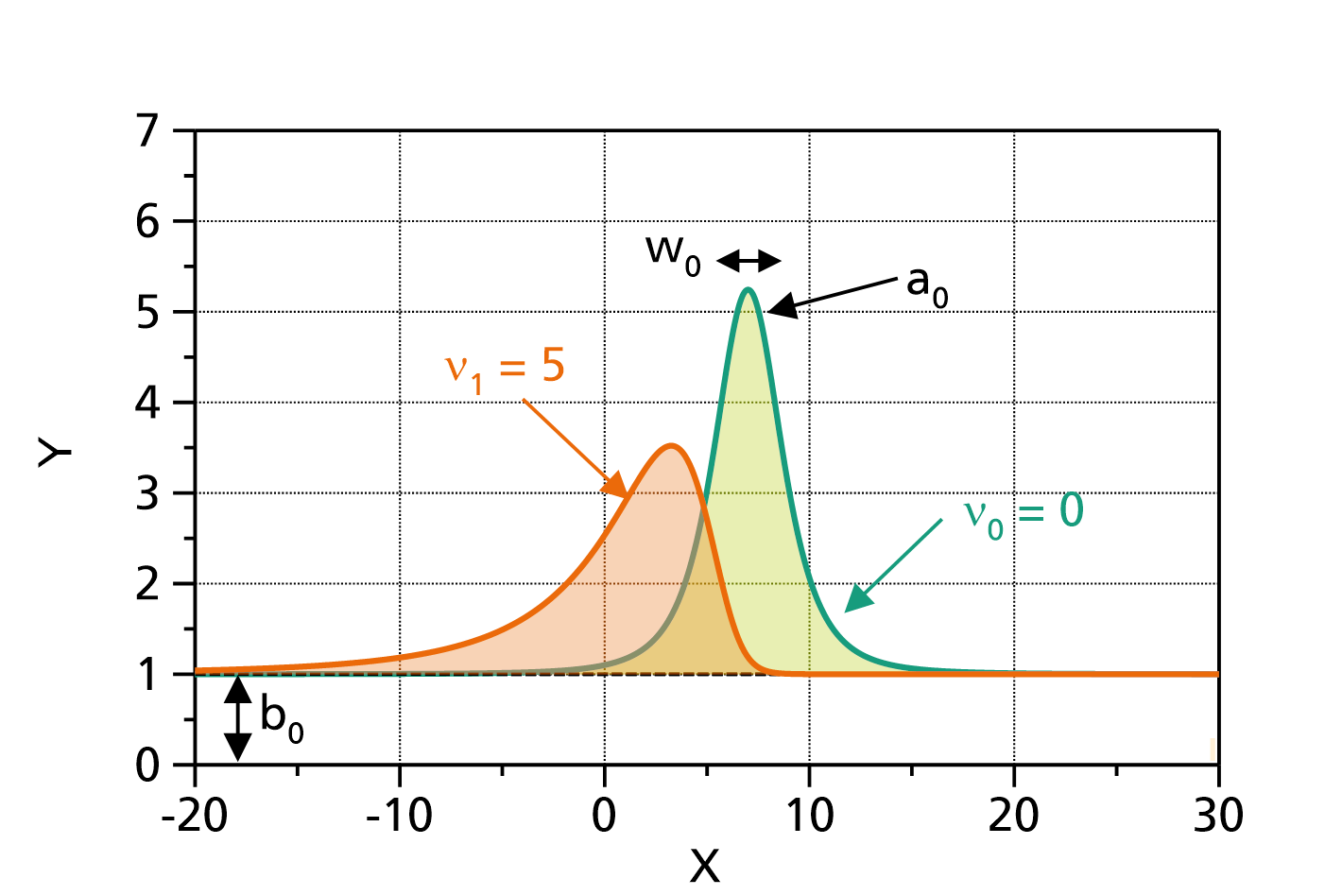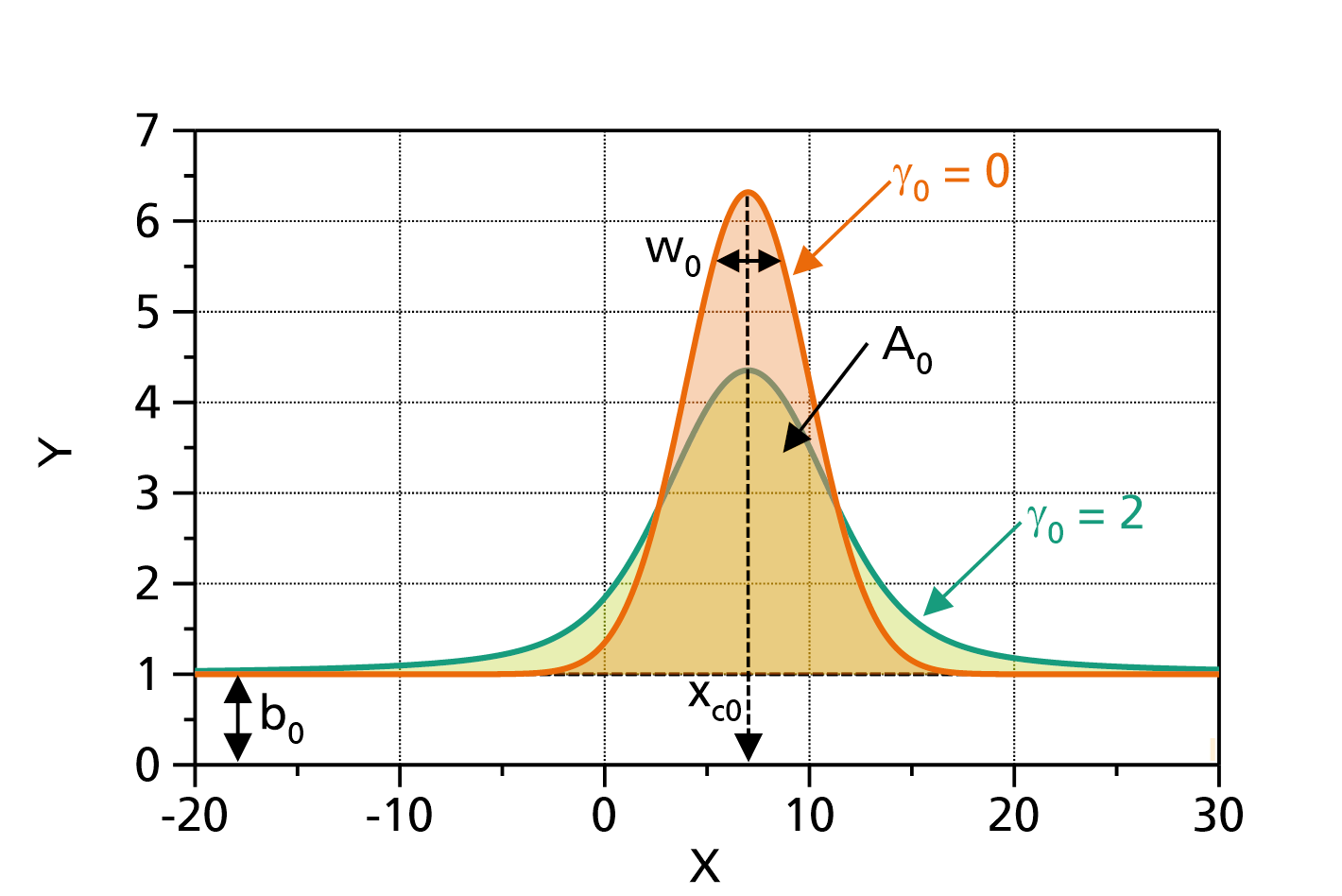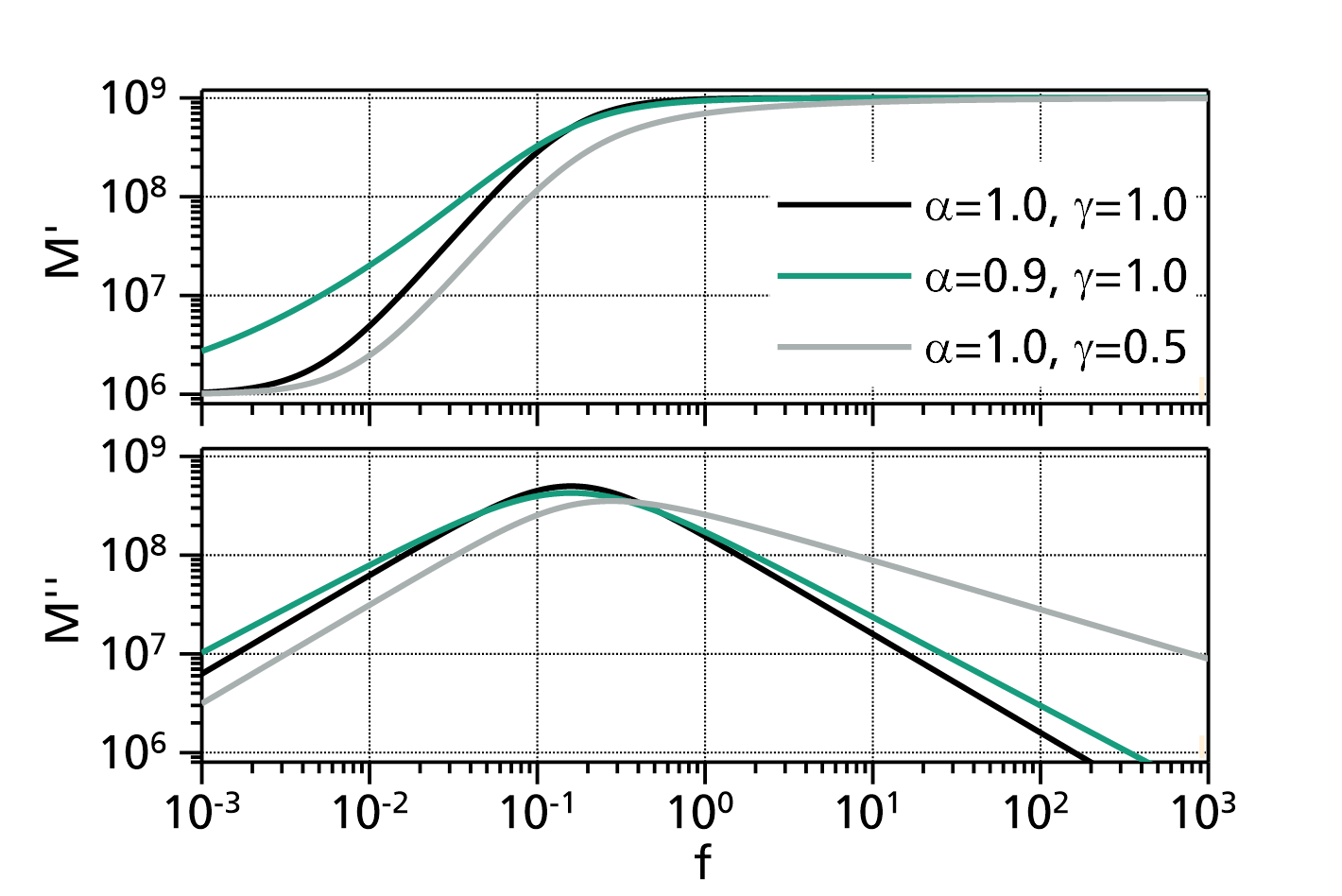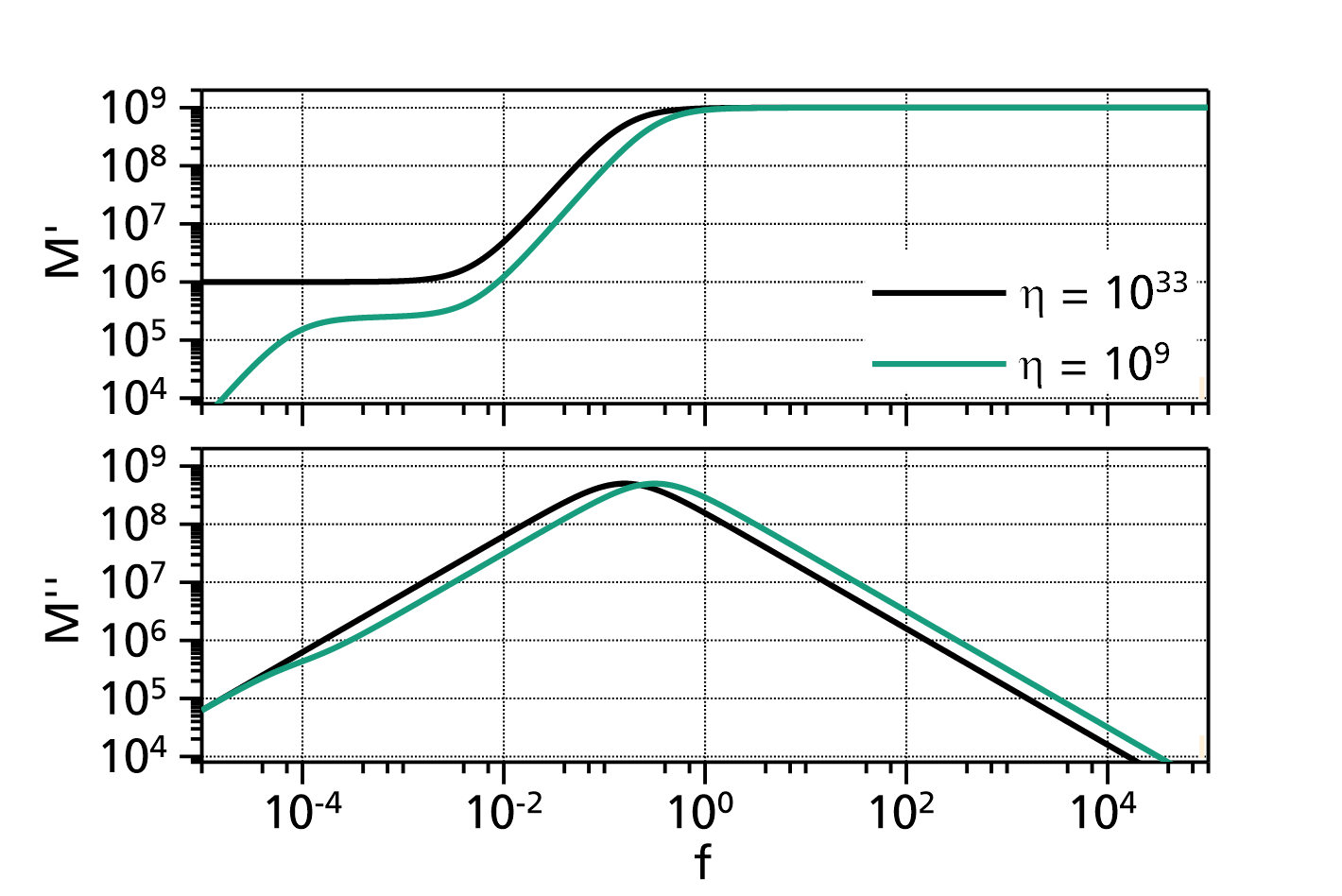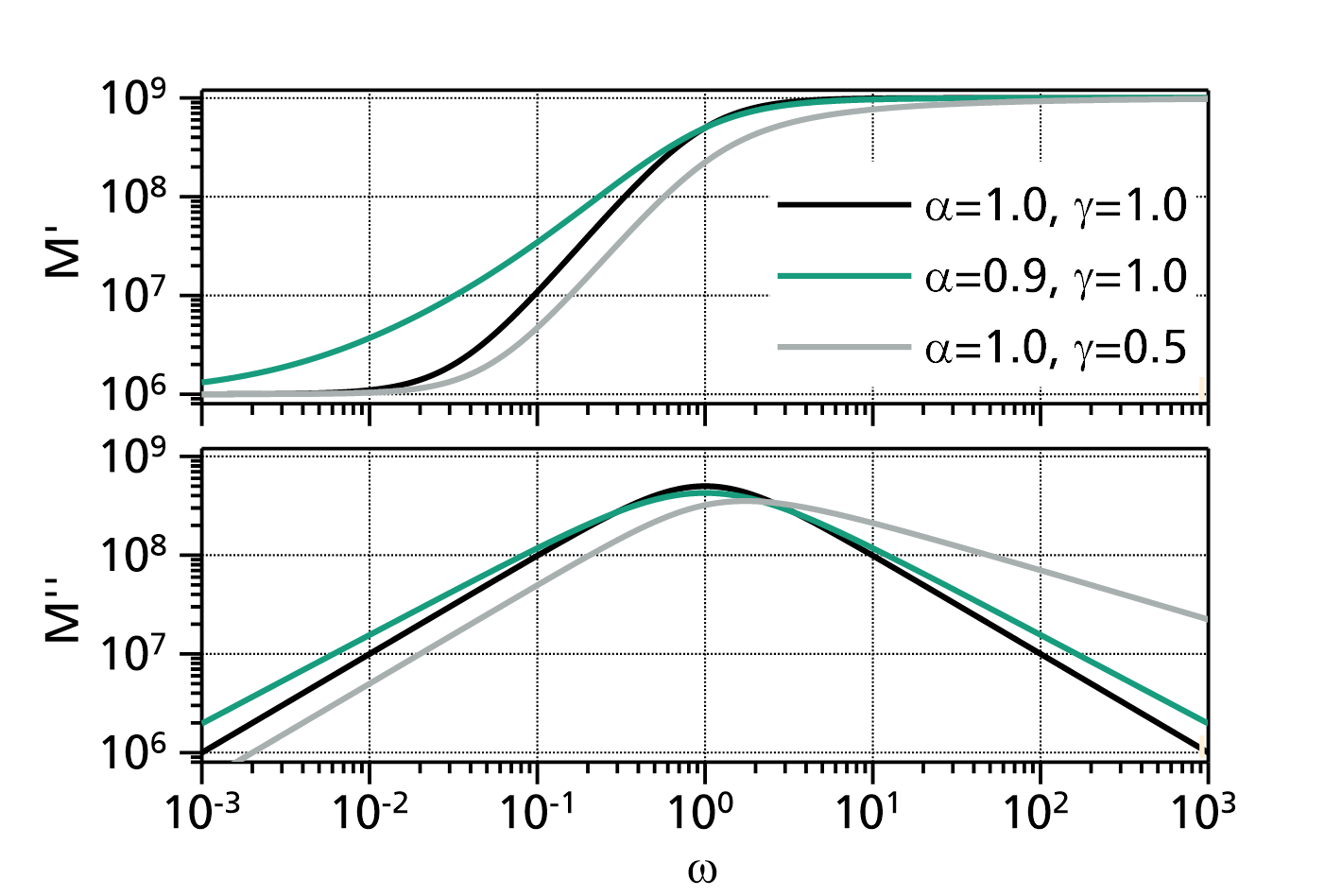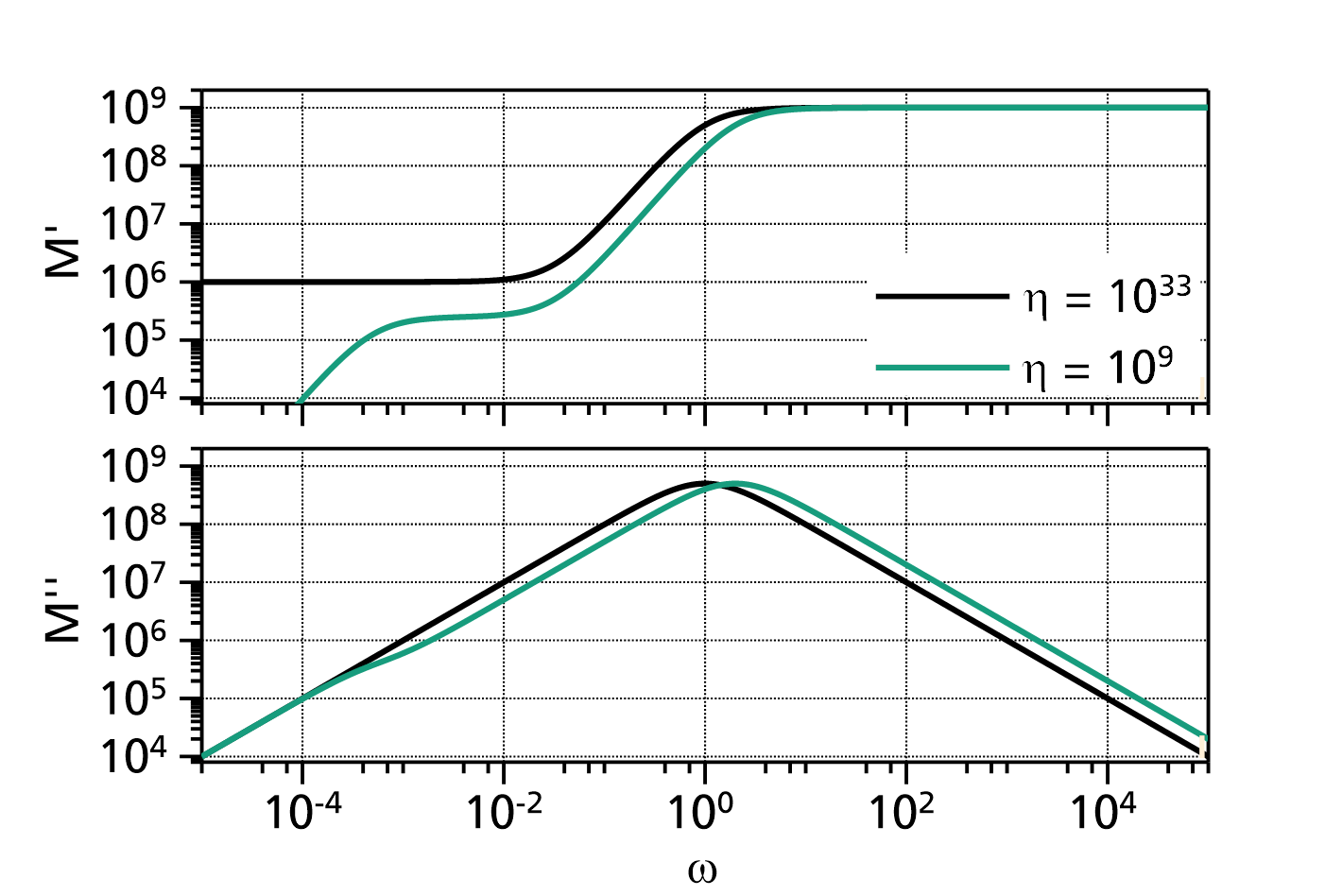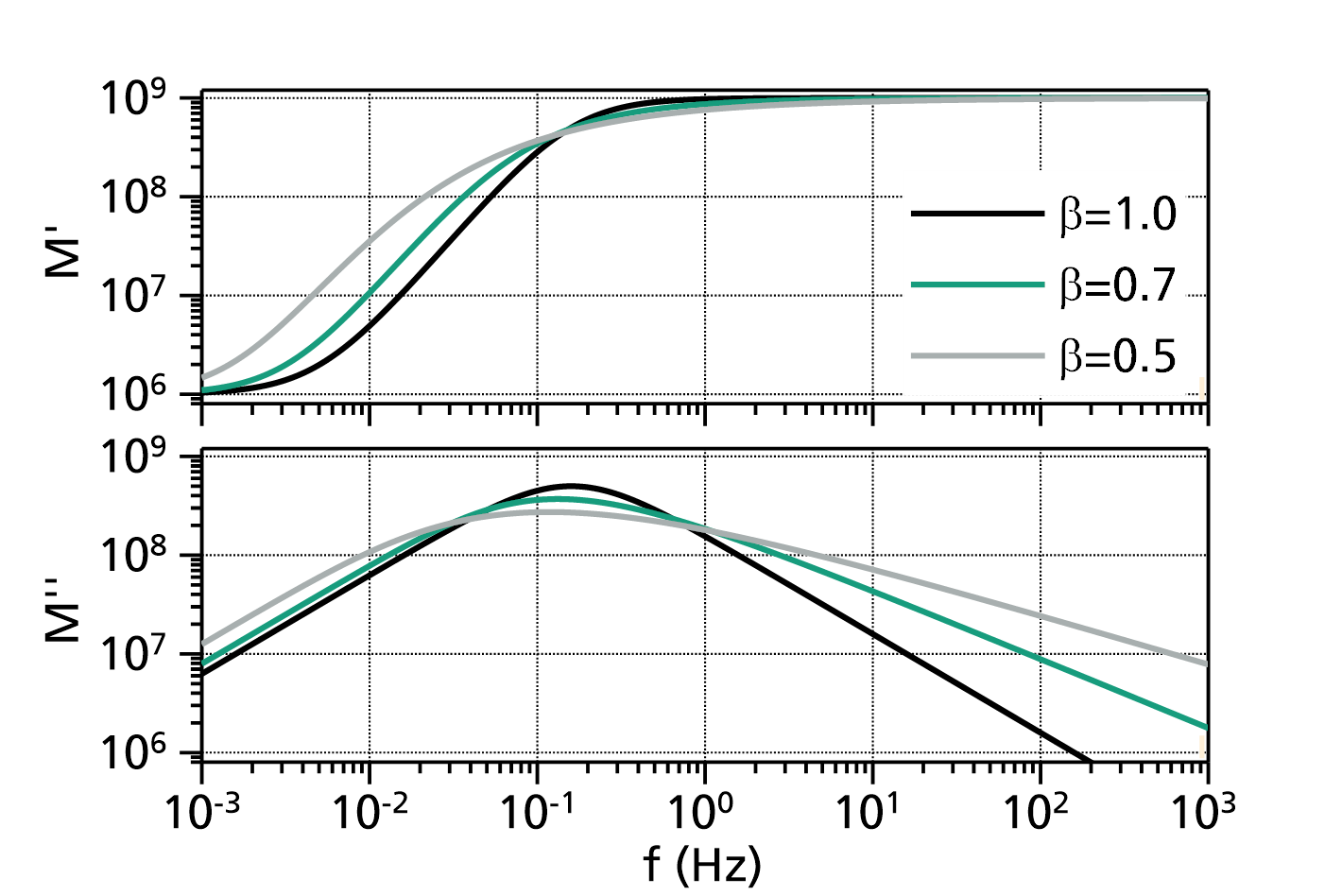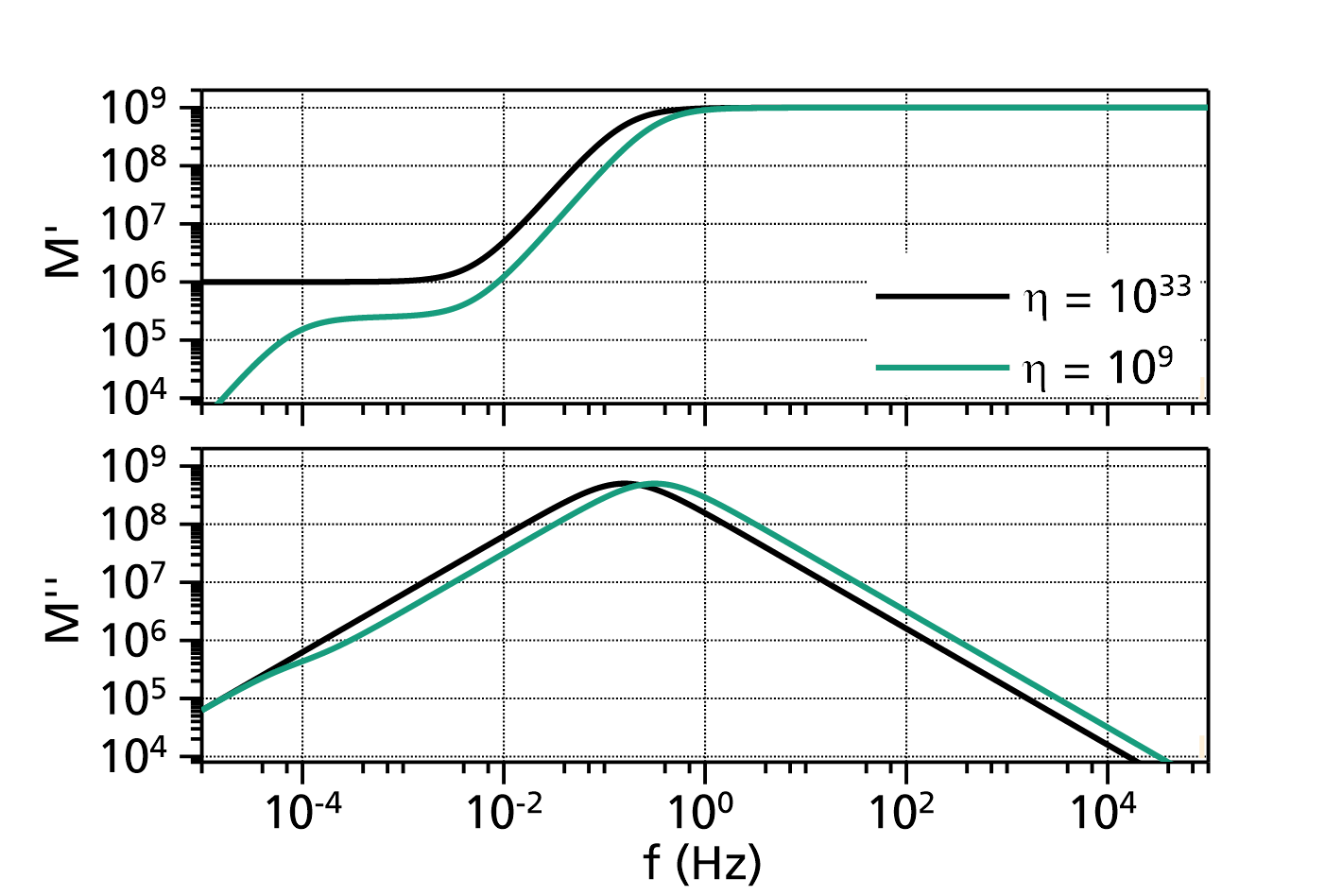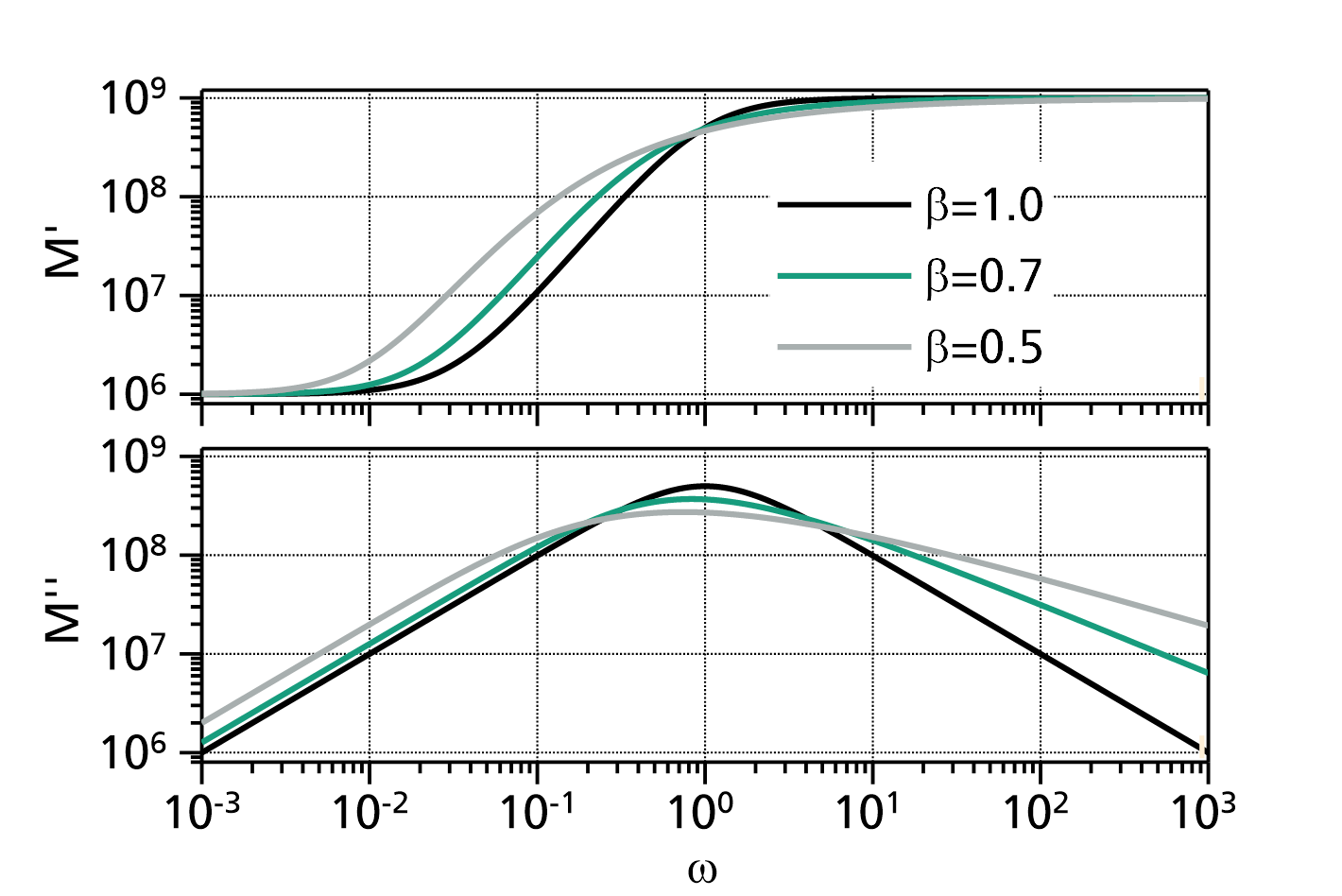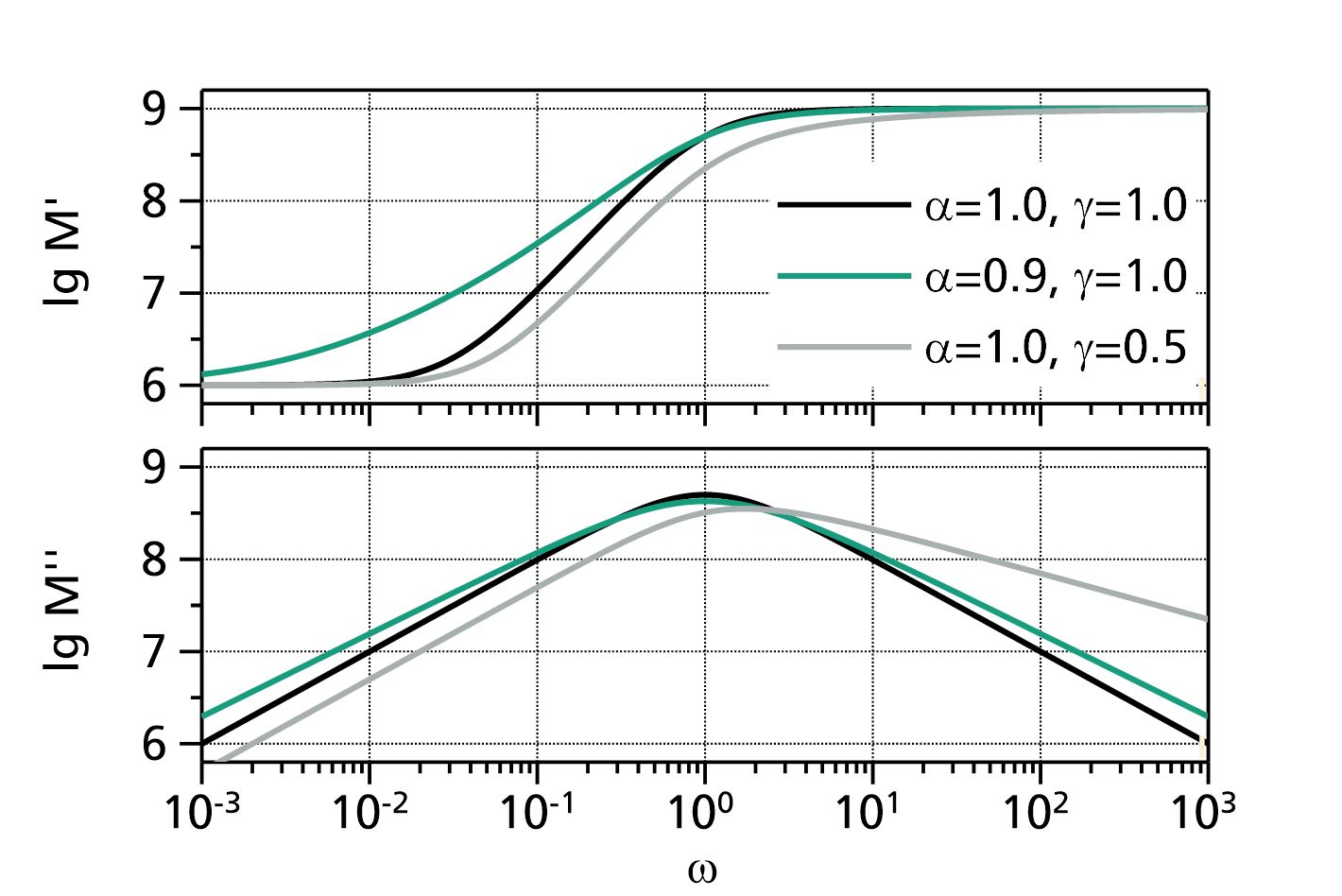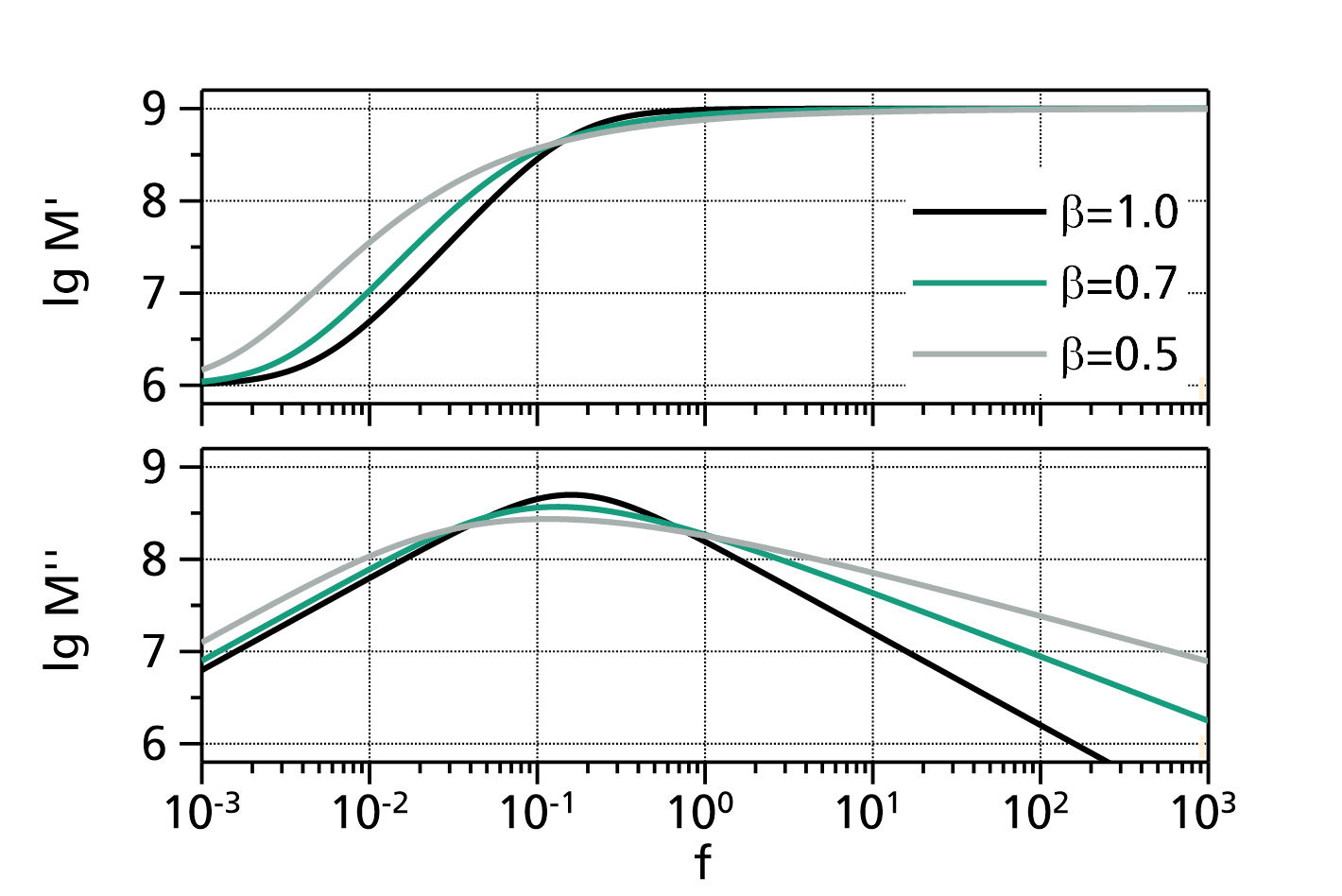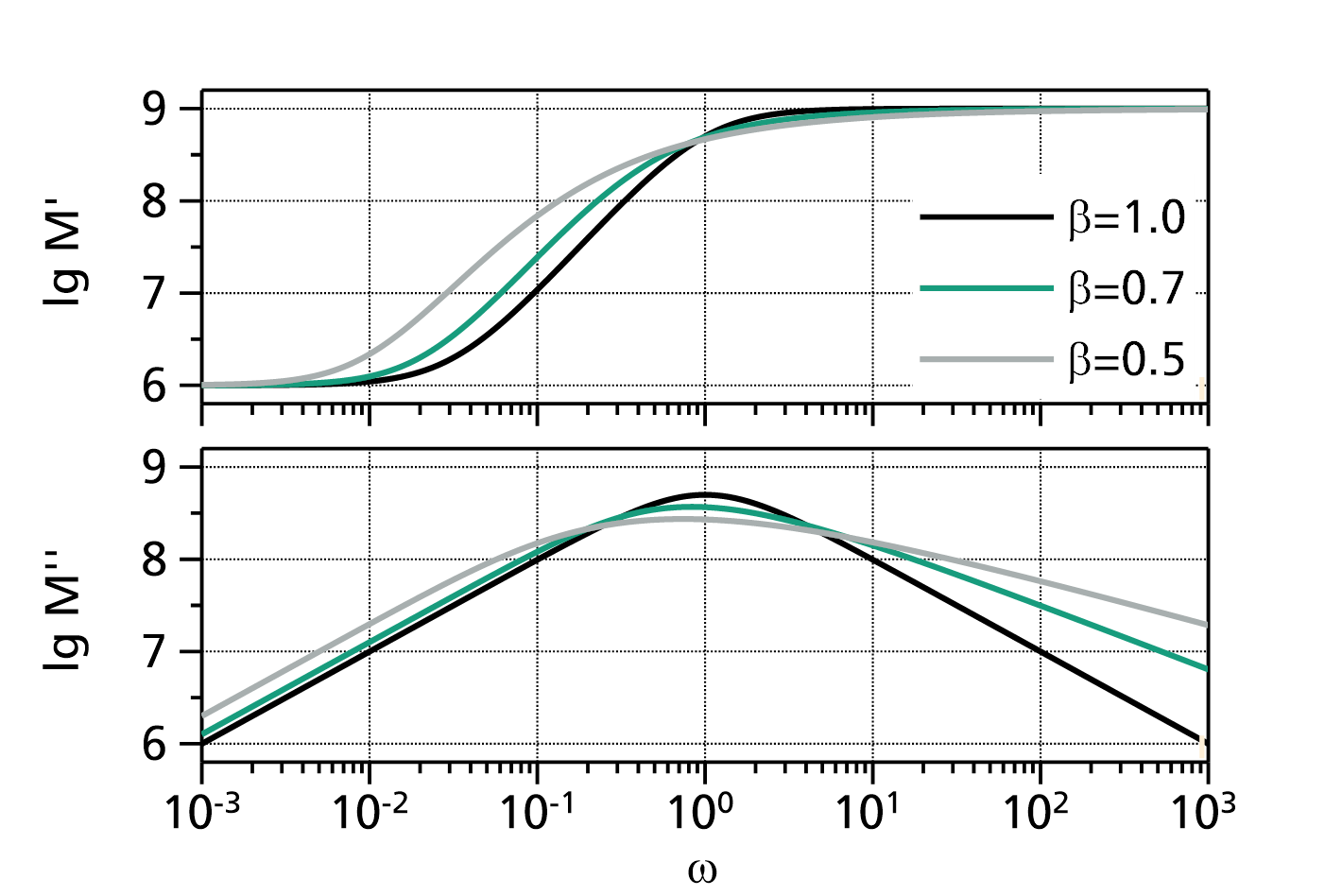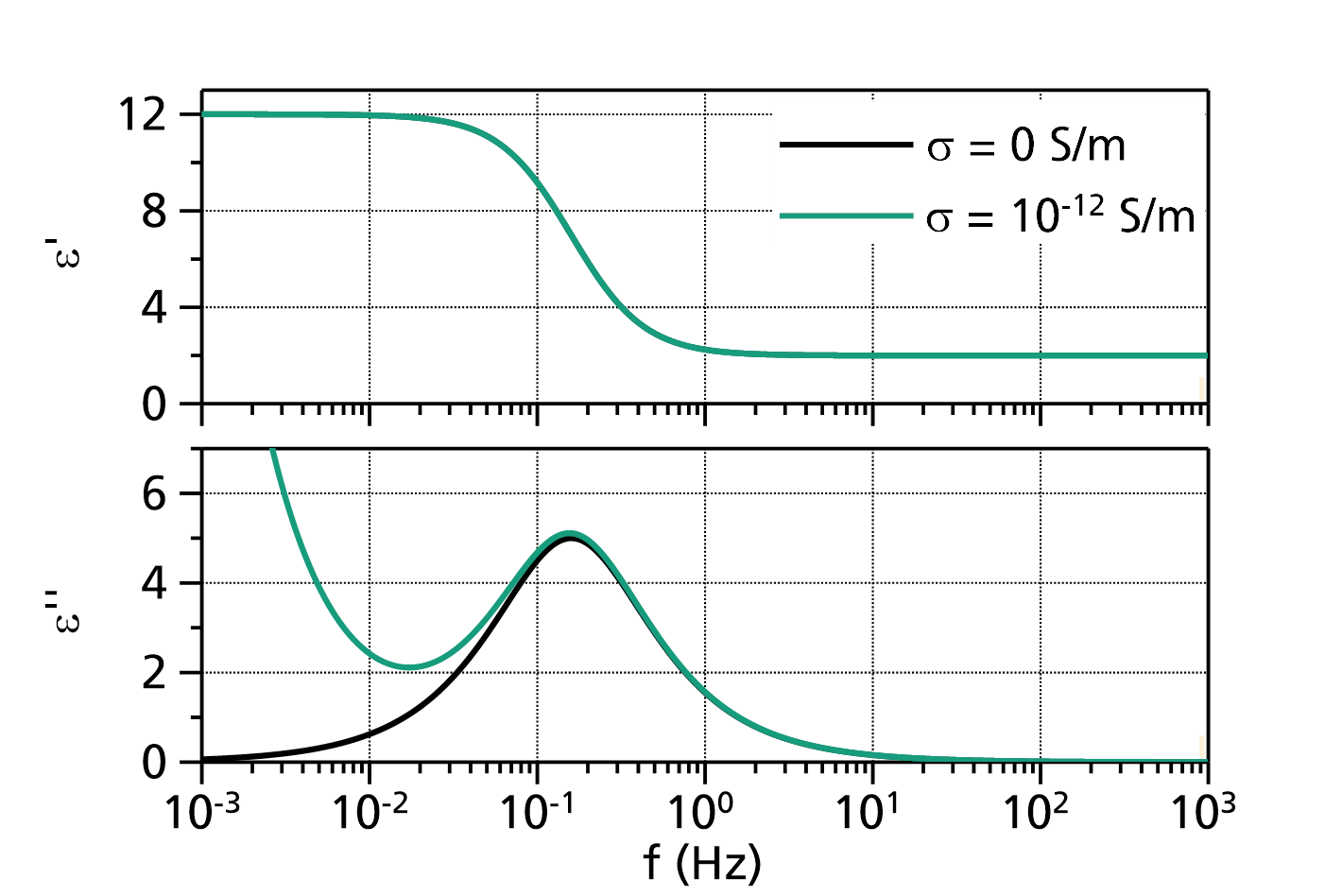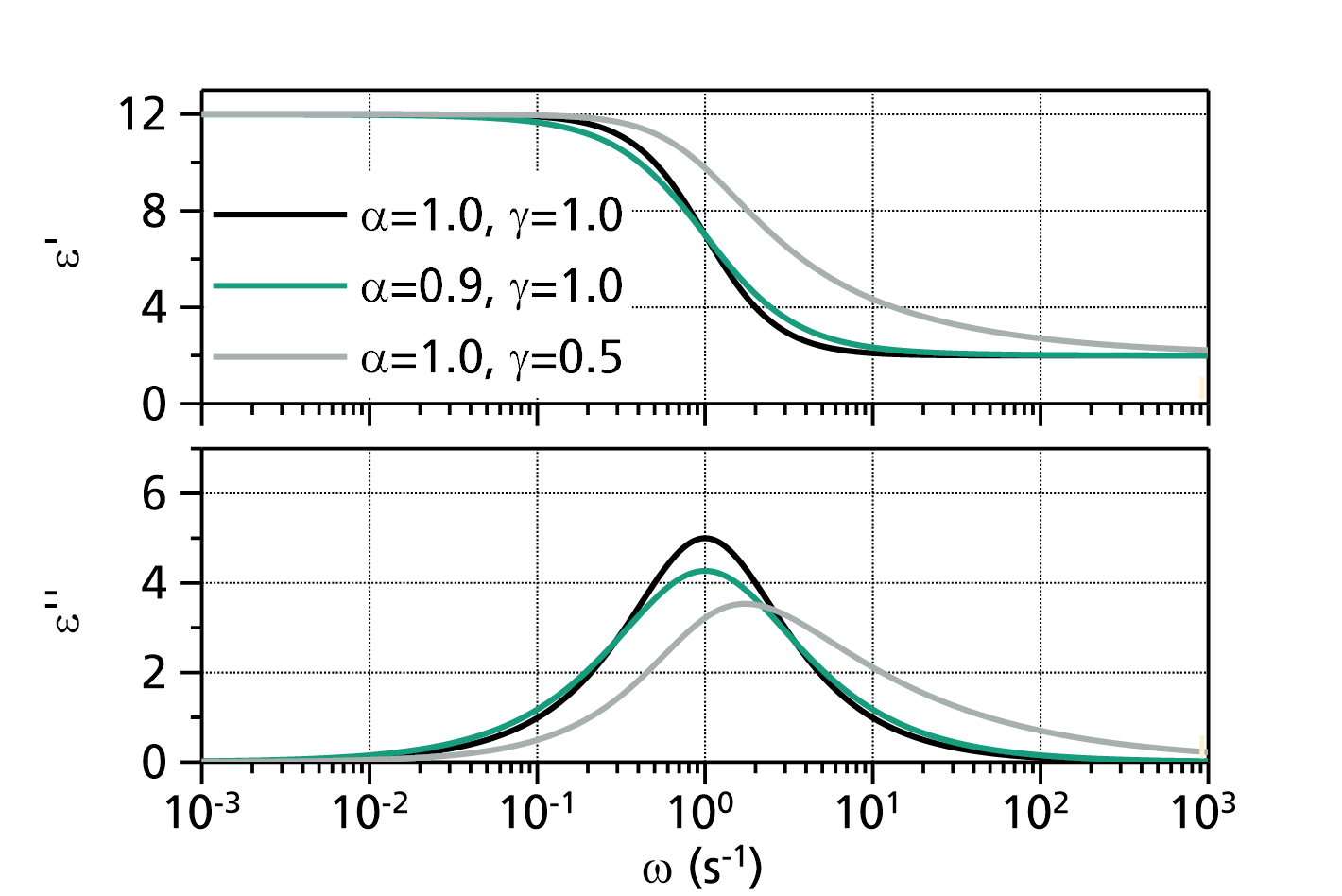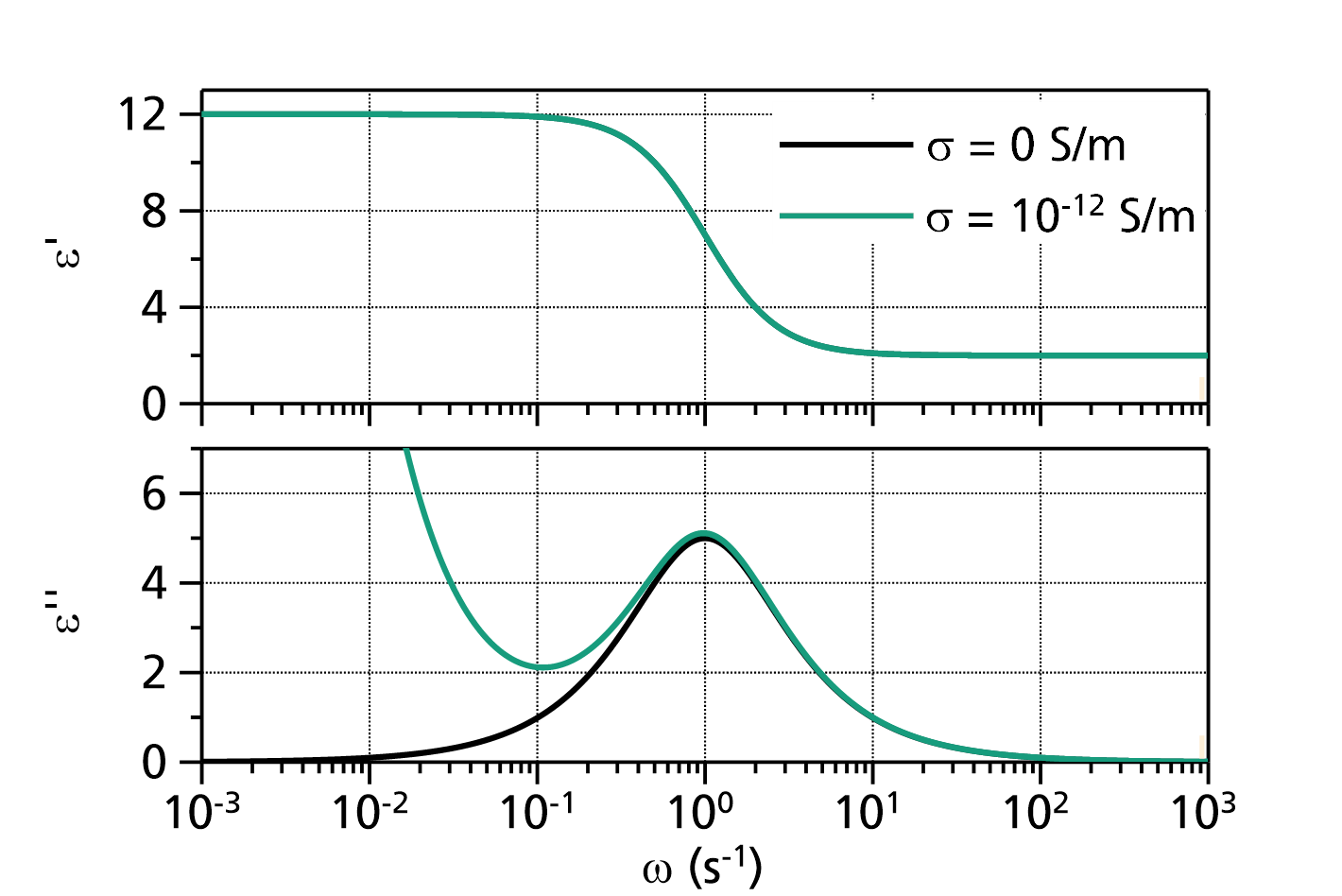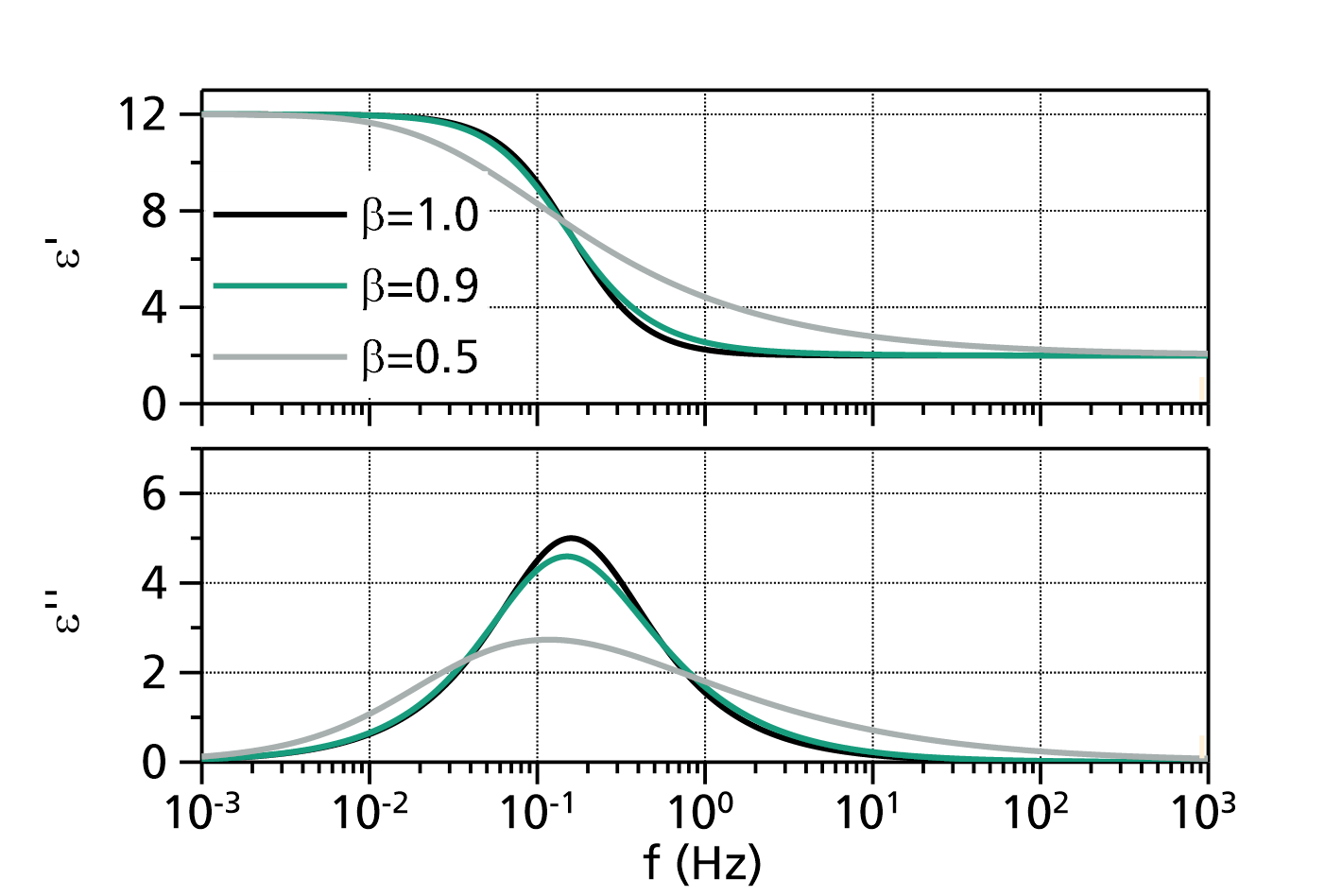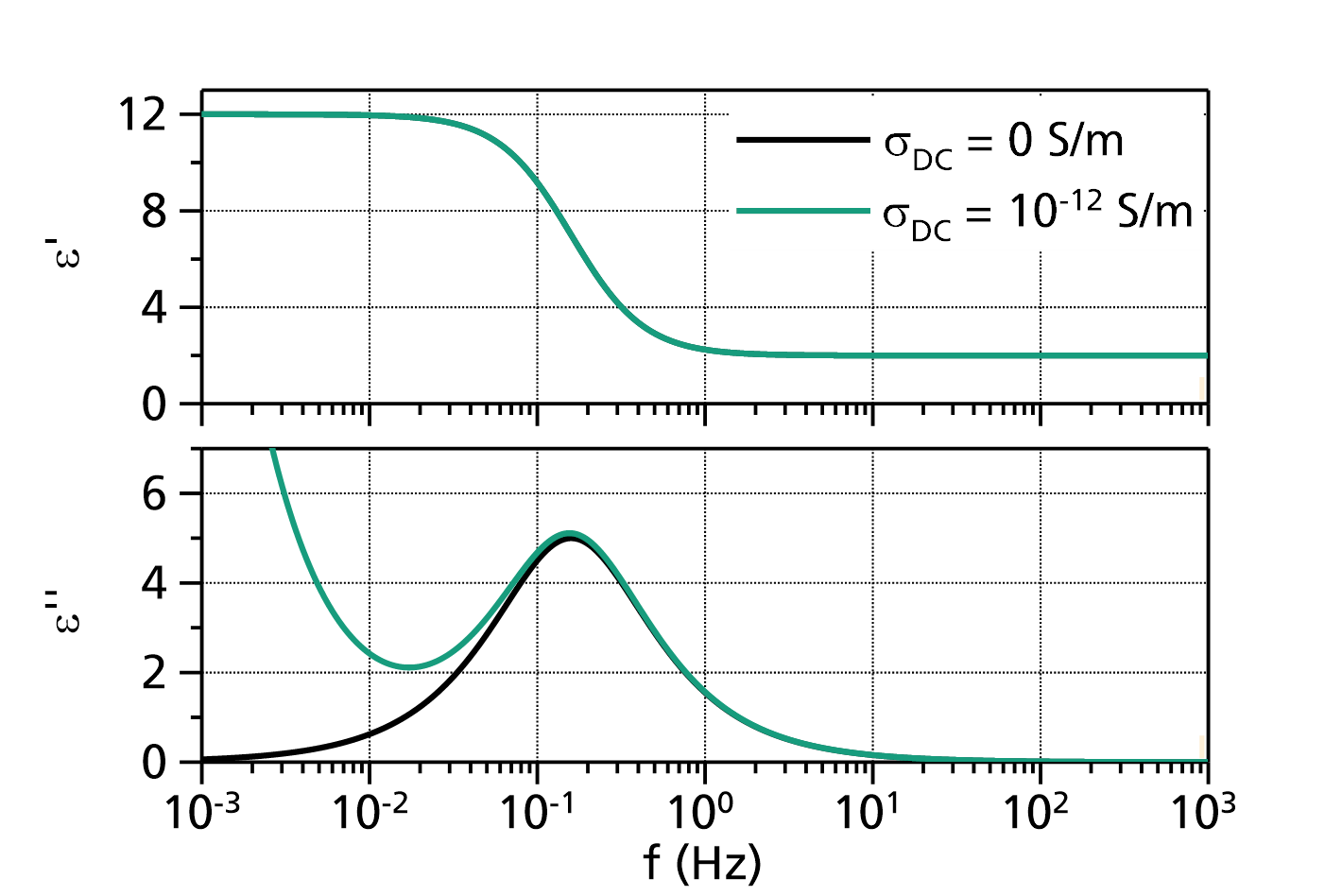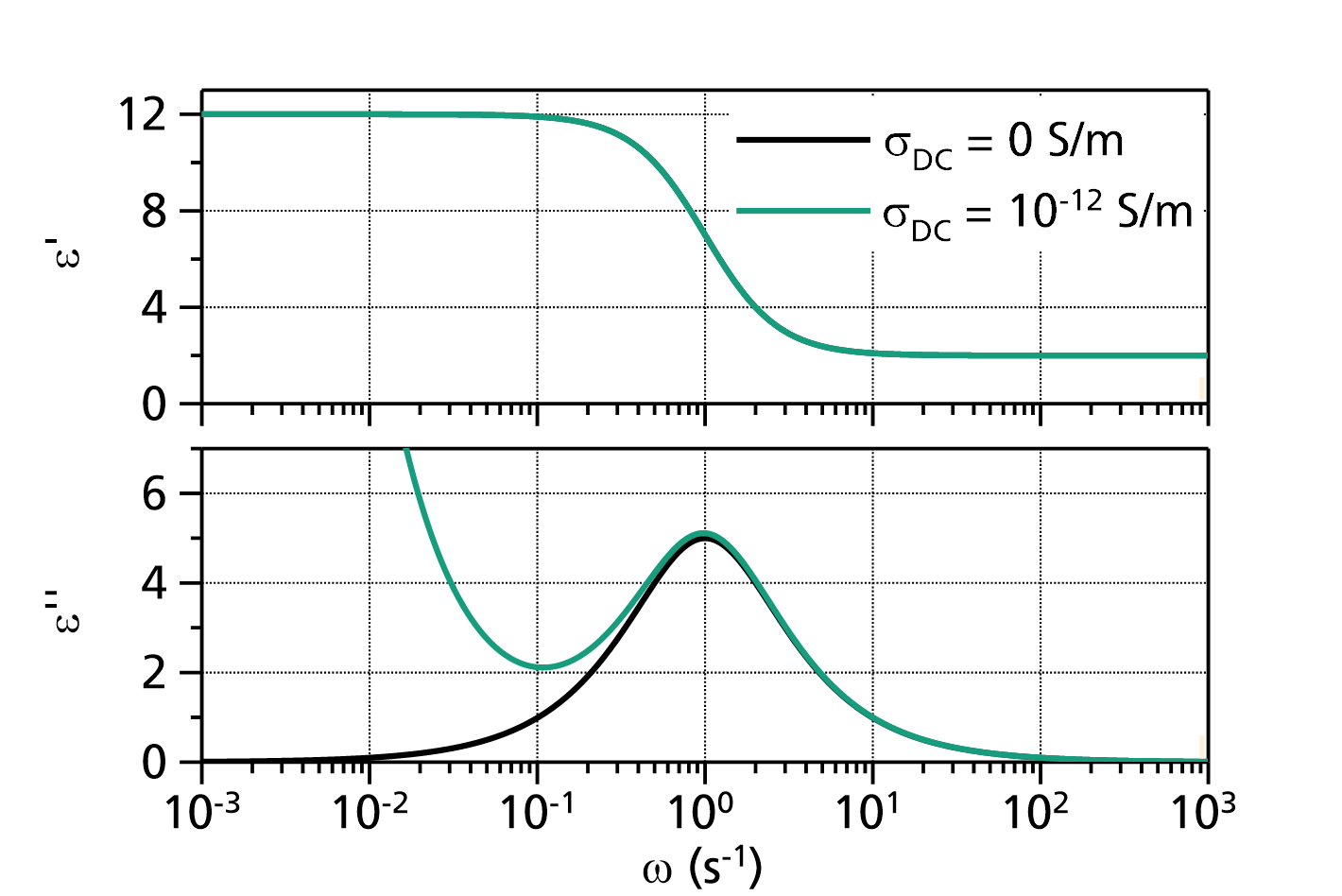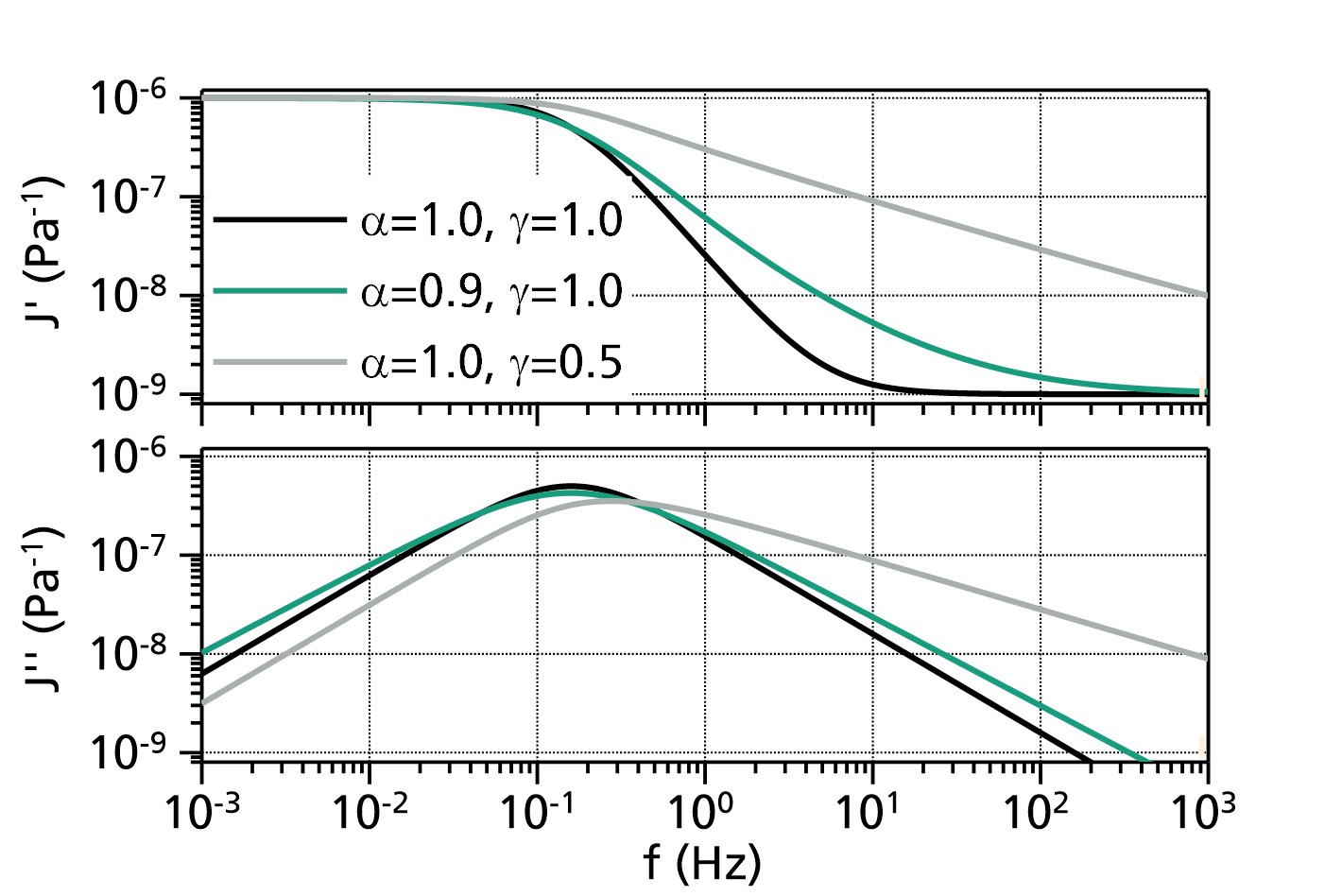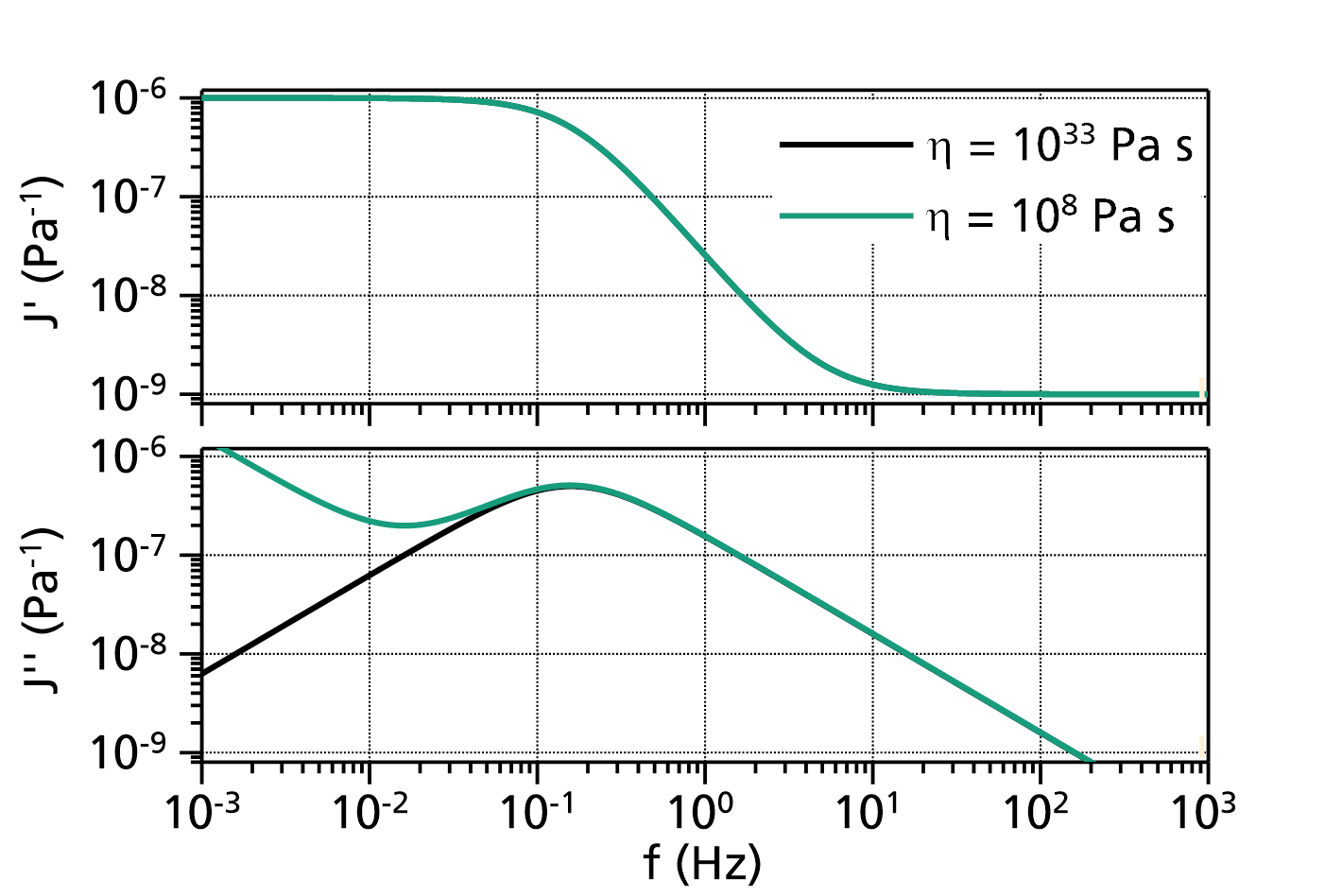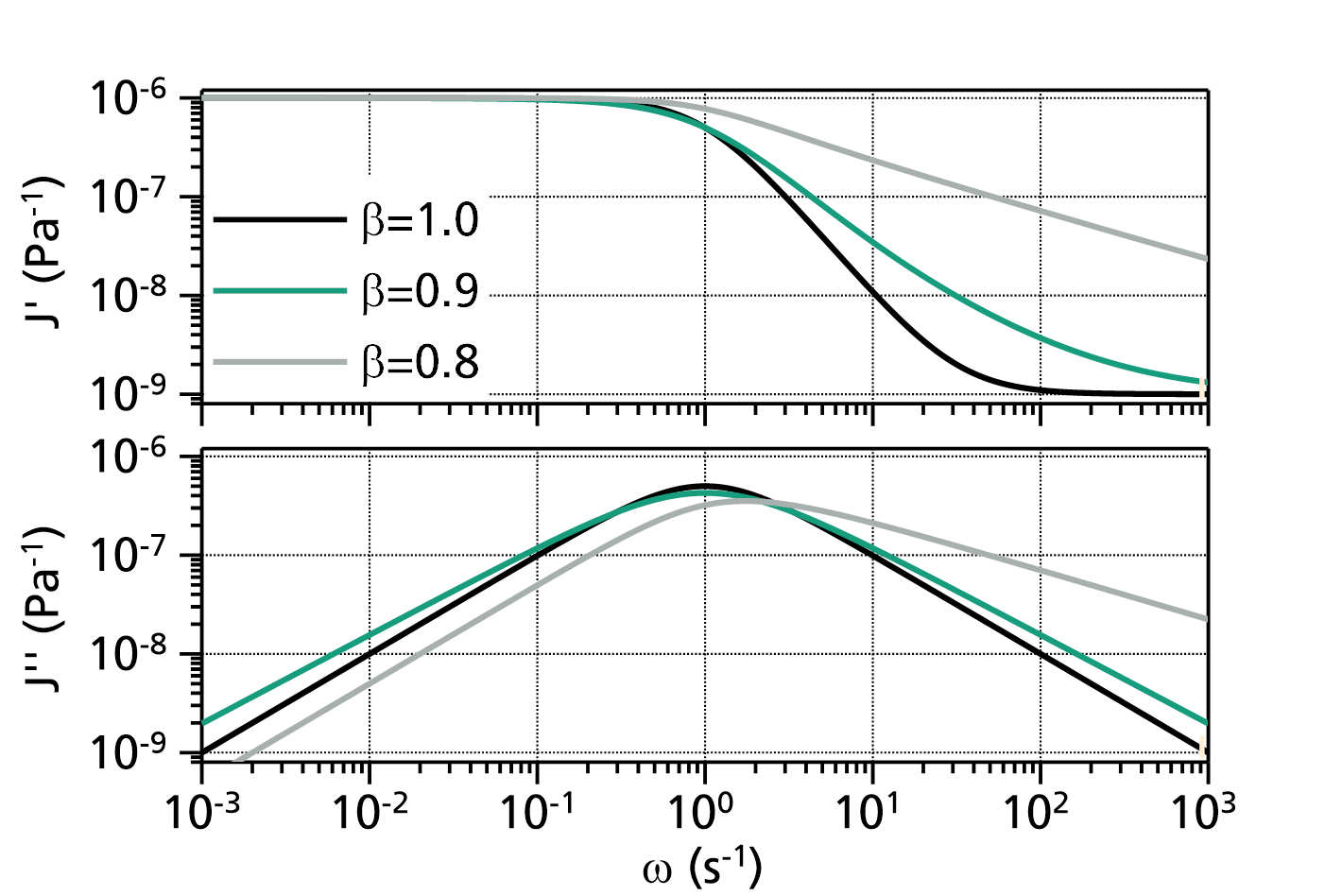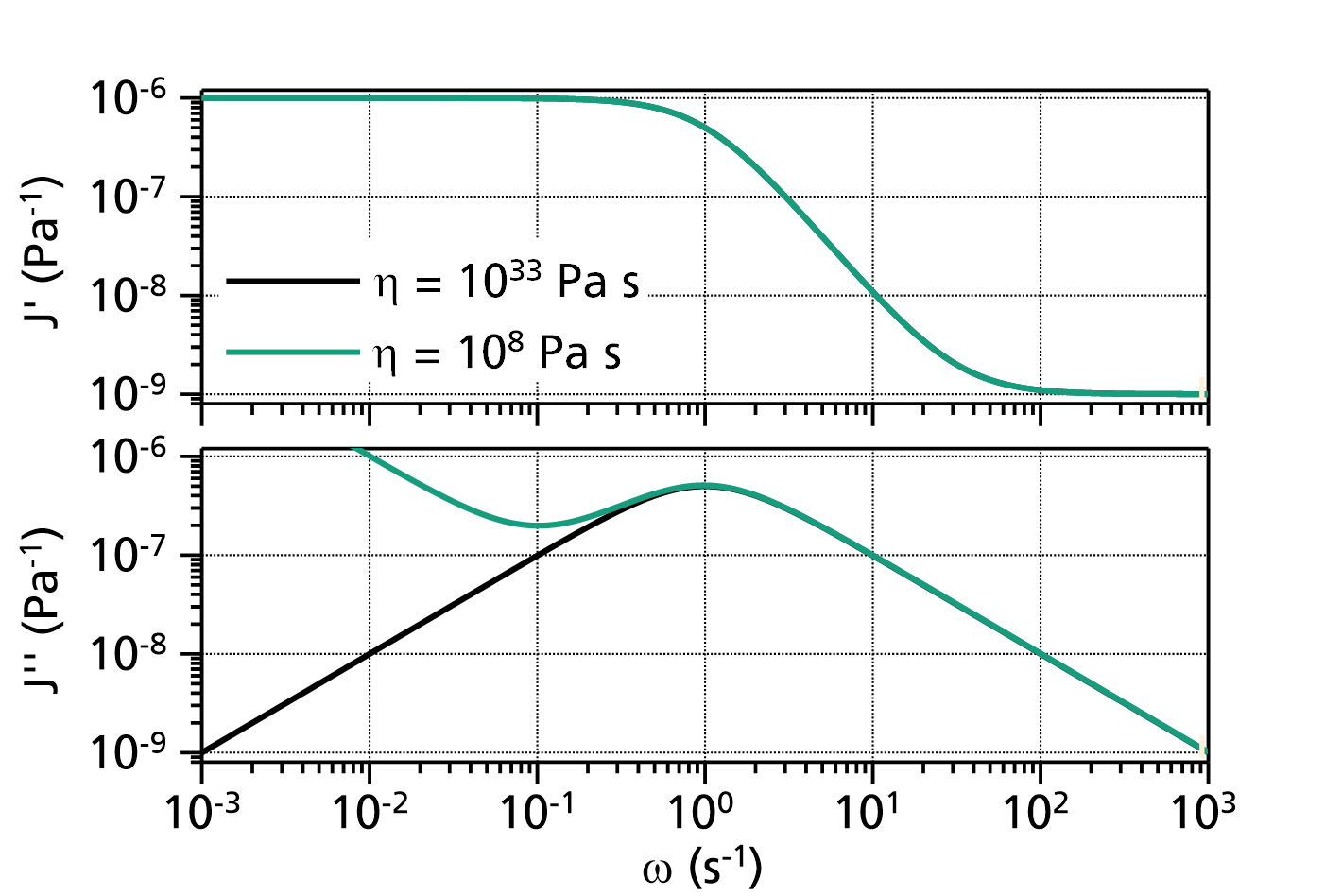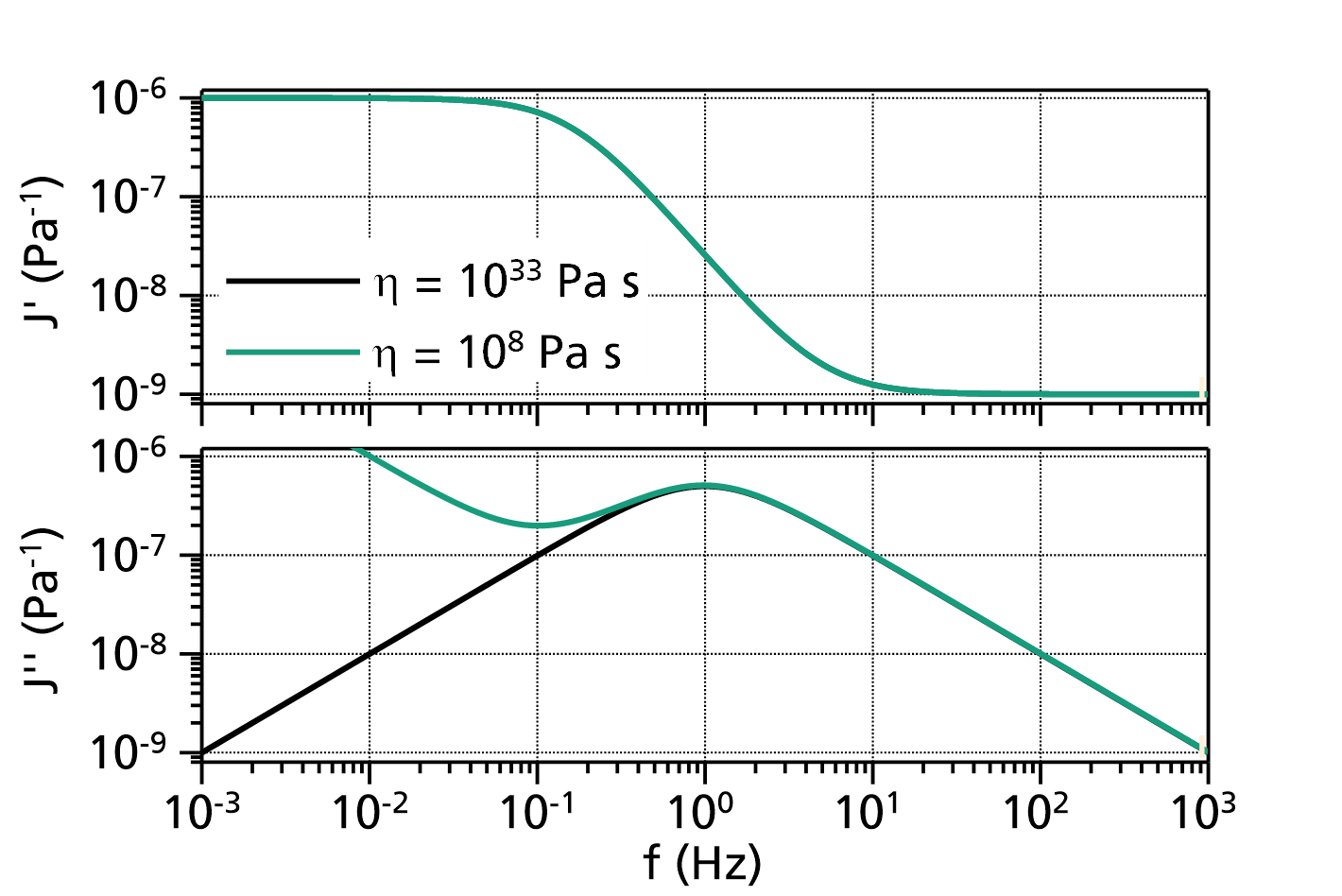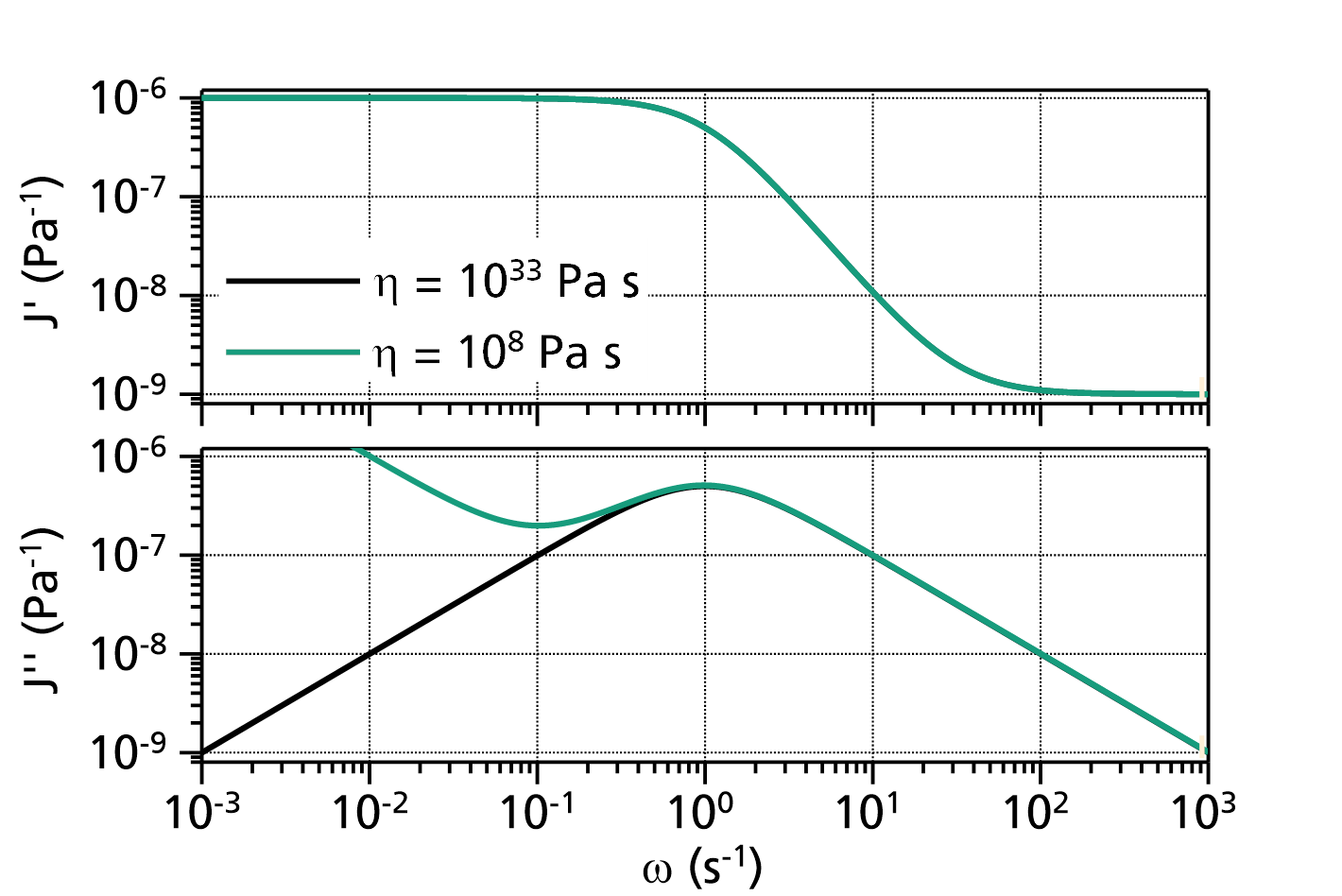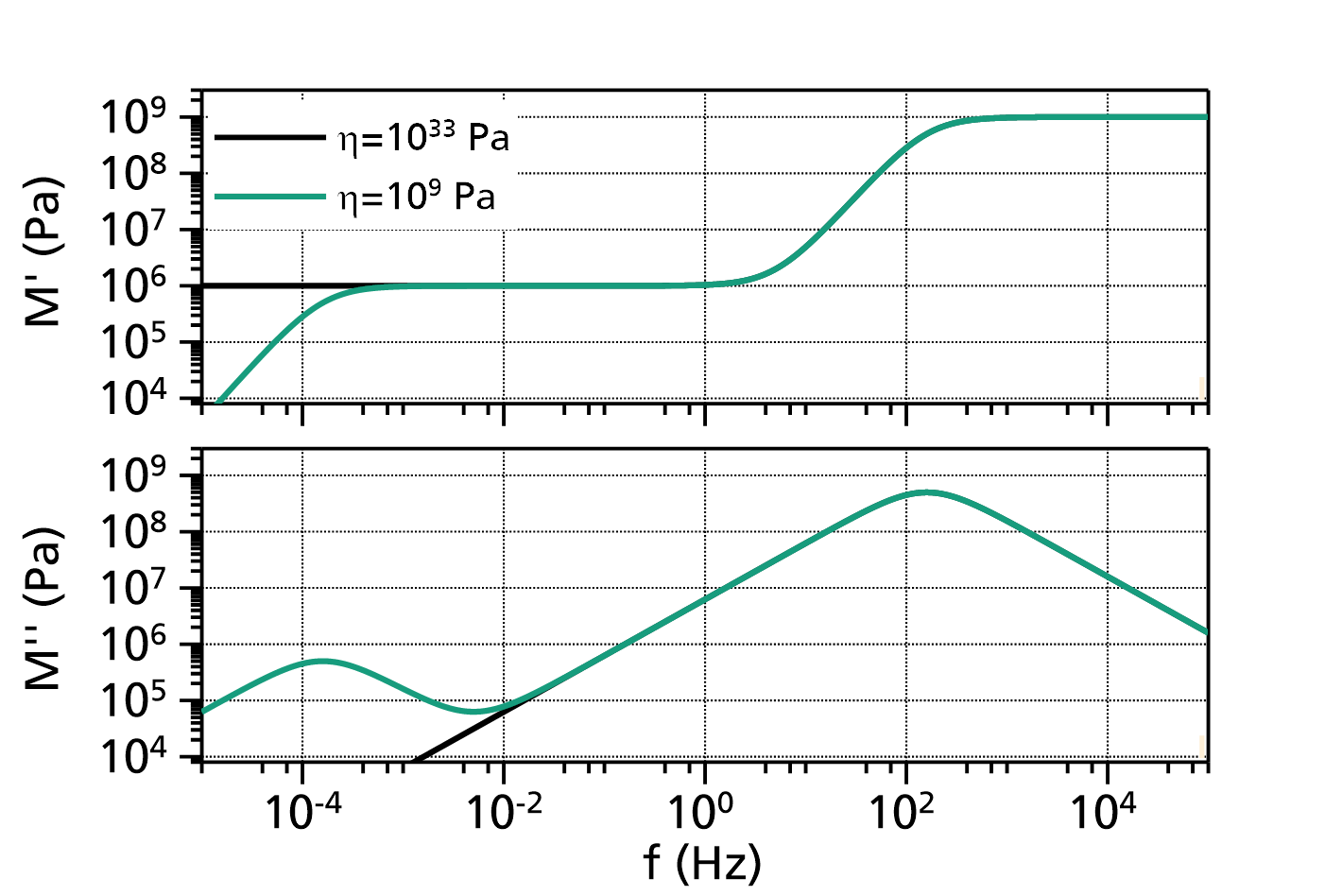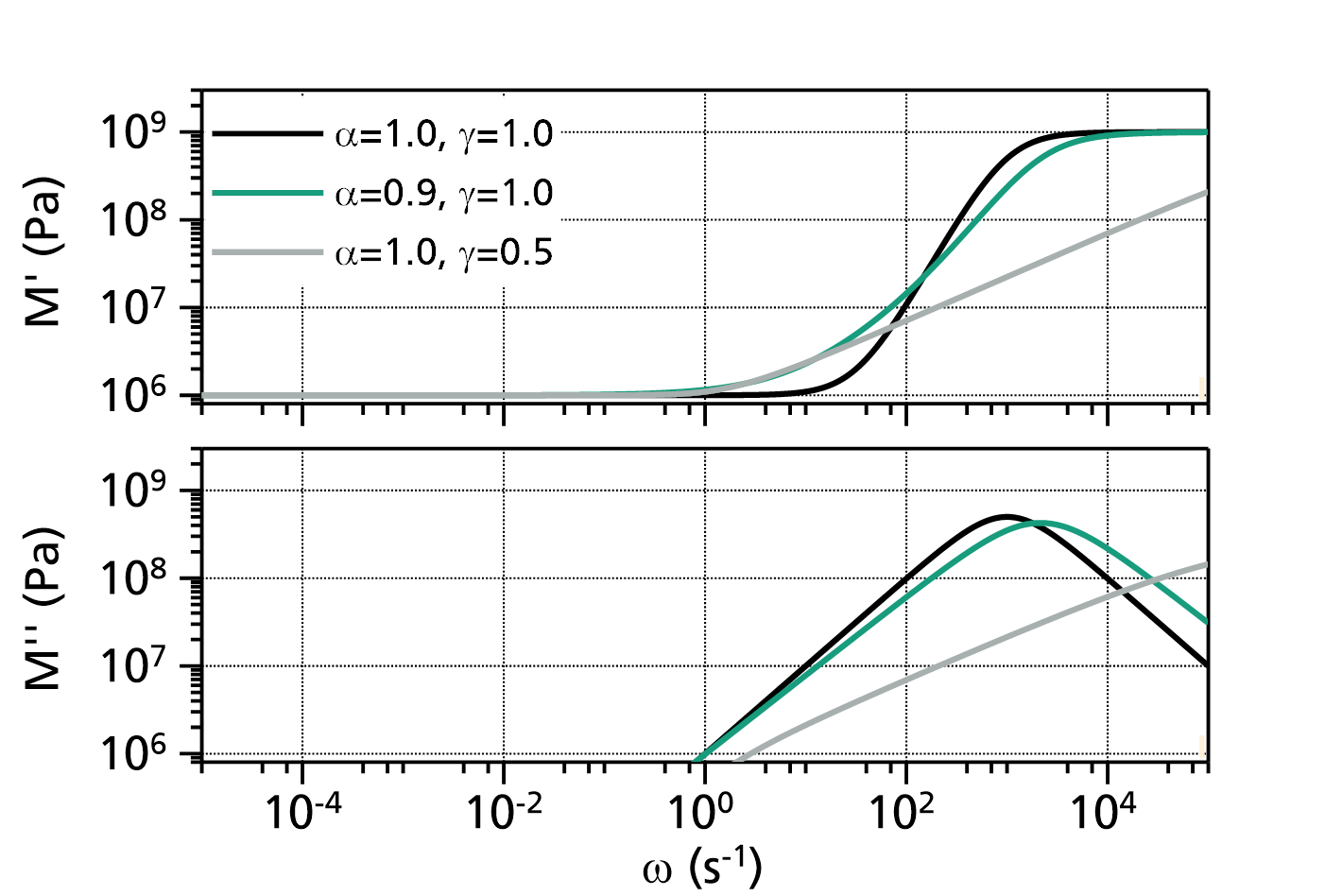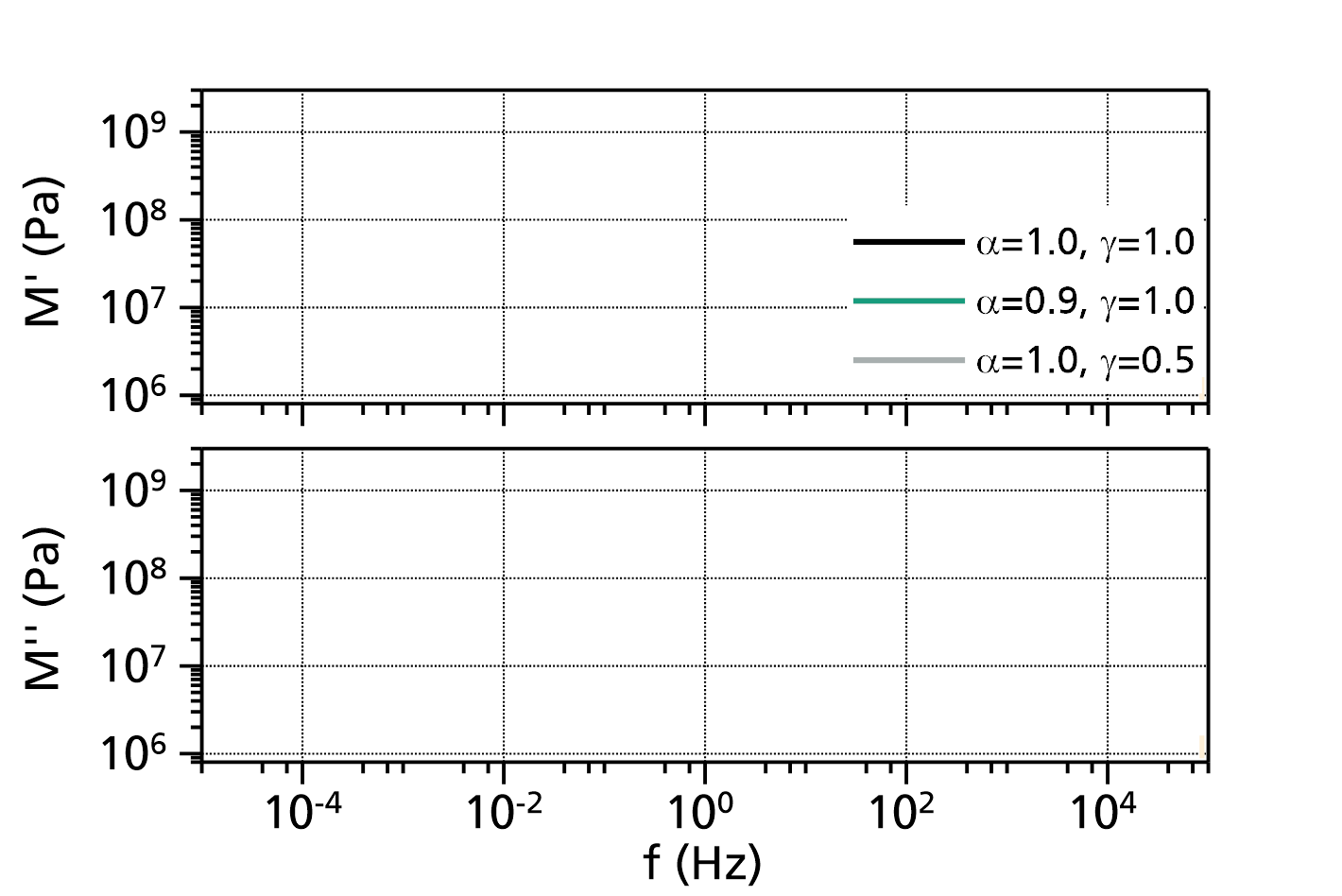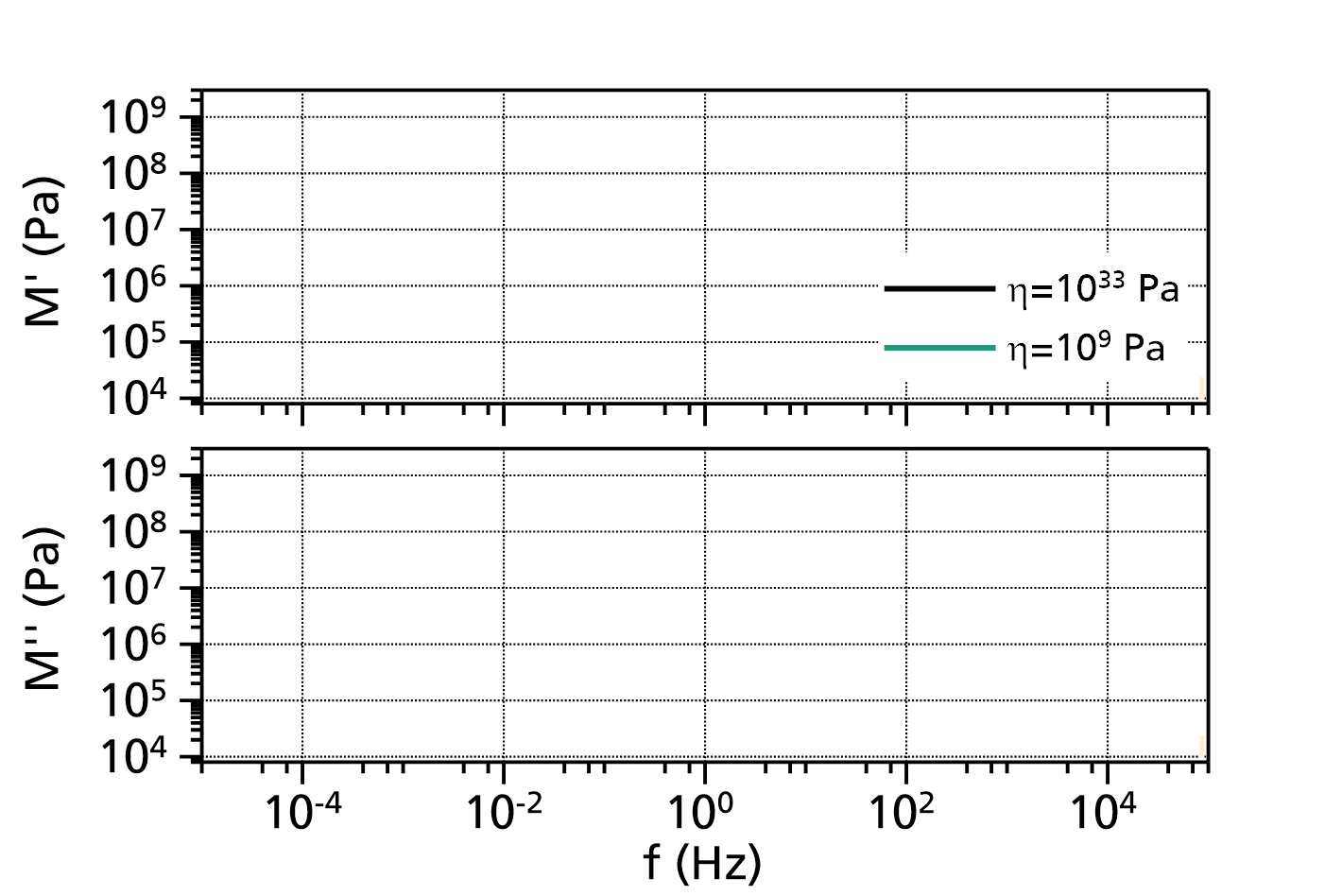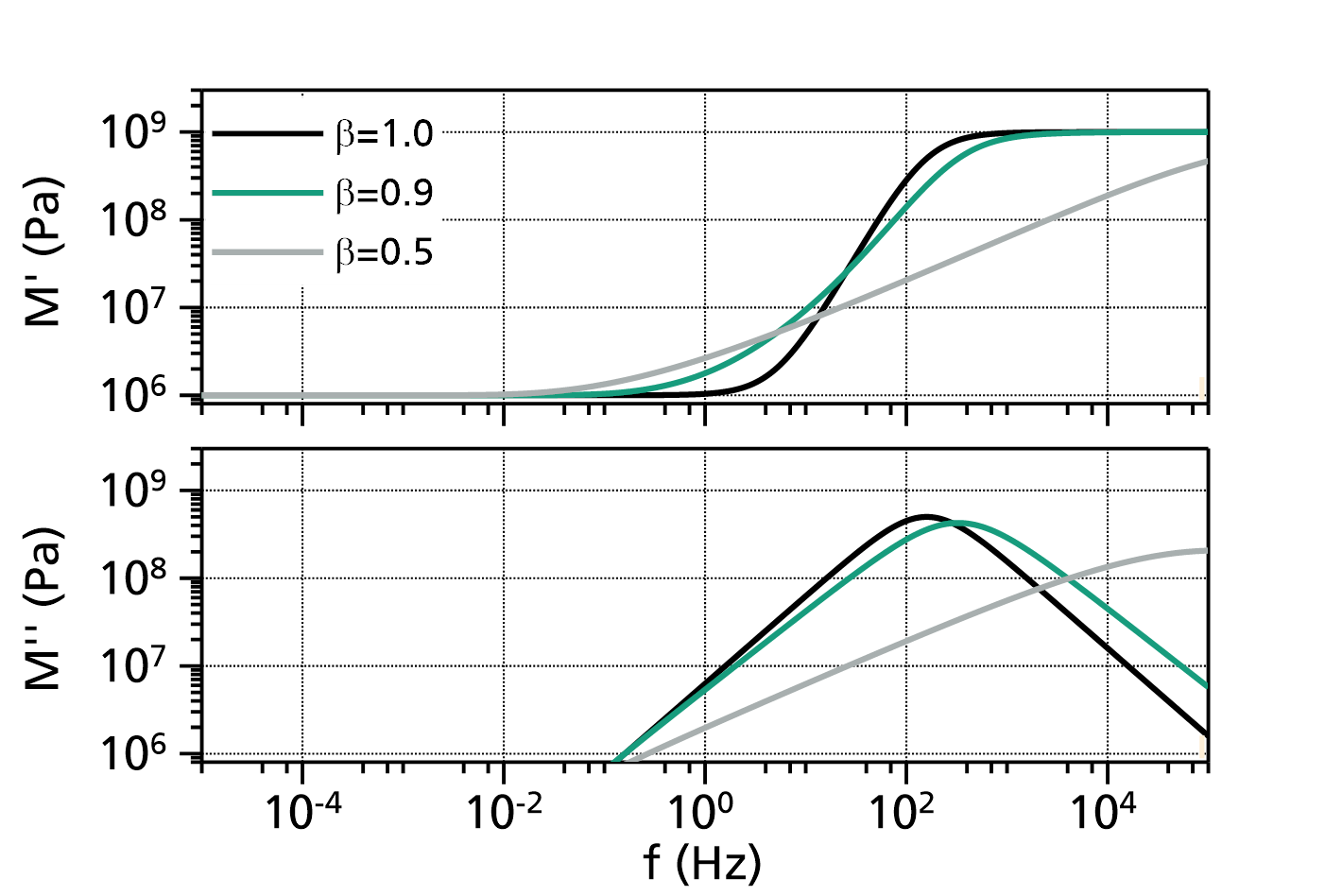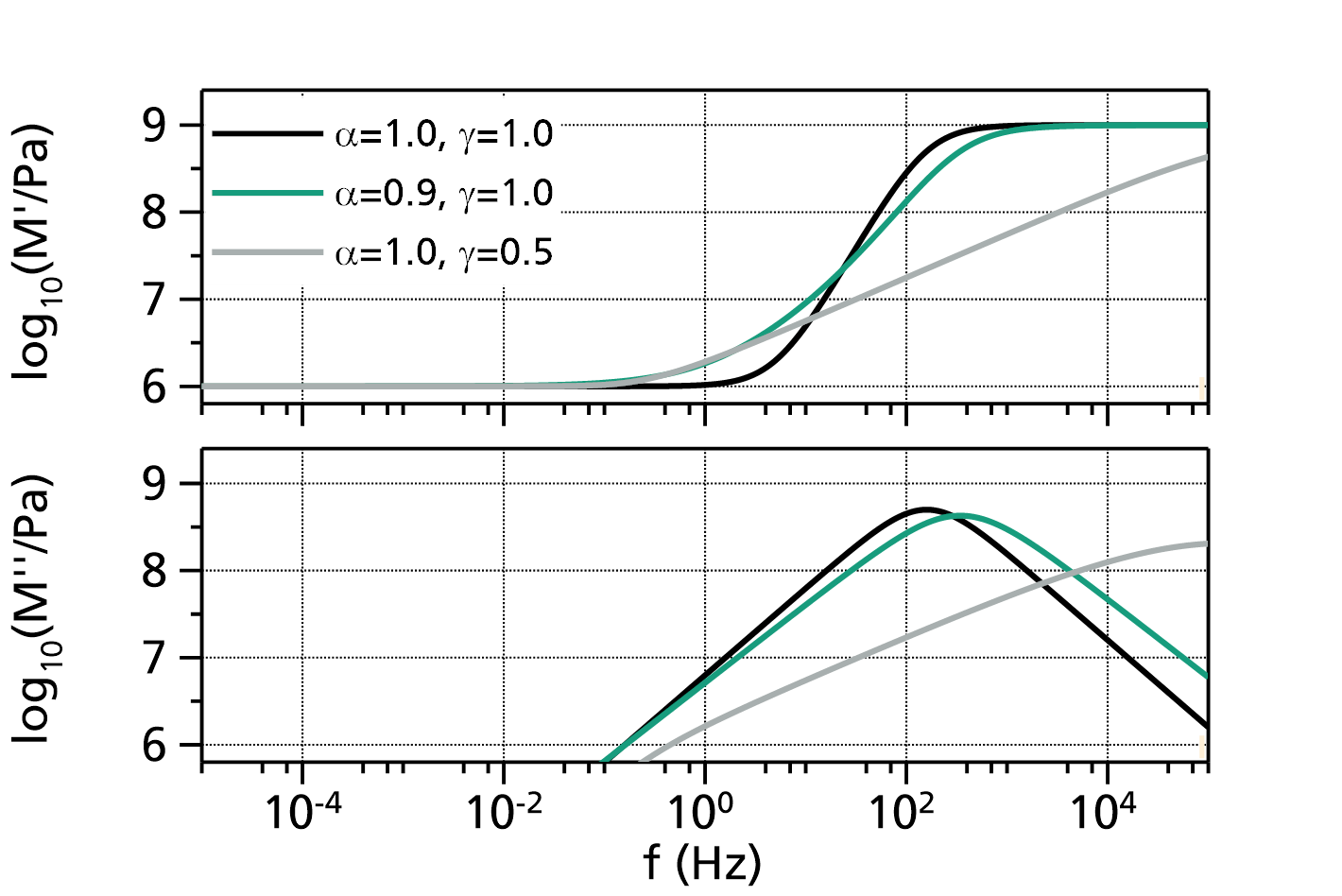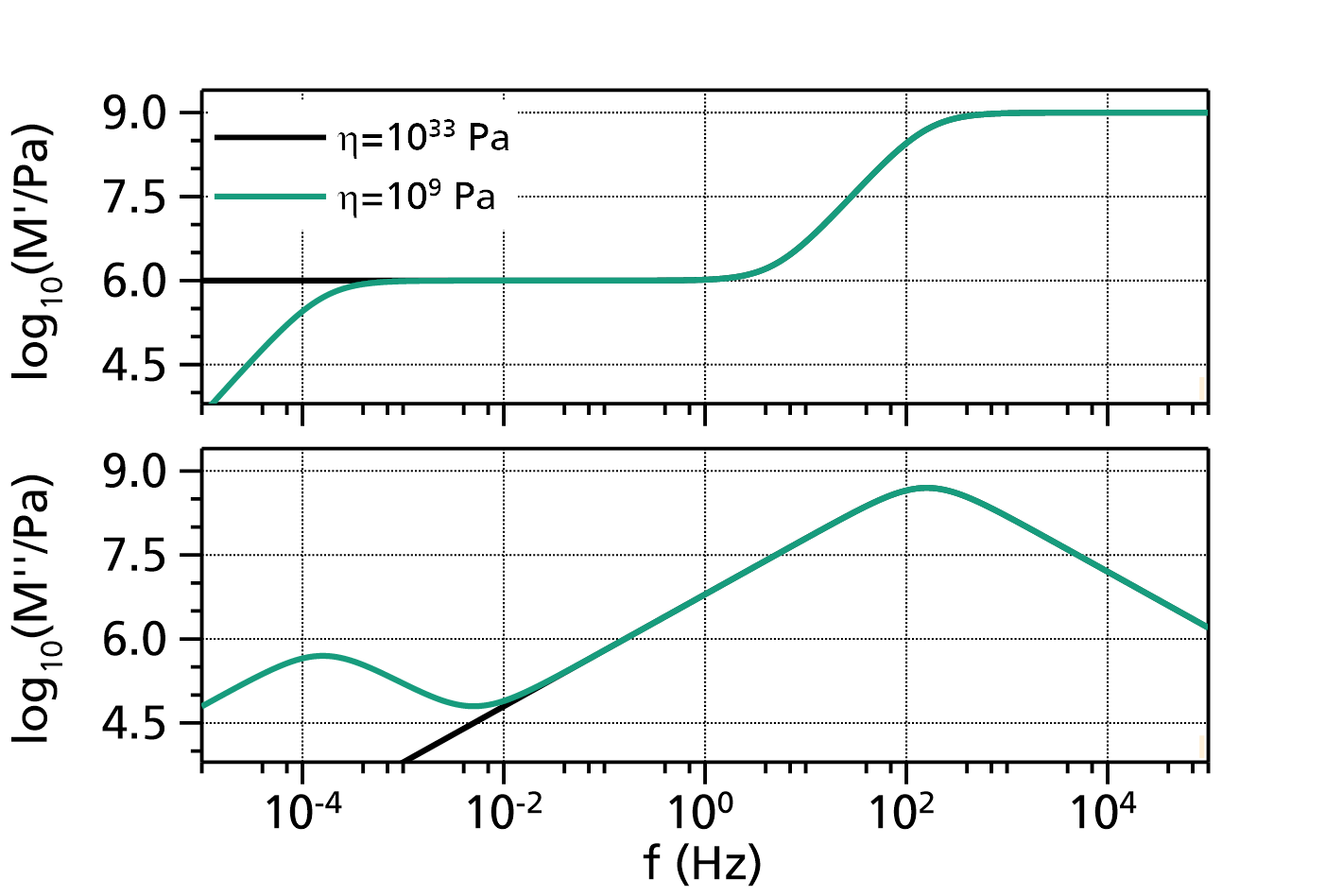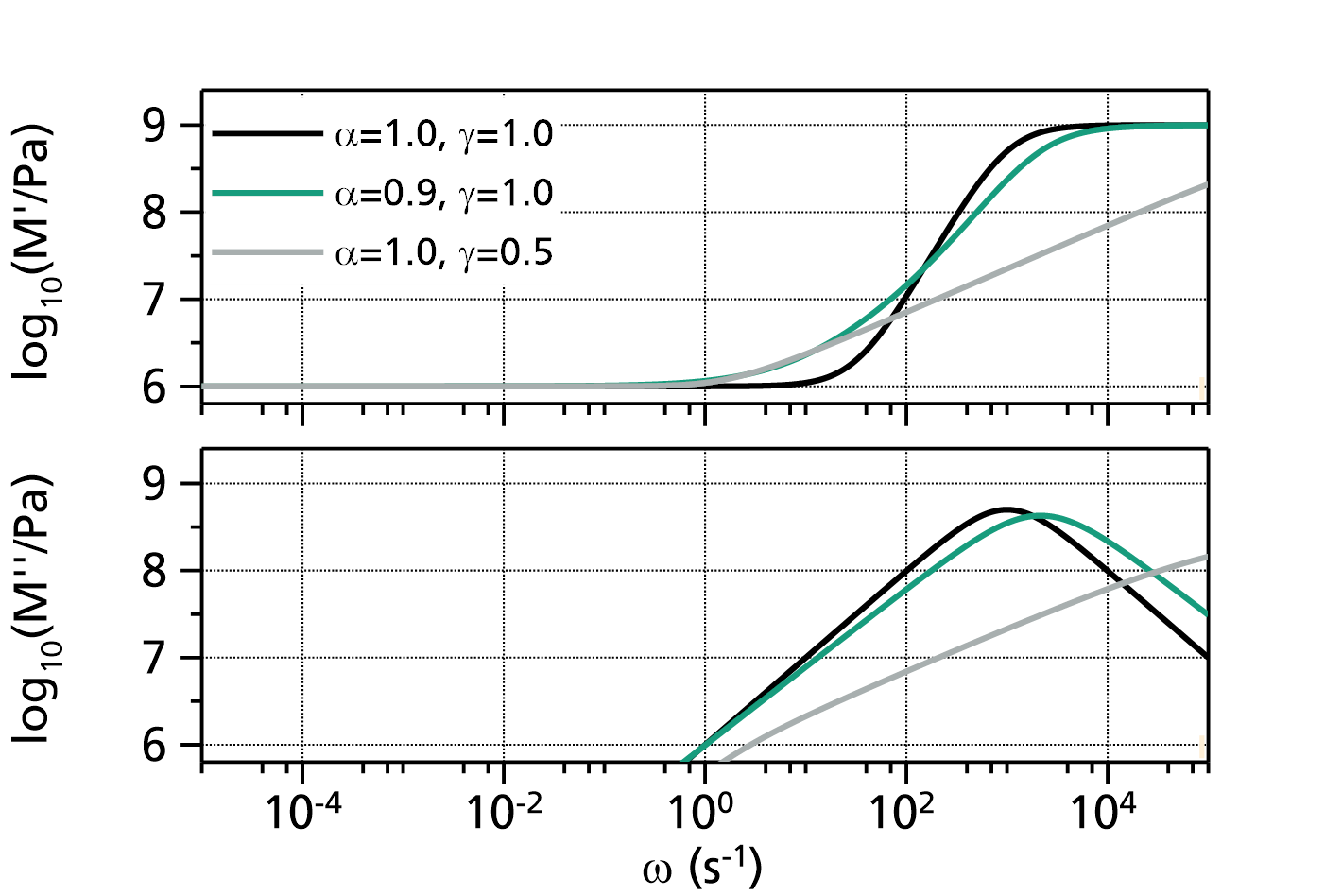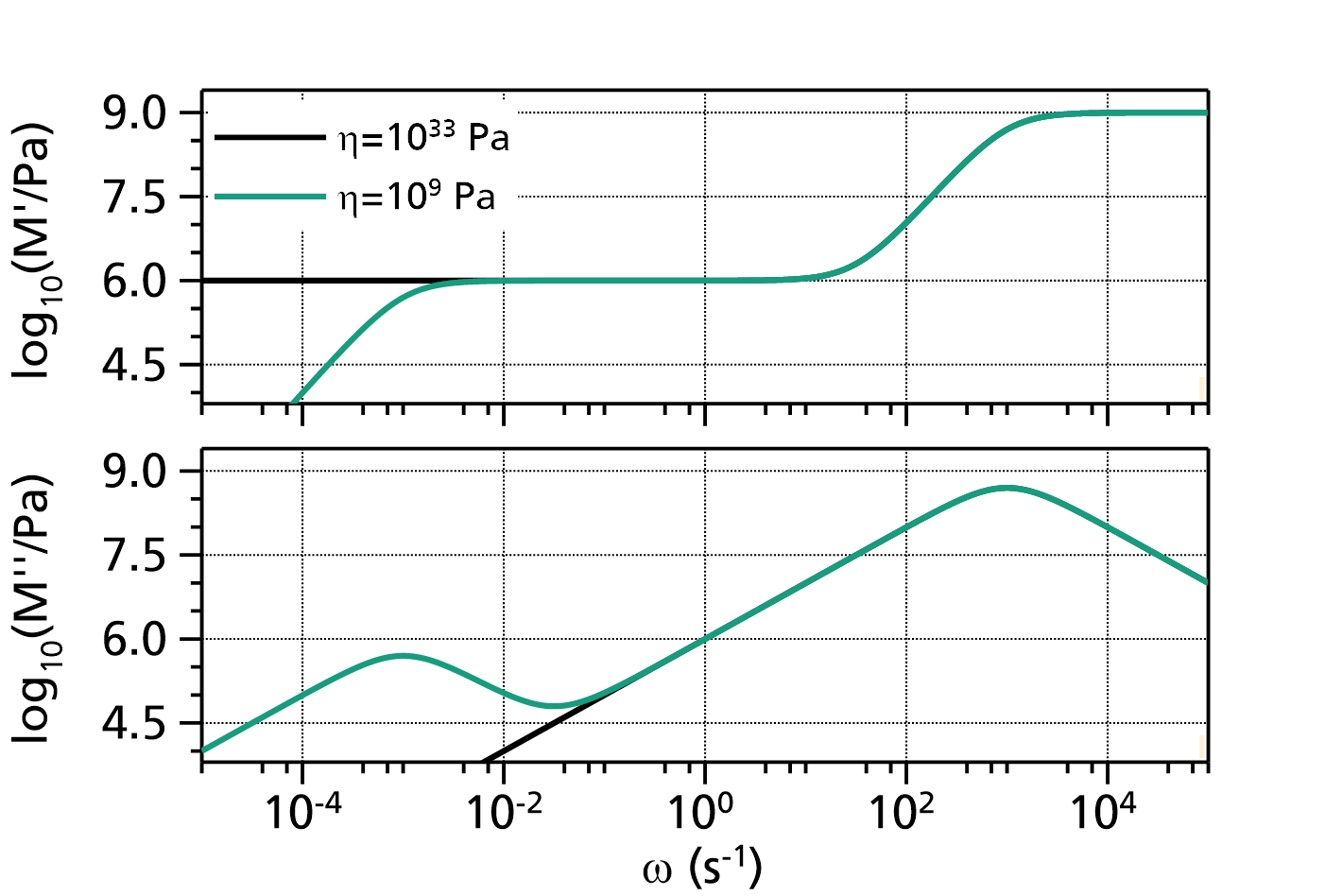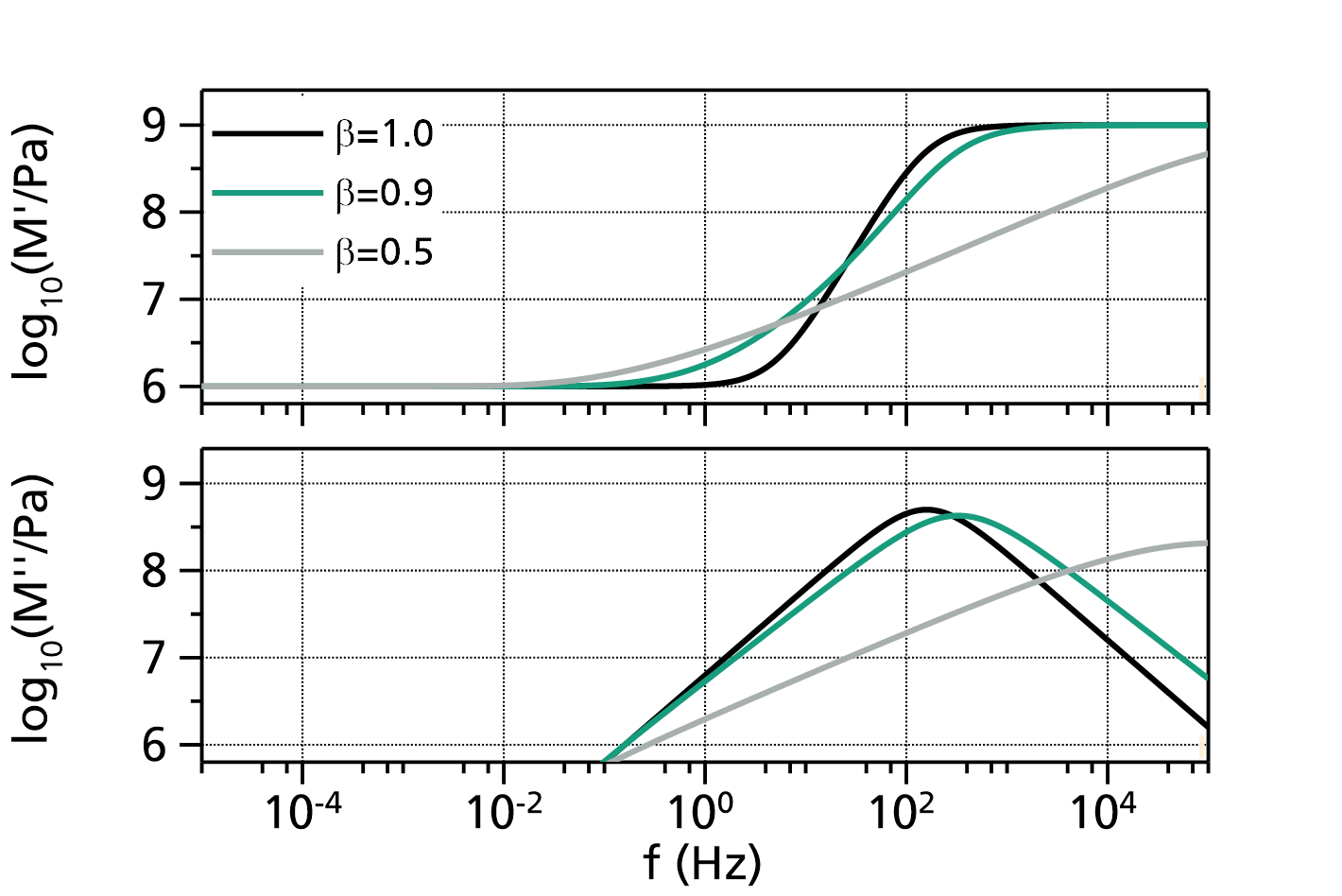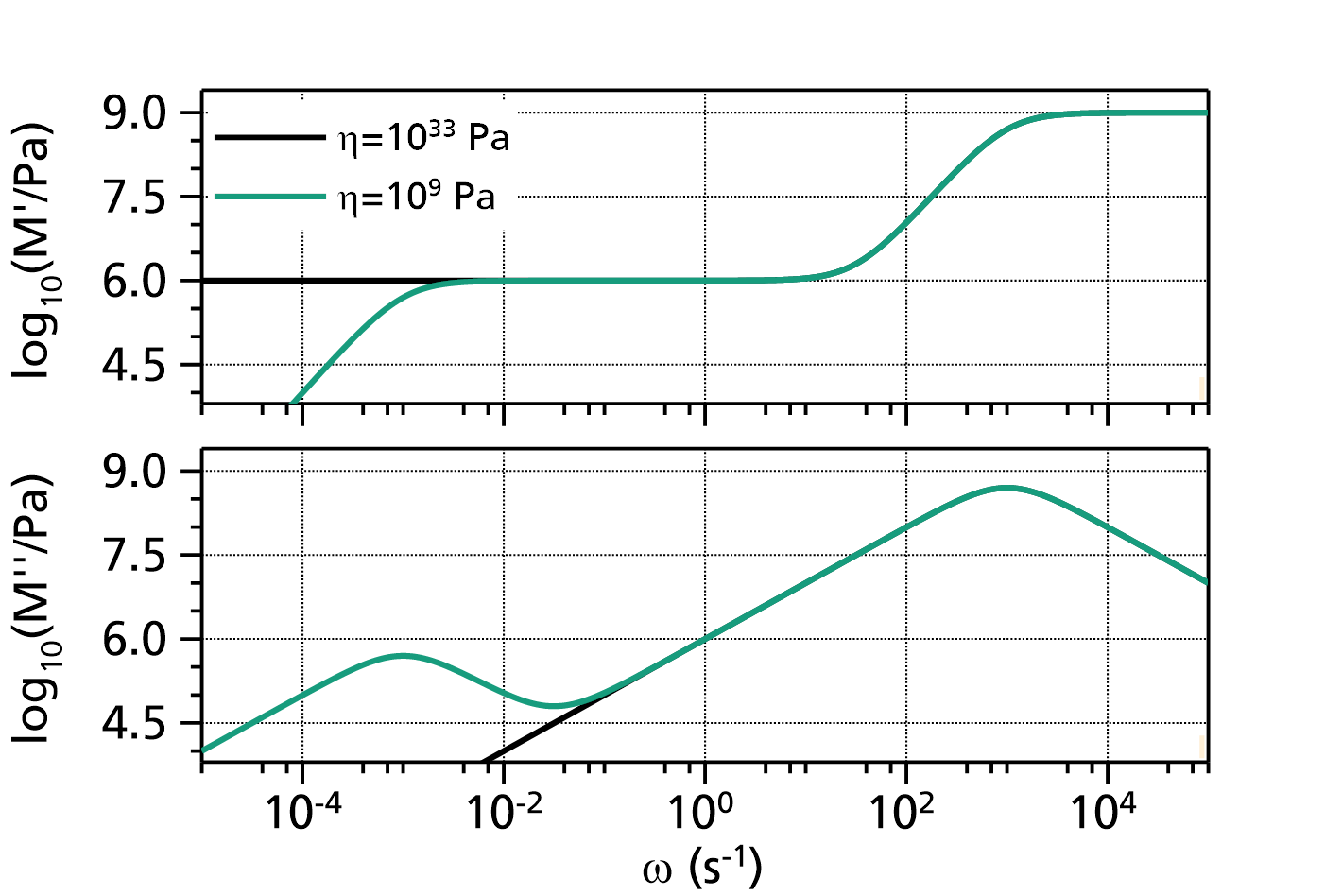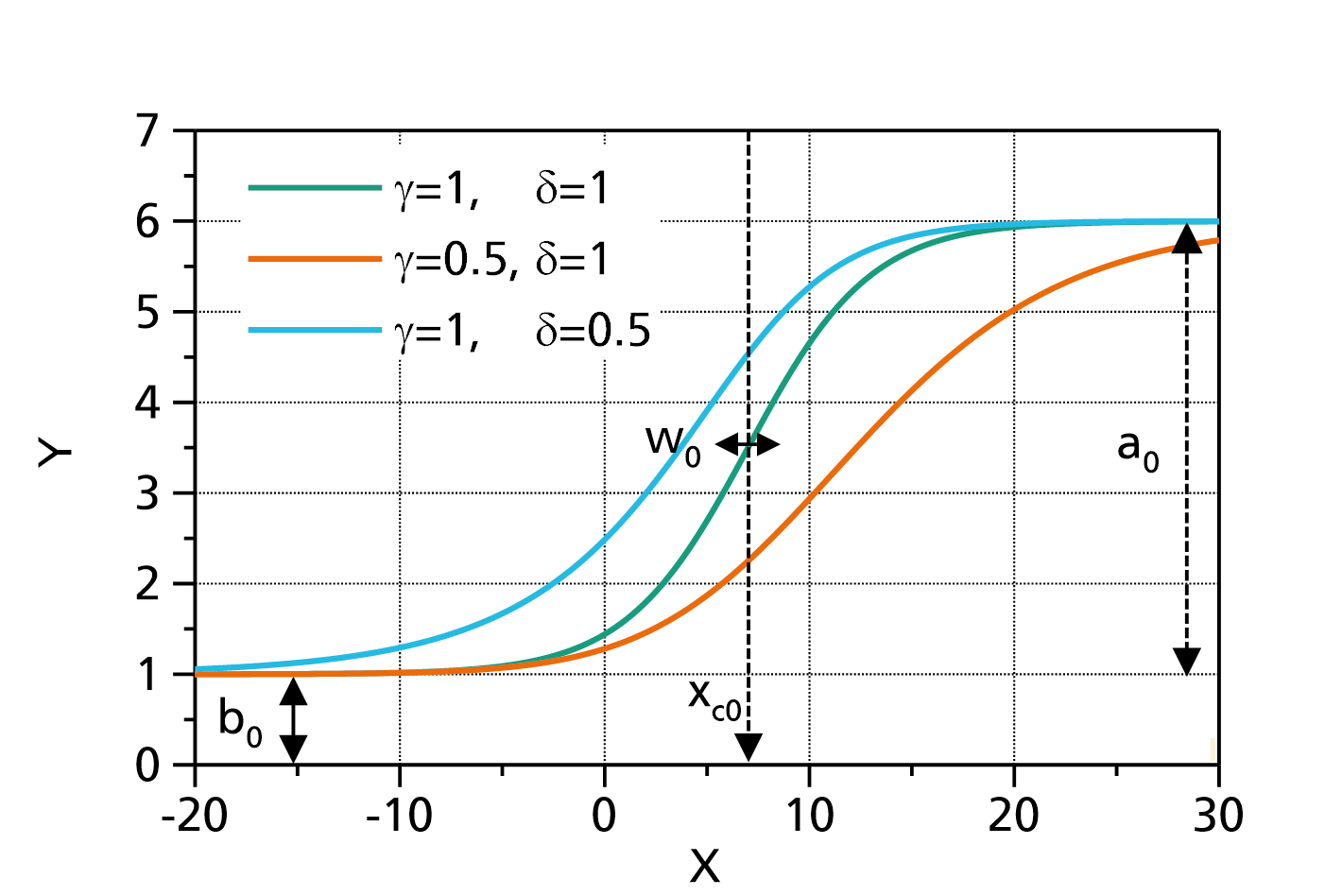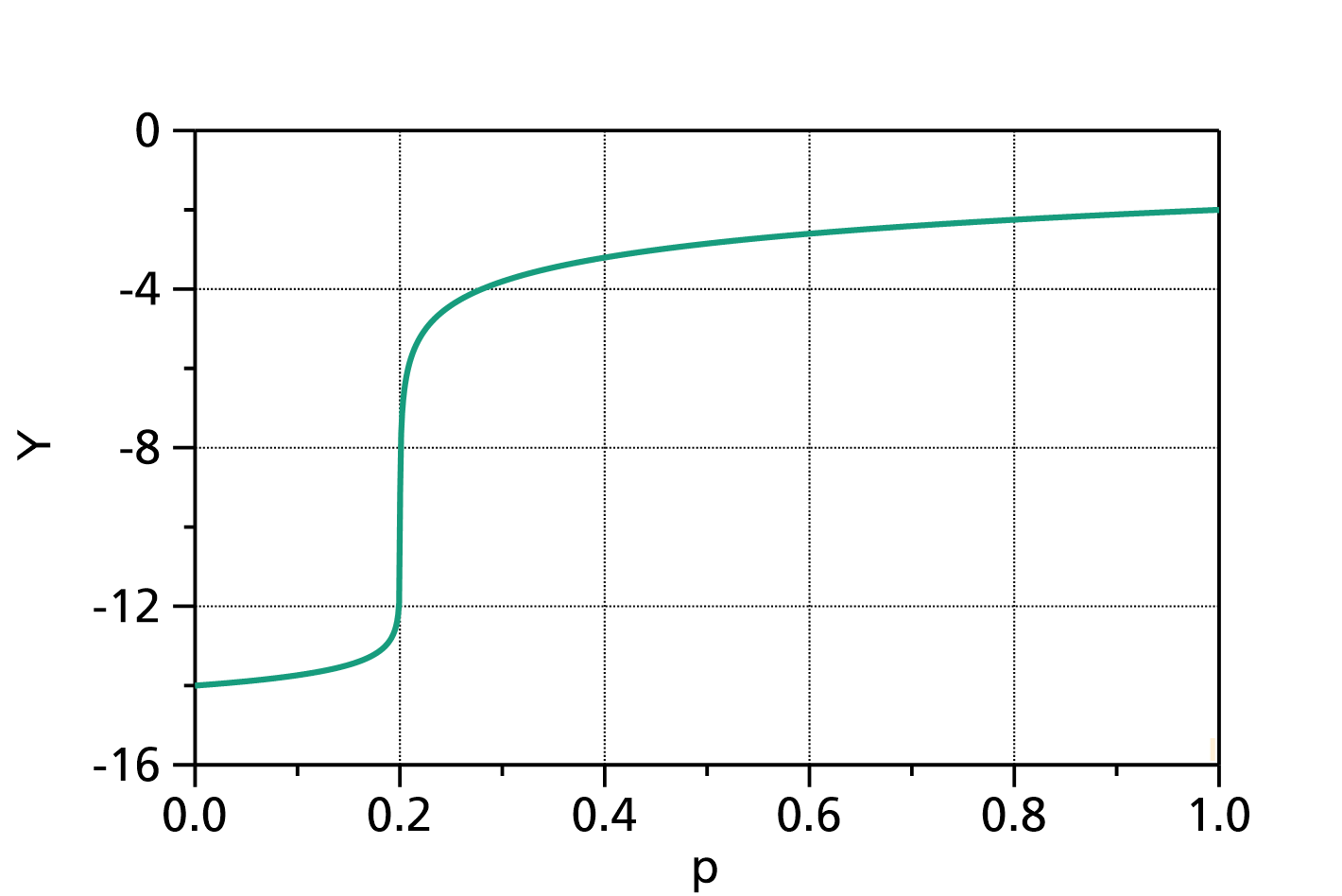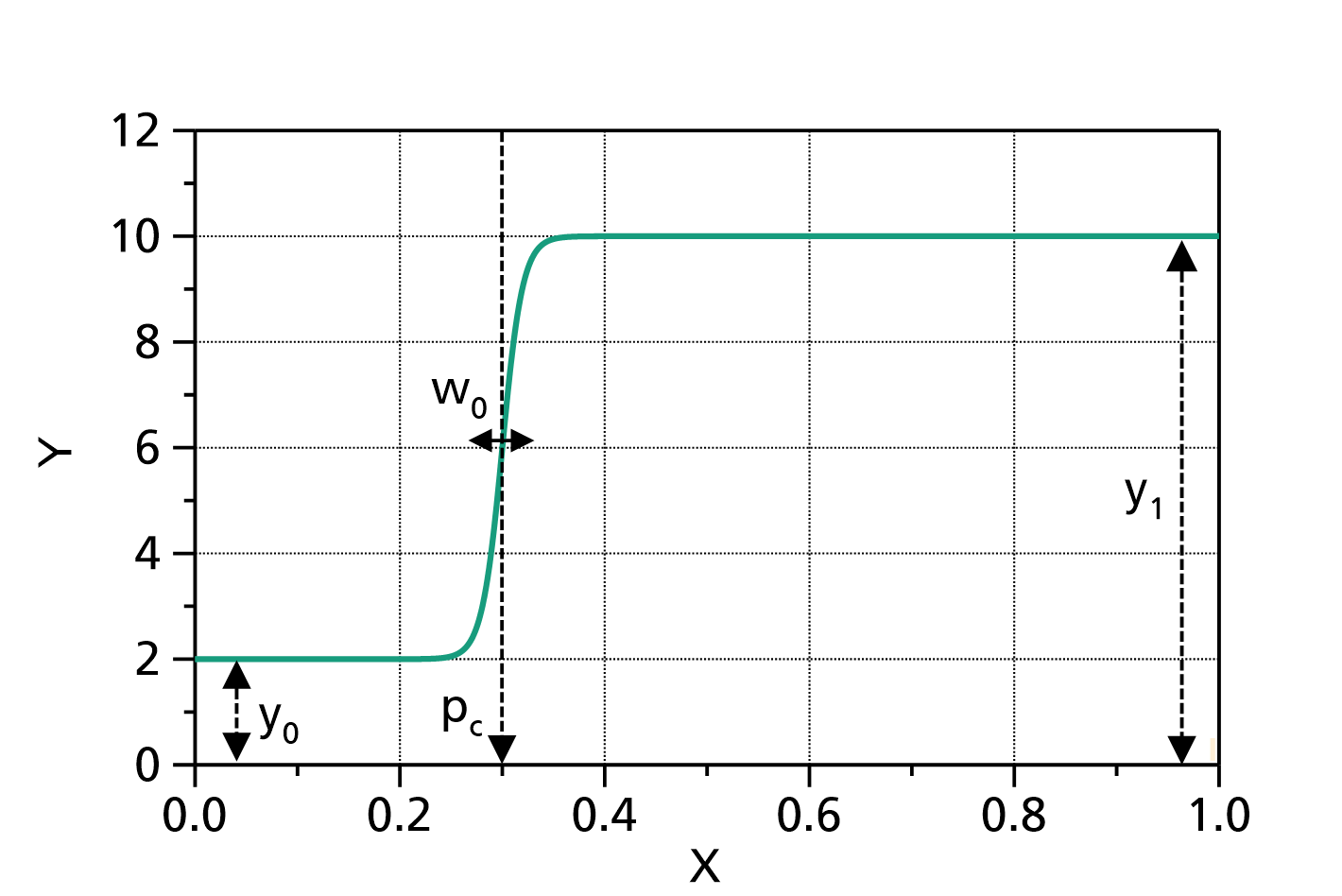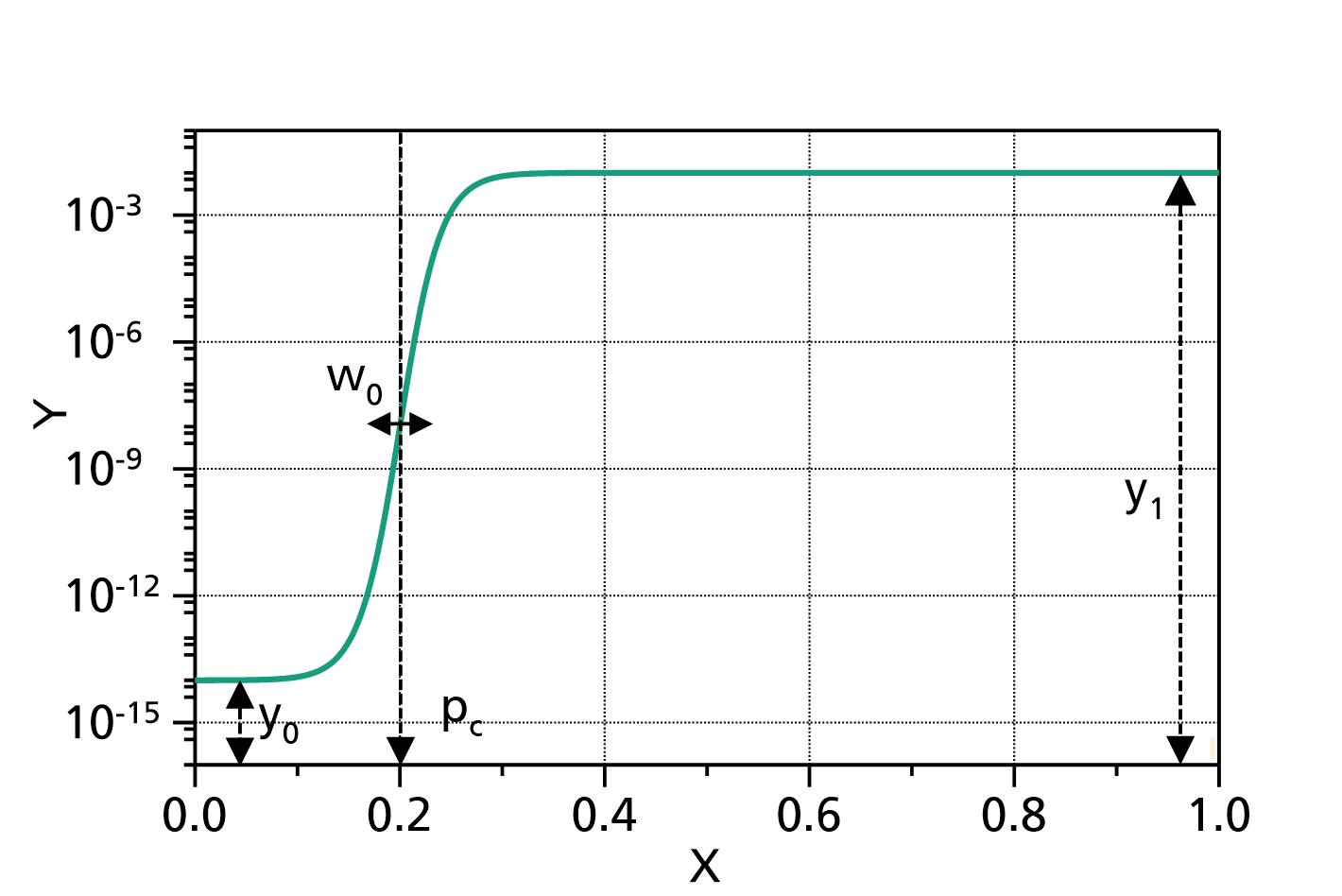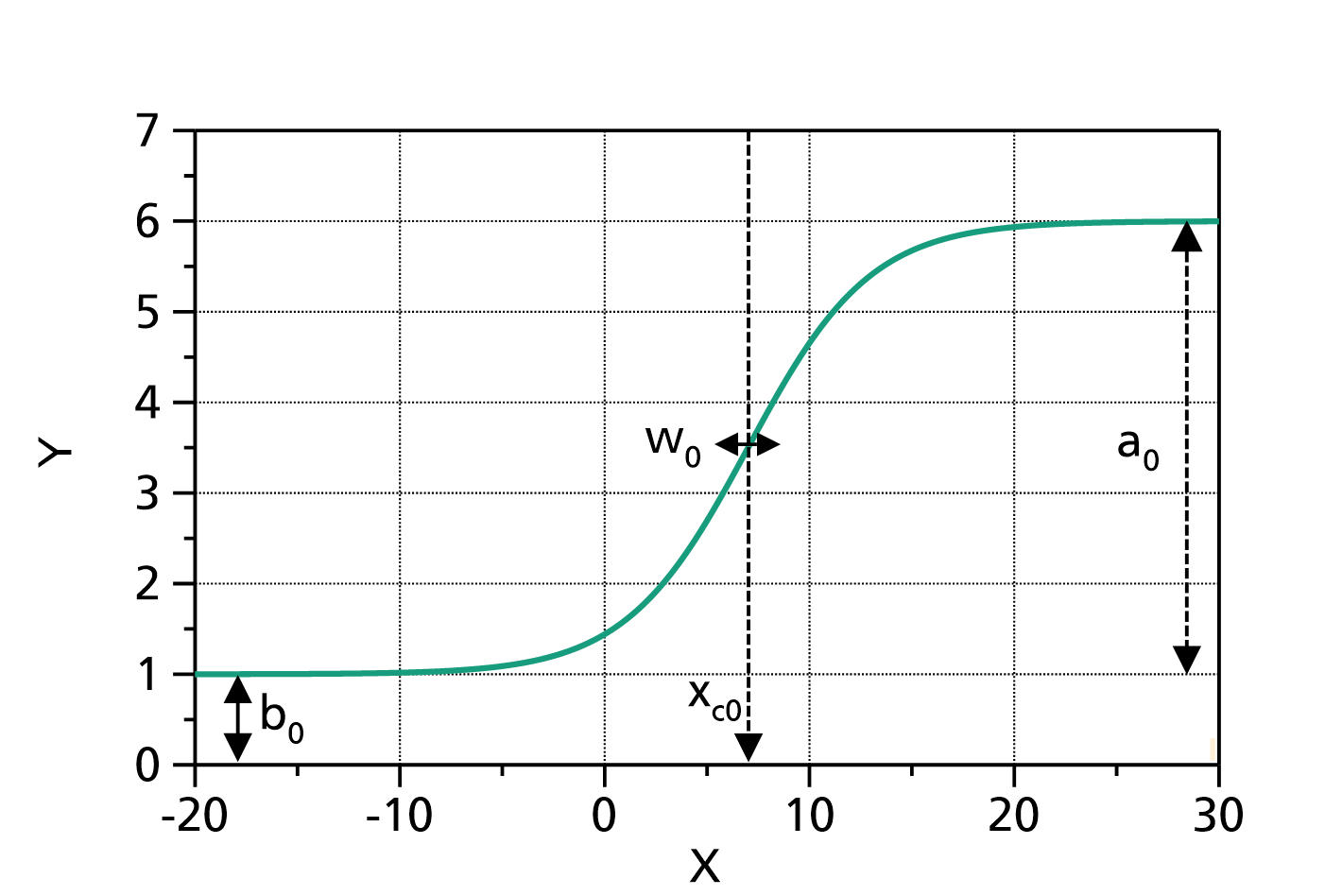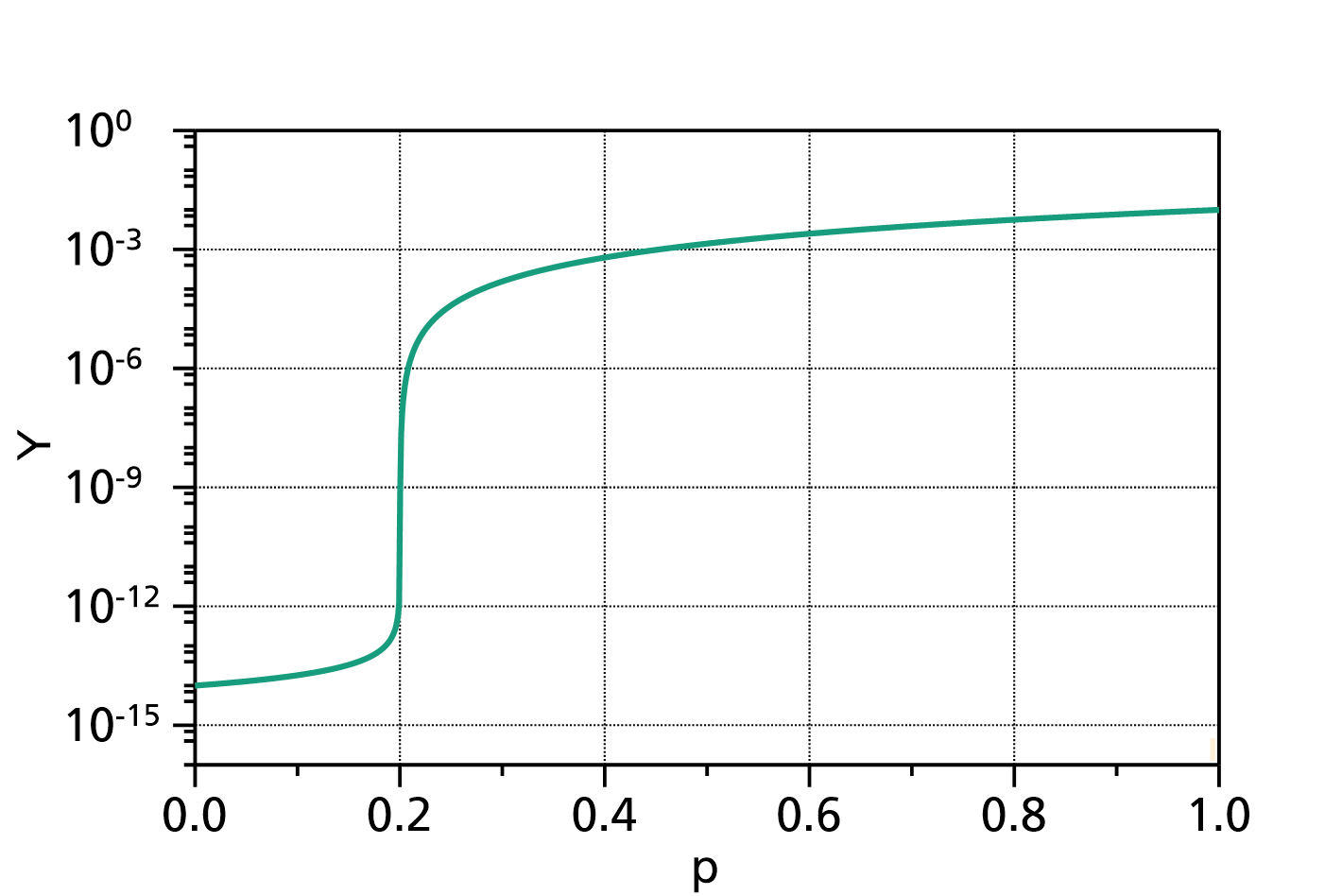Built-in fit functions |
Previous section: Appendix
This topic contains the following sections:
- General fit functions
- Kinetics related fit functions
- Materials related fit functions
- Fit functions for peaks (height parameter)
- Fit functions for probability density and peaks (area parameter)
- Relaxation fit functions
- Retardation fit functions
- Fit functions for transitions
ExponentialDecay
This function evaluates an exponential decay with one or multiple terms according to
in which:
The number of terms ![]() can be changed by double-clicking on the fit function. The default value is
can be changed by double-clicking on the fit function. The default value is ![]() .
.
The domain of the function is ![]() .
.
Fig. 1: Exponential decay with ![]() ,
, ![]() , and
, and ![]() .
.
ExponentialEquilibration
This function evaluates an exponential equilibration process with one or multiple terms according to

in which:
The number of terms ![]() can be changed by double-clicking on the fit function. The default value is
can be changed by double-clicking on the fit function. The default value is ![]() .
.
The domain of the function is ![]() .
.
Fig. 1: Exponential equilibration with ![]() ,
, ![]() ,
, ![]() and
and ![]() .
.
Exponential growth
This function evaluates an exponential growth with one or multiple terms according to
in which:
The number of terms ![]() can be changed by double-clicking on the fit function. The default value is
can be changed by double-clicking on the fit function. The default value is ![]() .
.
The domain of the function is ![]() .
.
Fig. 1: Exponential growth with ![]() ,
, ![]() and
and ![]() .
.
Polynomial
This function evaluates an polynomial with one or multiple terms, and both positive and negative exponents, according to
in which:
The polynomial orders ![]() and
and ![]() can be changed by double-clicking on the fit function. The default value is
can be changed by double-clicking on the fit function. The default value is ![]() and
and ![]() . If some of the terms are not needed, set their corresponding coefficients fixed to zero.
. If some of the terms are not needed, set their corresponding coefficients fixed to zero.
The domain of the function is ![]() . If
. If ![]() ,
, ![]() is excluded.
is excluded.
Fig. 1: Polynomial (![]() ,
, ![]() ) with
) with ![]() ,
, ![]() ,
, ![]() and
and ![]() .
.
Power law (with pre-factors)
This function evaluates a power law with one or multiple terms according to
in which:
The number of terms ![]() can be changed by double-clicking on the fit function. The default value is
can be changed by double-clicking on the fit function. The default value is ![]() . Strictly speaking, the function is a power law only if
. Strictly speaking, the function is a power law only if ![]() and
and ![]() .
.
The domain of the function is ![]() if all
if all ![]() are positive, or
are positive, or ![]() if some of the exponents are negative.
if some of the exponents are negative.
Note:
Even if you set the exponents fixed to integer values, the domain of the function is not extended to the full range! If the full range is neccessary, try to use Polynomial instead.
Fig. 1: Power law with ![]() ,
, ![]() and
and ![]() with linear x- and y-axes.
with linear x- and y-axes.
Fig. 2: Power law with the same parameters ![]() ,
, ![]() and
and ![]() in a double-logarithmic plot.
in a double-logarithmic plot.
Power law (with ratios)
This function evaluates a power law with one or multiple terms according to
in which:
The number of terms ![]() can be changed by double-clicking on the fit function. The default value is
can be changed by double-clicking on the fit function. The default value is ![]() . Strictly speaking, the function is a power law only if
. Strictly speaking, the function is a power law only if ![]() and
and ![]() .
.
The domain of the function is ![]() if all
if all ![]() and all
and all ![]() are positive,
are positive, ![]() if all
if all ![]() are positive and all
are positive and all ![]() are negative, and, if some of the exponents are negative, the value
are negative, and, if some of the exponents are negative, the value ![]() is not included.
is not included.
Fig. 1: Power law (ratio) with ![]() ,
, ![]() and
and ![]() with linear x- and y-axes.
with linear x- and y-axes.
Fig. 2: Power law (ratio) with the same parameters ![]() ,
, ![]() and
and ![]() in a double-logarithmic plot.
in a double-logarithmic plot.
Rational
This function evaluates a rational polynom with one or multiple terms in the nominator and in the denominator according to
in which:
In order to avoid covariance between the 0th order coefficients ![]() and
and ![]() , in this formula
, in this formula ![]() is set to
is set to ![]() . Please use RationalInverse if a free value of
. Please use RationalInverse if a free value of ![]() is preferred.
is preferred.
The polynomial orders ![]() and
and ![]() can be changed by double-clicking on the fit function. The default value is
can be changed by double-clicking on the fit function. The default value is ![]() and
and ![]() .
.
The domain of the function is ![]() , with some points (poles) excluded, at which the denominator becomes zero.
, with some points (poles) excluded, at which the denominator becomes zero.
Fig. 1: Rational ![]() , i.e. with
, i.e. with ![]() ,
, ![]() ,
, ![]() and
and ![]() .
.
RationalInverse
This function evaluates a rational polynom with one or multiple terms in the nominator and in the denominator according to
in which:
In order to avoid covariance between the 0th order coefficients ![]() and
and ![]() , in this formula
, in this formula ![]() is set to
is set to ![]() . Please use Rational if a free value of
. Please use Rational if a free value of ![]() is preferred.
is preferred.
The polynomial orders ![]() and
and ![]() can be changed by double-clicking on the fit function. The default value is
can be changed by double-clicking on the fit function. The default value is ![]() and
and ![]() .
.
The domain of the function is ![]() , with some points (poles) excluded, at which the denominator becomes zero.
, with some points (poles) excluded, at which the denominator becomes zero.
Fig. 1: RationalInverse ![]() , i.e. with
, i.e. with ![]() ,
, ![]() ,
, ![]() and
and ![]() .
.
Stretched exponential decay
(also known as Kohlrausch decay)
This function evaluates a stretched exponential decay process starting at ![]() with one or multiple terms according to
with one or multiple terms according to

in which:
 is the starting point of the decay process. If this value is known, you should enter the value and set this parameter to fixed.
is the starting point of the decay process. If this value is known, you should enter the value and set this parameter to fixed.
The number of terms ![]() can be changed by double-clicking on the fit function. The default value is
can be changed by double-clicking on the fit function. The default value is ![]() .
.
The domain of the function is ![]() . The function values are set to constant for
. The function values are set to constant for ![]() .
.
Fig. 1: Stretched exponential decay with ![]() ,
, ![]() ,
, ![]() ,
, ![]() , and
, and ![]() (green) in comparison to a 'normal' exponential decay function with the same parameters (grey). Note that the 'normal' exponential decay has varying function values both for
(green) in comparison to a 'normal' exponential decay function with the same parameters (grey). Note that the 'normal' exponential decay has varying function values both for ![]() and
and ![]() , whereas the stretched exponential decay is constant for
, whereas the stretched exponential decay is constant for ![]() .
.
Stretched exponential equilibration
This function evaluates a stretched exponential equilibration process with one or multiple terms according to

in which:
 is the starting point of the equilibration process. If this value is known, you should enter the value and set this parameter to fixed.
is the starting point of the equilibration process. If this value is known, you should enter the value and set this parameter to fixed.
 ..
..  are the pre-factors of the exponential equilibration terms
are the pre-factors of the exponential equilibration terms
The number of terms ![]() can be changed by double-clicking on the fit function. The default value is
can be changed by double-clicking on the fit function. The default value is ![]() .
.
The domain of the function is ![]() .
.
Fig. 1: Stretched exponential equilibration with ![]() ,
, ![]() ,
, ![]() ,
, ![]() , and
, and ![]() (green) in comparison to a 'normal' exponential equilibration function with the same parameters (grey).
(green) in comparison to a 'normal' exponential equilibration function with the same parameters (grey).
Stretched exponential growth
This function evaluates a stretched exponential growth process starting at ![]() with one or multiple terms according to
with one or multiple terms according to

in which:
 is the starting point of the growth process. If this value is known, you should enter the value and set this parameter to fixed.
is the starting point of the growth process. If this value is known, you should enter the value and set this parameter to fixed.
The number of terms ![]() can be changed by double-clicking on the fit function. The default value is
can be changed by double-clicking on the fit function. The default value is ![]() .
.
The domain of the function is ![]() . The function values are set to constant for
. The function values are set to constant for ![]() .
.
Fig. 1: Stretched exponential growth with ![]() ,
, ![]() ,
, ![]() ,
, ![]() , and
, and ![]() (green) in comparison to a 'normal' exponential growth function with the same parameters (grey). Note that the 'normal' exponential growth has varying function values both for
(green) in comparison to a 'normal' exponential growth function with the same parameters (grey). Note that the 'normal' exponential growth has varying function values both for ![]() and
and ![]() , whereas the stretched exponential growth is constant for
, whereas the stretched exponential growth is constant for ![]() .
.
Conversion of an autocatalytic reaction
This fit function represents the solution of the differential equation for the conversion of an autocatalytic reaction (e.g. epoxy curing), namely:

in which
 is a value in the range [0, 1], e.g. the chemical conversion,
is a value in the range [0, 1], e.g. the chemical conversion,
 is the independent variable (for a reaction,
is the independent variable (for a reaction,  represents the time),
represents the time),
Important: In this fit function, the dependent variable
is not the conversion
, but a scaled value of the conversion
, in which
is an additional parameter!
The values of ![]() ,
, ![]() and
and ![]() are assumed to be positive. The value of
are assumed to be positive. The value of ![]() before the start of reaction (
before the start of reaction (![]() ) is assumed to be 0.
) is assumed to be 0.
Since there is no general analytical solution of this differential equation, the solution must be calculated using an ordinary differential equation solver. This could make fits to a large data set somewhat slow.
The domain of the function is ![]() .
.
Tip #1:
To fit conversion data that are in the range [0,1], set the parameterfixed to a value of 1.
Tip #2:
To fit conversion data that are in percent, i.e. in a range of [0, 100], set the parameterfixed to a value of 100.
Note:
This kinetic equation assumes that the conversion finally reaches 1 (100%). This assumption may be wrong if the glass temperature of the finally cured material exceeds the curing temperature.
Fig. 1: ConversionAutocatalytic (with ![]() ,
, ![]() ,
, ![]() and
and ![]() =1). The values for
=1). The values for ![]() and
and ![]() are indicated in the legend.
are indicated in the legend.
References:
J. M. Kenny, Determination of Autocatalytic Kinetic Model Parameters Describing Thermoset Cure, Journal of Applied Polymer Science, Vol. 51, 761-764 (1994)
Conversion of a reaction of nth order
This fit function represents the solution of the differential equation of a conversion kinetics of nth order, namely:

in which
 is a value in the range [0, 1], e.g. the chemical conversion,
is a value in the range [0, 1], e.g. the chemical conversion,
 is the independent variable (for a kinetics,
is the independent variable (for a kinetics,  represents the time),
represents the time),
Important: In this fit function, the dependent variable
is not the conversion
, but a scaled value of the conversion
, in which
is an additional parameter!
The value of ![]() is assumed to be positive.
is assumed to be positive.
The solution for ![]() of the differential equation is:
of the differential equation is:
For ![]() ,
, ![]() is set to 0. Additionally, in order to be consistent among different
is set to 0. Additionally, in order to be consistent among different ![]() ,
, ![]() is set to 1 if
is set to 1 if ![]() and
and ![]() .
.
The domain of the function is ![]() .
.
Tip #1:
To fit conversion data that are in the range [0,1], set the parameterfixed to a value of 1.
Tip #2:
To fit conversion data that are in percent, i.e. in a range of [0, 100], set the parameterfixed to a value of 100.
Fig. 1: ConversionNthOrder fit functions (with ![]() ,
, ![]() ,
, ![]() ). The values for
). The values for ![]() are indicated in the legend.
are indicated in the legend.
Kinetics of nth order
This fit function represents the solution of the differential equation for a kinetics of nth order, namely:

in which
The values of ![]() and
and ![]() is assumed to be positive.
is assumed to be positive.
The solution of this differential equation is:

The domain of the function is:

Fig. 1: KineticsNthOrder (with ![]() ,
, ![]() ). The values for
). The values for ![]() are indicated in the legend.
are indicated in the legend.
Rate of conversion of an autocatalytic reaction
This fit function represents the solution of the differential equation for the conversion of an autocatalytic reaction (e.g. epoxy curing), namely:

in which
 is a value in the range [0, 1], e.g. the chemical conversion,
is a value in the range [0, 1], e.g. the chemical conversion,
 is the independent variable (for a reaction,
is the independent variable (for a reaction,  represents the time),
represents the time),
Important: In this fit function, the dependent variable is not the conversion
, but a scaled value of the conversion rate
, in which
is an additional parameter!
The values of ![]() ,
, ![]() and
and ![]() are assumed to be positive. The value of
are assumed to be positive. The value of ![]() before the start of reaction (
before the start of reaction (![]() ) is assumed to be 0.
) is assumed to be 0.
Since there is no general analytical solution of this differential equation, the solution must be calculated using an ordinary differential equation solver. This could make fits to a large data set somewhat slow.
The domain of the function is ![]() .
.
Note:
This kinetic equation assumes that the conversion finally reaches 1 (100%). This assumption may be wrong if the glass temperature of the finally cured material exceeds the curing temperature.
Fig. 1: RateOfConversionAutocatalytic (with ![]() ,
, ![]() ,
, ![]() and
and ![]() =1). The values for
=1). The values for ![]() and
and ![]() are indicated in the legend.
are indicated in the legend.
References:
J. M. Kenny, Determination of Autocatalytic Kinetic Model Parameters Describing Thermoset Cure, Journal of Applied Polymer Science, Vol. 51, 761-764 (1994)
Conversion of a reaction of nth order
This fit function represents the solution of the differential equation of a conversion kinetics of nth order, namely:

in which
 is a value in the range [0, 1], e.g. the chemical conversion,
is a value in the range [0, 1], e.g. the chemical conversion,
 is the independent variable (for a kinetics,
is the independent variable (for a kinetics,  represents the time),
represents the time),
Important: In this fit function, the dependent variable is not the conversion
, but a scaled value of the conversion rate
, in which
is an additional parameter!
The value of ![]() is assumed to be positive.
is assumed to be positive.
The solution for ![]() of the differential equation is:
of the differential equation is:
For ![]() ,
, ![]() is set to 0. Additionally, in order to be consistent among different
is set to 0. Additionally, in order to be consistent among different ![]() ,
, ![]() is set to 1 if
is set to 1 if ![]() and
and ![]() .
.
The domain of the function is ![]() .
.
Fig. 1: RateOfConversionNthOrder fit functions (with ![]() ,
, ![]() ,
, ![]() ). The values for
). The values for ![]() are indicated in the legend.
are indicated in the legend.
Arrhenius law (rate)
This Arrhenius law describes the temperature dependence of e.g. reaction rates, typical frequencies, e.g. quantities that increase with increasing temperature.
The function is defined as:
in which ![]() is the reaction rate (dependent variable),
is the reaction rate (dependent variable), ![]() is the absolute (!) temperature (independent variable), and
is the absolute (!) temperature (independent variable), and ![]() is a constant, usually the Boltzmann constant, but it depends on the options you choose for the fit (see below).
is a constant, usually the Boltzmann constant, but it depends on the options you choose for the fit (see below).
The parameters are:
Please note that for large temperature intervals, the y-value can vary over some orders of magnitude. This will lead to a poor fit, because the data points with small values of the reaction rate then contribute too little to the fit.
In order to get a good fit nevertheless, it is neccessary that you logarithmize your data points before they get fitted, and choose the DecadicLogarithm dependent variable option on this fit.
Options for the independent variable x:
Options for the dependent variable y:
Option for parameters:
ParameterEnergyRepresentation
Fig. 1: Typical plot of an Arrhenius diagram (reaction rate by the inverse temperature). Here the parameters are ![]() and
and ![]() kJ/mol. Please note that if you choose the x-axis to be
kJ/mol. Please note that if you choose the x-axis to be ![]() instead of T and the y-axis to be logarithmic, as in this example, the curve becomes a straight line. You can even include the "right" temperatures in °C by adding a second axis at the bottom, with inverse tick spacing and the transformation
instead of T and the y-axis to be logarithmic, as in this example, the curve becomes a straight line. You can even include the "right" temperatures in °C by adding a second axis at the bottom, with inverse tick spacing and the transformation ![]() .
.
Arrhenius law (time)
This Arrhenius law describes the temperature dependence of e.g. relaxation or retardation times, or viscosities, e.g. quantities that decrease with increasing temperature.
The function is defined as:
in which ![]() is the relaxation or retardation time or viscosity (dependent variable),
is the relaxation or retardation time or viscosity (dependent variable), ![]() is the absolute (!) temperature (independent variable), and
is the absolute (!) temperature (independent variable), and ![]() is a constant, usually the Boltzmann constant, but it depends on the options you choose for the fit (see below).
is a constant, usually the Boltzmann constant, but it depends on the options you choose for the fit (see below).
The parameters are:
Please note that for large temperature intervals, the y-value can vary over some orders of magnitude. This will lead to a poor fit, because the data points with small values of the reaction rate then contribute too little to the fit.
In order to get a good fit nevertheless, it is neccessary that you logarithmize your data points before they get fitted, and choose the DecadicLogarithm dependent variable option on this fit.
Options for the independent variable x:
Options for the dependent variable y:
Option for parameters:
ParameterEnergyRepresentation
Fig. 1: Typical plot of an Arrhenius diagram (viscosity by the inverse temperature). Here the parameters are ![]() and
and ![]() kJ/mol. Please note that if you choose the x-axis to be
kJ/mol. Please note that if you choose the x-axis to be ![]() instead of T and the y-axis to be logarithmic, as in this example, the curve becomes a straight line. You can even include the "right" temperatures in °C by adding a second axis at the bottom, with inverse tick spacing and the transformation
instead of T and the y-axis to be logarithmic, as in this example, the curve becomes a straight line. You can even include the "right" temperatures in °C by adding a second axis at the bottom, with inverse tick spacing and the transformation ![]() .
.
Vogel-Fulcher law (rate, mobility)
The Vogel-Fulcher law describes the dependence of reaction rates, mobilities, viscosities and relaxation times on the temperature for materials like glasses and polymers for temperatures in the vicinity of the glass transition temperature and in any case above the so-called Vogel temperature ![]() .
.
This variant of the Vogel-Fulcher law is especially suited to describe the temperature dependence of rates, mobilities, diffusion coefficients etc., i.e. quantities which increase with increasing temperatures. in glasses at temperatures above ![]() .
.
The function is defined as:
in which ![]() is the rate, mobility, etc. (dependent variable),
is the rate, mobility, etc. (dependent variable), ![]() is the temperature (independent variable),
is the temperature (independent variable), ![]() is the so-called Vogel temperature, and
is the so-called Vogel temperature, and ![]() is a broadness parameter.
is a broadness parameter.
Note: The function above is designed for reaction rates, mobilities, etc., i.e. for quantities, which increase with increasing temperature. But quantities like viscosity, relaxation times decrease with increasing temperature. To fit those quantities, please use VogelFulcherLaw (Time), or use this function with a negative value for
.
The parameters are:
 is the Vogel-Temperature. The formula is only valid for temperatures
is the Vogel-Temperature. The formula is only valid for temperatures  . At the Vogel temperature, reaction rates, mobilities, etc., converge to zero.
. At the Vogel temperature, reaction rates, mobilities, etc., converge to zero.
Please note that for large temperature intervals, the function value can vary over many orders of magnitude. This will lead to a poor fit, because the data points with small values then contribute too little to the fit.
In order to get a good fit nevertheless, it is necessary that you logarithmize your data points before they get fitted. In order to do this, choose the DecadicLogarithm or NaturalLogarithm transformation for both the transformation of your data and for the transformation of the fit output ![]() .
.
Options for the independent variable ![]() :
:
Kelvin: Your x-values are absolute temperatures in Kelvin
DegreeCelsius: your x-values are given as temperatures in °C
DegreeFahrenheit: your x-values are given as temperatures in °F
Option for parameters:
ParameterEnergyRepresentation
Fig. 1: Vogel-Fulcher law (e.g. reaction rate by temperature). Here the parameters are ![]() ,
, ![]() =120°C and
=120°C and ![]() =1000 K.
=1000 K.
Fig. 2: Vogel-Fulcher law plotted in an Arrhenius diagram (e.g. reaction rate versus inverse temperature). The parameters are ![]() ,
, ![]() =120°C and
=120°C and ![]() =1000 K.
=1000 K.
Vogel-Fulcher law (relaxation times, viscosities)
The Vogel-Fulcher law describes the dependence of reaction rates, mobilities, viscosities and relaxation times on the temperature for materials like glasses and polymers for temperatures in the vicinity of the glass transition temperature and in any case above the so-called Vogel temperature ![]() .
.
This variant of the Vogel-Fulcher law is especially suited to describe the temperature dependence of relaxation times, viscosities, etc., i.e. quantities which decrease with increasing temperatures. in glasses at temperatures above ![]() .
.
The function is defined as:
in which ![]() is the relaxation time, viscosity, etc. (dependent variable),
is the relaxation time, viscosity, etc. (dependent variable), ![]() is the temperature (independent variable),
is the temperature (independent variable), ![]() is the so-called Vogel temperature, and
is the so-called Vogel temperature, and ![]() is a broadness parameter.
is a broadness parameter.
Note: The function above is designed for relaxation times, viscosities, etc, i.e. for quantities, which decrease with increasing temperature. But quantities like reaction rates, mobilities, etc., increase with increasing temperature. To fit those quantities, please use VogelFulcherLawRate, or use this function with a negative value for
.
The parameters are:
 is the Vogel-Temperature. The formula is only valid for temperatures
is the Vogel-Temperature. The formula is only valid for temperatures  . At the Vogel temperature, relaxation times, viscosities, etc., converge to infinity.
. At the Vogel temperature, relaxation times, viscosities, etc., converge to infinity.
Please note that for large temperature intervals, the function value can vary over many orders of magnitude. This will lead to a poor fit, because the data points with small values then contribute too little to the fit.
In order to get a good fit nevertheless, it is necessary that you logarithmize your data points before they get fitted. In order to do this, choose the DecadicLogarithm or NaturalLogarithm transformation for both the transformation of your data and for the transformation of the fit output ![]() .
.
Options for the independent variable ![]() :
:
Kelvin: Your x-values are absolute temperatures in Kelvin
DegreeCelsius: your x-values are given as temperatures in °C
DegreeFahrenheit: your x-values are given as temperatures in °F
Option for parameters:
ParameterEnergyRepresentation
Fig. 1: Vogel-Fulcher law (e.g. relaxation time by temperature). Here the parameters are ![]() ,
, ![]() =120°C and
=120°C and ![]() =1000 K.
=1000 K.
Fig. 2: Vogel-Fulcher law plotted in an Arrhenius diagram (e.g. relaxation time versus inverse temperature). The parameters are ![]() ,
, ![]() =120°C and
=120°C and ![]() =1000 K.
=1000 K.
CauchyAmplitude
This function evaluates a sum of Cauchy (Lorentzian) terms, plus a baseline polynomial with one or multiple terms, according to
in which:
 are the half widths of half maximum (HWHM) of the Cauchy terms
are the half widths of half maximum (HWHM) of the Cauchy terms
 is the order of the baseline polynomial (set
is the order of the baseline polynomial (set  to disable the baseline polynomial)
to disable the baseline polynomial)
The number of Cauchy terms ![]() and the order of the baseline polynomial
and the order of the baseline polynomial ![]() can be changed by double-clicking on the fit function. The default values are
can be changed by double-clicking on the fit function. The default values are ![]() and
and ![]() .
.
The domain of the function is ![]() .
.
Fig. 1: CauchyAmplitude (![]() ,
, ![]() ) with
) with ![]() ,
, ![]() ,
, ![]() and
and ![]() .
.
References: Cauchy distribution at Wikipedia
GaussAmplitude
This function evaluates a sum of Gaussian terms, plus a baseline polynomial with one or multiple terms, according to
in which:
The number of Gaussian terms ![]() and the order of the baseline polynomial
and the order of the baseline polynomial ![]() can be changed by double-clicking on the fit function. The default values are
can be changed by double-clicking on the fit function. The default values are ![]() and
and ![]() .
.
The domain of the function is ![]() .
.
Fig. 1: GaussAmplitude (![]() ,
, ![]() ) with
) with ![]() ,
, ![]() ,
, ![]() and
and ![]() .
.
PearsonIVAmplitude
This function evaluates a sum of PearsonIV terms, plus a baseline polynomial with one or multiple terms, according to
in which:
 are the amplitudes (height of the maxima) of the PearsonIV terms
are the amplitudes (height of the maxima) of the PearsonIV terms
 is the order of the baseline polynomial (set
is the order of the baseline polynomial (set  to disable the baseline polynomial)
to disable the baseline polynomial)
The original PearsonIV function was modified, such as that the location parameters describe the location of the maximal value of the function, and the amplitude parameter is the maximum y-value of the function:
Modified version used in Altaxo:
The number of PearsonIV terms ![]() and the order of the baseline polynomial
and the order of the baseline polynomial ![]() can be changed by double-clicking on the fit function. The default values are
can be changed by double-clicking on the fit function. The default values are ![]() and
and ![]() .
.
The domain of the function is ![]() .
.
Fig. 1: PearsonIV (![]() ,
, ![]() ) with
) with ![]() ,
, ![]() ,
, ![]() ,
, ![]() ,
, ![]() , and
, and ![]() (green) or
(green) or ![]() (orange), respectively. Note that in the limit
(orange), respectively. Note that in the limit ![]() the PearsonVII function is returned.
the PearsonVII function is returned.
Literature:
[1] Description of the Pearson distribution family in Wikipedia
PearsonIVAmplitude (Parametrization HPW)
This function evaluates a sum of PearsonIV terms, plus a baseline polynomial with one or multiple terms, according to
in which:
 are the amplitudes (height of the maxima) of the PearsonIV terms
are the amplitudes (height of the maxima) of the PearsonIV terms
 is the order of the baseline polynomial (set
is the order of the baseline polynomial (set  to disable the baselinepolynomial)
to disable the baselinepolynomial)
The original PearsonIV function was modified, such as that the location parameter ![]() describe the location of the maximal value of the function, the amplitude parameter is the maximum y-value of the function, and the width parameter
describe the location of the maximal value of the function, the amplitude parameter is the maximum y-value of the function, and the width parameter ![]() is the approximate HWHM of the peak:
is the approximate HWHM of the peak:
Modified version used in Altaxo:
The number of PearsonIV terms ![]() and the order of the baseline polynomial
and the order of the baseline polynomial ![]() can be changed by double-clicking on the fit function. The default values are
can be changed by double-clicking on the fit function. The default values are ![]() and
and ![]() .
.
The domain of the function is ![]() .
.
Fig. 1: PearsonIVParametrizationHPW (![]() ,
, ![]() ) with
) with ![]() ,
, ![]() ,
, ![]() ,
, ![]() ,
, ![]() , and
, and ![]() (green) or
(green) or ![]() (orange), respectively. Note that in the limit
(orange), respectively. Note that in the limit ![]() the PearsonVII function (but in another parametrization) is returned.
the PearsonVII function (but in another parametrization) is returned.
Literature:
[1] Description of the Pearson distribution family in Wikipedia
PearsonVIIAmplitude
This function evaluates a sum of PearsonVII terms, plus a baseline polynomial with one or multiple terms, according to
in which:
 are the amplitudes (height of the maxima) of the PearsonVII terms
are the amplitudes (height of the maxima) of the PearsonVII terms
 is the order of the baseline polynomial (set
is the order of the baseline polynomial (set  to disable the baseline polynomial)
to disable the baseline polynomial)
The PearsonVII function is (see Wikipedia:
The number of PearsonVII terms ![]() and the order of the baseline polynomial
and the order of the baseline polynomial ![]() can be changed by double-clicking on the fit function. The default values are
can be changed by double-clicking on the fit function. The default values are ![]() and
and ![]() .
.
The domain of the function is ![]() .
.
Fig. 1: PearsonVII (![]() ,
, ![]() ) with
) with ![]() ,
, ![]() ,
, ![]() , and
, and ![]() (green) or
(green) or ![]() (orange), respectively. Note that in the limit
(orange), respectively. Note that in the limit ![]() this is the Cauchy function, and in the limit
this is the Cauchy function, and in the limit ![]() a Gaussian.
a Gaussian.
Literature:
[1] Description of the Pearson distribution family in Wikipedia
PseudoVoigt (Amplitude)
This function evaluates a sum of pseudo Voigt terms, plus a baseline polynomial with one or multiple terms, according to
in which:
 are the half-width-half-maximum values (HWHM) of the pseudo Voigt terms
are the half-width-half-maximum values (HWHM) of the pseudo Voigt terms
 are the mixing parameters between the Lorentzian part and the Gaussian part
are the mixing parameters between the Lorentzian part and the Gaussian part
 is the order of the baseline polynomial (set
is the order of the baseline polynomial (set  to disable the baseline polynomial)
to disable the baseline polynomial)
The pseudo Voigt function is an additive combination of a Gaussian function and a Lorentzian function:
Voigt:
Gauss:
Lorentzian:
The number of pseudo Voigt terms ![]() and the order of the baseline polynomial
and the order of the baseline polynomial ![]() can be changed by double-clicking on the fit function. The default values are
can be changed by double-clicking on the fit function. The default values are ![]() and
and ![]() .
.
The domain of the function is ![]() .
.
Fig. 1: PseudoVoigtAmplitude (![]() ,
, ![]() ) with
) with ![]() ,
, ![]() ,
, ![]() ,
, ![]() , and
, and ![]() (green) or
(green) or ![]() (orange), respectively. Note that in the limit
(orange), respectively. Note that in the limit ![]() the Gauss function is returned, in the limit
the Gauss function is returned, in the limit ![]() the Lorentzian function.
the Lorentzian function.
Shifted Log-Normal (parametrization: NIST)
This function evaluates a sum of shifted log-normal distribution terms, plus a baseline polynomial with one or multiple terms, according to
in which:
is the shifted log-normal function and for which the parametrization is:
 are the locations of the maximum of the shifted log-normal terms
are the locations of the maximum of the shifted log-normal terms
 are the full-width-half-maximum values (FWHM) of the shifted log-normal terms
are the full-width-half-maximum values (FWHM) of the shifted log-normal terms
 are skewness parameters of the shifted log-normal terms. The range is
are skewness parameters of the shifted log-normal terms. The range is  . For
. For  , the right slope is steeper than the left slope, for
, the right slope is steeper than the left slope, for  the left slope is steeper than the right slope. For
the left slope is steeper than the right slope. For  , the shape is Gaussian and therefore symmetric.
, the shape is Gaussian and therefore symmetric.
 is the order of the baseline polynomial (set
is the order of the baseline polynomial (set  to disable the baseline polynomial)
to disable the baseline polynomial)
The number of shifted log-normal terms ![]() and the order of the baseline polynomial
and the order of the baseline polynomial ![]() can be changed by double-clicking on the fit function. The default values are
can be changed by double-clicking on the fit function. The default values are ![]() and
and ![]() .
.
For x-values for which the shifted log-normal function is undefined, the y-value of that term is set to zero, so that the resulting domain of the function is ![]() .
.
Fig. 1: Shifted log-normal function (![]() ,
, ![]() ) with
) with ![]() ,
, ![]() ,
, ![]() , and
, and ![]() (green) or
(green) or ![]() (orange), respectively. Note that for
(orange), respectively. Note that for ![]() a Gaussian shape is returned.
a Gaussian shape is returned.
Note:
This function is used for instance to describe the intensity in dependence of the Raman shift of the Standard Reference Material 2242a from the National Institute of Standards and Technology NIST. In the formula given in the accompanying document, the number of terms is, and the order of the baseline polynomial is
. The parameter
corresponds to parameter
here; the parameter m in the document is the linear slope of the background, which is parameter
here; and the parameter
in the document is the constant background, which is parameter
here.
CauchyArea
This function evaluates a sum of Cauchy (Lorentzian) terms, plus a baseline polynomial with one or multiple terms, according to
in which:
 are the half widths of half maximum (HWHM) of the Cauchy terms
are the half widths of half maximum (HWHM) of the Cauchy terms
 is the order of the baseline polynomial (set
is the order of the baseline polynomial (set  to disable the baseline polynomial)
to disable the baseline polynomial)
The number of Cauchy terms ![]() and the order of the baseline polynomial
and the order of the baseline polynomial ![]() can be changed by double-clicking on the fit function. The default values are
can be changed by double-clicking on the fit function. The default values are ![]() and
and ![]() . In order to get the probability density function of the Cauchy distribution, set
. In order to get the probability density function of the Cauchy distribution, set ![]() ,
, ![]() , and set the parameter
, and set the parameter ![]() fixed to
fixed to ![]() .
.
The domain of the function is ![]() .
.
Fig. 1: CauchyArea (![]() ,
, ![]() ) with
) with ![]() ,
, ![]() ,
, ![]() and
and ![]() .
.
References: Cauchy distribution at Wikipedia
GaussArea
This function evaluates a sum of Gaussian terms, plus a baseline polynomial with one or multiple terms, according to
in which:
The number of Gaussian terms ![]() and the order of the baseline polynomial
and the order of the baseline polynomial ![]() can be changed by double-clicking on the fit function. The default values are
can be changed by double-clicking on the fit function. The default values are ![]() and
and ![]() .
.
The domain of the function is ![]() .
.
Fig. 1: GaussArea (![]() ,
, ![]() ) with
) with ![]() ,
, ![]() ,
, ![]() and
and ![]() .
.
PearsonIVArea
This function evaluates a sum of PearsonIV terms, plus a baseline polynomial with one or multiple terms, according to
in which:
Please note that the location parameters
are not the location of the maximum function values of the terms! (see figure below)
The PearsonIV function is scaled in a way that its area under the curve is 1:

The location of the maximum function value is at:
The number of PearsonIV terms ![]() and the order of the baseline polynomial
and the order of the baseline polynomial ![]() can be changed by double-clicking on the fit function. The default values are
can be changed by double-clicking on the fit function. The default values are ![]() and
and ![]() .
.
The domain of the function is ![]() .
.
Fig. 1: PearsonIVArea (![]() ,
, ![]() ) with
) with ![]() ,
, ![]() ,
, ![]() ,
, ![]() ,
, ![]() , and
, and ![]() (green) or
(green) or ![]() (orange), respectively. Note that despite the fact that
(orange), respectively. Note that despite the fact that ![]() is equal for both functions, the locations of the maxima are quite different. Only if
is equal for both functions, the locations of the maxima are quite different. Only if ![]() , the location of the maximum function value is
, the location of the maximum function value is ![]() .
.
Literature:
[1] Description of the Pearson distribution family in Wikipedia
VoigtArea
This function evaluates a sum of Voigt terms, plus a baseline polynomial with one or multiple terms, according to
in which:
 are the parameters of the Lorentzian part of the Voigt terms
are the parameters of the Lorentzian part of the Voigt terms
 is the order of the baseline polynomial (set
is the order of the baseline polynomial (set  to disable the baseline polynomial)
to disable the baseline polynomial)
The Voigt function is a convolution of a Gaussian function and a Lorentzian function:
Voigt:
Gauss:
Lorentzian:
The number of Voigt terms ![]() and the order of the baseline polynomial
and the order of the baseline polynomial ![]() can be changed by double-clicking on the fit function. The default values are
can be changed by double-clicking on the fit function. The default values are ![]() and
and ![]() .
.
The domain of the function is ![]() .
.
Fig. 1: VoigtArea (![]() ,
, ![]() ) with
) with ![]() ,
, ![]() ,
, ![]() ,
, ![]() , and
, and ![]() (green) or
(green) or ![]() (orange), respectively. Note that in the limit
(orange), respectively. Note that in the limit ![]() the Gauss function is returned.
the Gauss function is returned.
VoigtArea (Parametrization Nu)
This function evaluates a sum of Voigt terms, plus a baseline polynomial with one or multiple terms, according to
in which:
 are the approximate half-width-half-maximum (HWHM) values of the peaks
are the approximate half-width-half-maximum (HWHM) values of the peaks
 are the mixing parameters (range: 0..1) that determine the Lorentzian'ness or Gauss'ness of the terms
are the mixing parameters (range: 0..1) that determine the Lorentzian'ness or Gauss'ness of the terms
 is the order of the baseline polynomial (set
is the order of the baseline polynomial (set  to disable the baseline polynomial)
to disable the baseline polynomial)
The original definition of the Voigt function is a convolution of a Gaussian function and a Lorentzian function:
Voigt:
Gauss:
Lorentzian:
Here, another parametrization with the two parameters ![]() and
and ![]() is used. The new parameters are related to the original parameters
is used. The new parameters are related to the original parameters ![]() by:
by:
Parameter ![]() is the approximate HWHM of the peak, and parameter
is the approximate HWHM of the peak, and parameter ![]() (
(![]() ) determines the ratio between
) determines the ratio between ![]() and
and ![]() , i.e. whether the peak is more Lorentzian like (
, i.e. whether the peak is more Lorentzian like (![]() ) or more Gauss like (
) or more Gauss like (![]() ).
This parametrization is preferred over the original Voigt function if fitting with parameter constraints is performed.
).
This parametrization is preferred over the original Voigt function if fitting with parameter constraints is performed.
The number of Voigt terms ![]() and the order of the baseline polynomial
and the order of the baseline polynomial ![]() can be changed by double-clicking on the fit function. The default values are
can be changed by double-clicking on the fit function. The default values are ![]() and
and ![]() .
.
The domain of the function is ![]() .
.
Fig. 1: VoigtAreaParametrizationNu (![]() ,
, ![]() ) with
) with ![]() ,
, ![]() ,
, ![]() ,
, ![]() , and
, and ![]() (green) or
(green) or ![]() (orange), respectively. Note that in the limit
(orange), respectively. Note that in the limit ![]() the peak is a Lorentzian, in the limit of
the peak is a Lorentzian, in the limit of ![]() the peak is a Gaussian.
the peak is a Gaussian.
Modulus relaxation fit functions
Havriliak-Negami modulus relaxation (circular frequency)
This function models the complex dynamic modulus in dependence on the frequency as:
or with a generalized flow term (both equations are equivalent if ![]() ) :
) :
with the frequency ![]() being the independent variable, and
being the independent variable, and ![]() and
and ![]() being the dependent variables, namely the real and imaginary part of the complex dynamic modulus
being the dependent variables, namely the real and imaginary part of the complex dynamic modulus ![]() .
.
The parameters are:
Note:
Since in most casesand
differ by several orders of magnitude, your fit function will also cover several orders of magnitude. This will result in a poor fit of the low modulus data. To avoid this behavior, you should use a NaturalLogarithmTransformation for both your data and for the fit function's dependent variables.
Fig. 1: Havriliak-Negami (with ![]() ,
, ![]() ,
, ![]() and
and ![]() ). The values for
). The values for ![]() and
and ![]() are indicated in the legend.
are indicated in the legend.
Fig. 2: Comparison of Havriliak-Negami (with ![]() ,
, ![]() ,
, ![]() ,
, ![]() and
and ![]() ) without and with flow term. The values for
) without and with flow term. The values for ![]() are indicated in the legend.
are indicated in the legend.
References:
Havriliak, S., Negami, S., "A complex plane representation of dielectric and mechanical relaxation processes in some polymers", Polymer 8: 161–210, doi:10.1016/0032-3861(67)90021-3
Havriliak-Negami modulus relaxation (circular frequency)
This function models the complex dynamic modulus in dependence on the circular frequency as:
or with a generalized flow term (both equations are equivalent if ![]() ) :
) :
with the circular frequency ![]() being the independent variable, and
being the independent variable, and ![]() and
and ![]() being the dependent variables, namely the real and imaginary part of the complex dynamic modulus
being the dependent variables, namely the real and imaginary part of the complex dynamic modulus ![]() .
.
The parameters are:
Note:
Since in most casesand
differ by several orders of magnitude, your fit function will also cover several orders of magnitude. This will result in a poor fit of the low modulus data. To avoid this behavior, you should use a NaturalLogarithmTransformation for both your data and for the fit function's dependent variables.
Fig. 1: Havriliak-Negami (with ![]() ,
, ![]() ,
, ![]() and
and ![]() ). The values for
). The values for ![]() and
and ![]() are indicated in the legend.
are indicated in the legend.
Fig. 2: Comparison of Havriliak-Negami (with ![]() ,
, ![]() ,
, ![]() ,
, ![]() and
and ![]() ) without and with flow term. The values for
) without and with flow term. The values for ![]() are indicated in the legend.
are indicated in the legend.
References:
Havriliak, S., Negami, S., "A complex plane representation of dielectric and mechanical relaxation processes in some polymers", Polymer 8: 161–210, doi:10.1016/0032-3861(67)90021-3
Kohlrausch modulus relaxation (frequency)
This function models the complex dynamic modulus in dependence on the frequency as:

or with a generalized flow term (both equations are equivalent if ![]() ) :
) :

based on the Fourier transform of the derivative of the time-domain Kohlrausch function ![]() .
.
The quantities are described below. It is a special case of the underlying base function with the options UseFrequencyInsteadOfOmega=true, UseFlowTerm=true, InvertViscosity=false and LogarithmizeResult=false. These options can be changed by double-clicking on the fit function.
The underlying base function models the generalized complex dynamic modulus in dependence on the circular frequency ![]() with one relaxation term and a flow term as:
with one relaxation term and a flow term as:

based on the Fourier transformation of the time derivative of the Kohlrausch function ![]() , with the circular frequency
, with the circular frequency ![]() being the independent variable (or, depending on an option, the frequency
being the independent variable (or, depending on an option, the frequency ![]() ,
, ![]() ), and
), and ![]() and
and ![]() being the dependent variables, namely the real and negative imaginary part of the complex dynamic modulus
being the dependent variables, namely the real and negative imaginary part of the complex dynamic modulus ![]() .
.
Typical use cases are fits to the complex to the complex mechanical modulus ![]() (e.g. shear modulus
(e.g. shear modulus ![]() or Young's modulus
or Young's modulus ![]() )
)
The parameters are:
The available options are:
UseFrequencyInsteadOfOmega:
If true, the frequency is used as the independent variable, thus
is used as the independent variable, thus  in the formula above is replaced by
in the formula above is replaced by  .
.
If false, the circular frequency ( ) is used as the independent variable.
) is used as the independent variable.
UseFlowTerm:
If true, the flow term in above formula is used.
If false, the flow term is not used, and the parameter corresponding with the flow term will not show in the fit.InvertViscosity:
If true, the parameter in the flow term is an inverted viscosity (i.e. fluidity). Thus the flow term generally is .
.
If false, the parameter in the flow term is a viscosity, and the flow term generally is .
.
LogarithmizeResult:
If true, the resulting values of and
and  are logarithmized (decadic logarithm).
are logarithmized (decadic logarithm).
If false, the original values are used.
Note:
Since in most casesand
differ by several orders of magnitude, your fit function will also cover several orders of magnitude. This will result in a poor fit of the low modulus data. To avoid this behavior, you should either use a NaturalLogarithmTransformation for both your data and for the fit function's dependent variables, or use the option in this fit function to logarithmize the results and then use a DecadicLogarithmTransformation to transform your data.
Fig. 1: Kohlrausch fit functions (with ![]() ,
, ![]() ,
, ![]() and
and ![]() ). The values for
). The values for ![]() are indicated in the legend.
are indicated in the legend.
Fig. 2: Comparison of Kohlrausch fit functions (with ![]() ,
, ![]() ,
, ![]() and
and ![]() ) without and with flow term. The values for
) without and with flow term. The values for ![]() are indicated in the legend.
are indicated in the legend.
References:
Kohlrausch, R., "Theorie des elektrischen Rückstandes in der Leidner Flasche", Annalen der Physik und Chemie. 91 (1) (1854): 56–82, 179–213, doi:10.1002/andp.18541670103
Williams, G., Watts, D. C., "Non-Symmetrical Dielectric Relaxation Behavior Arising from a Simple Empirical Decay Function", Transactions of the Faraday Society 66 (1970) 80–85. doi:10.1039/tf9706600080
Kohlrausch modulus relaxation (circular frequency)
This function models the complex dynamic modulus in dependence on the circular frequency as:

or with a generalized flow term (both equations are equivalent if ![]() ) :
) :

based on the Fourier transform of the derivative of the time-domain Kohlrausch function ![]() .
.
The quantities are described below. It is a special case of the underlying base function with the options UseFrequencyInsteadOfOmega=false, UseFlowTerm=true, InvertViscosity=false and LogarithmizeResult=false. These options can be changed by double-clicking on the fit function.
The underlying base function models the generalized complex dynamic modulus in dependence on the circular frequency ![]() with one relaxation term and a flow term as:
with one relaxation term and a flow term as:

based on the Fourier transformation of the time derivative of the Kohlrausch function ![]() , with the circular frequency
, with the circular frequency ![]() being the independent variable (or, depending on an option, the frequency
being the independent variable (or, depending on an option, the frequency ![]() ,
, ![]() ), and
), and ![]() and
and ![]() being the dependent variables, namely the real and negative imaginary part of the complex dynamic modulus
being the dependent variables, namely the real and negative imaginary part of the complex dynamic modulus ![]() .
.
Typical use cases are fits to the complex to the complex mechanical modulus ![]() (e.g. shear modulus
(e.g. shear modulus ![]() or Young's modulus
or Young's modulus ![]() )
)
The parameters are:
The available options are:
UseFrequencyInsteadOfOmega:
If true, the frequency is used as the independent variable, thus
is used as the independent variable, thus  in the formula above is replaced by
in the formula above is replaced by  .
.
If false, the circular frequency ( ) is used as the independent variable.
) is used as the independent variable.
UseFlowTerm:
If true, the flow term in above formula is used.
If false, the flow term is not used, and the parameter corresponding with the flow term will not show in the fit.InvertViscosity:
If true, the parameter in the flow term is an inverted viscosity (i.e. fluidity). Thus the flow term generally is .
.
If false, the parameter in the flow term is a viscosity, and the flow term generally is .
.
LogarithmizeResult:
If true, the resulting values of and
and  are logarithmized (decadic logarithm).
are logarithmized (decadic logarithm).
If false, the original values are used.
Note:
Since in most casesand
differ by several orders of magnitude, your fit function will also cover several orders of magnitude. This will result in a poor fit of the low modulus data. To avoid this behavior, you should either use a NaturalLogarithmTransformation for both your data and for the fit function's dependent variables, or use the option in this fit function to logarithmize the results and then use a DecadicLogarithmTransformation to transform your data.
Fig. 1: Kohlrausch fit functions (with ![]() ,
, ![]() ,
, ![]() and
and ![]() ). The values for
). The values for ![]() are indicated in the legend.
are indicated in the legend.
Fig. 2: Comparison of Kohlrausch fit functions (with ![]() ,
, ![]() ,
, ![]() and
and ![]() ) without and with flow term. The values for
) without and with flow term. The values for ![]() are indicated in the legend.
are indicated in the legend.
References:
Kohlrausch, R., "Theorie des elektrischen Rückstandes in der Leidner Flasche", Annalen der Physik und Chemie. 91 (1) (1854): 56–82, 179–213, doi:10.1002/andp.18541670103
Williams, G., Watts, D. C., "Non-Symmetrical Dielectric Relaxation Behavior Arising from a Simple Empirical Decay Function", Transactions of the Faraday Society 66 (1970) 80–85. doi:10.1039/tf9706600080
Havriliak-Negami modulus relaxation (frequency)
This function models the complex dynamic modulus in dependence on the frequency as:
or with a generalized flow term (both equations are equivalent if ![]() ) :
) :
with the frequency ![]() being the independent variable, and
being the independent variable, and ![]() and
and ![]() being the dependent variables, namely the decadic logarithm of the real and imaginary part of the complex dynamic modulus
being the dependent variables, namely the decadic logarithm of the real and imaginary part of the complex dynamic modulus ![]() .
.
The parameters are:
Note:
If your data are not logarithmized already, please use a DecadicLogarithmTransformation for your data.
Fig. 1: Havriliak-Negami (with ![]() ,
, ![]() ,
, ![]() and
and ![]() ). The values for
). The values for ![]() and
and ![]() are indicated in the legend.
are indicated in the legend.
Fig. 2: Comparison of Havriliak-Negami (with ![]() ,
, ![]() ,
, ![]() ,
, ![]() and
and ![]() ) without and with flow term. The values for
) without and with flow term. The values for ![]() are indicated in the legend.
are indicated in the legend.
References:
Havriliak, S., Negami, S., "A complex plane representation of dielectric and mechanical relaxation processes in some polymers", Polymer 8: 161–210, doi:10.1016/0032-3861(67)90021-3
Havriliak-Negami modulus relaxation (circular frequency)
This function models the complex dynamic modulus in dependence on the circular frequency as:
or with a generalized flow term (both equations are equivalent if ![]() ) :
) :
with the circular frequency ![]() being the independent variable, and
being the independent variable, and ![]() and
and ![]() being the dependent variables, namely the decadic logarithm of the real and imaginary part of the complex dynamic modulus
being the dependent variables, namely the decadic logarithm of the real and imaginary part of the complex dynamic modulus ![]() .
.
The parameters are:
Note:
If your data are not logarithmized already, please use a DecadicLogarithmTransformation for your data.
Fig. 1: Havriliak-Negami (with ![]() ,
, ![]() ,
, ![]() and
and ![]() ). The values for
). The values for ![]() and
and ![]() are indicated in the legend.
are indicated in the legend.
Fig. 2: Comparison of Havriliak-Negami (with ![]() ,
, ![]() ,
, ![]() ,
, ![]() and
and ![]() ) without and with flow term. The values for
) without and with flow term. The values for ![]() are indicated in the legend.
are indicated in the legend.
References:
Havriliak, S., Negami, S., "A complex plane representation of dielectric and mechanical relaxation processes in some polymers", Polymer 8: 161–210, doi:10.1016/0032-3861(67)90021-3
Kohlrausch modulus relaxation (frequency)
This function models the complex dynamic modulus in dependence on the frequency as:

or with a generalized flow term (both equations are equivalent if ![]() ) :
) :

based on the Fourier transform of the derivative of the time-domain Kohlrausch function ![]() .
.
Here, the values of the real and imaginary part of the calculated modulus are logarithmized for the output:
Should your data are not logarithmized, use a DecadicLogarithmTransformation to logarithmize them, too.
The quantities are described below. It is a special case of the underlying base function with the options UseFrequencyInsteadOfOmega=true, UseFlowTerm=true, InvertViscosity=false and LogarithmizeResult=false. These options can be changed by double-clicking on the fit function.
The underlying base function models the generalized complex dynamic modulus in dependence on the circular frequency ![]() with one relaxation term and a flow term as:
with one relaxation term and a flow term as:

based on the Fourier transformation of the time derivative of the Kohlrausch function ![]() , with the circular frequency
, with the circular frequency ![]() being the independent variable (or, depending on an option, the frequency
being the independent variable (or, depending on an option, the frequency ![]() ,
, ![]() ), and
), and ![]() and
and ![]() being the dependent variables, namely the real and negative imaginary part of the complex dynamic modulus
being the dependent variables, namely the real and negative imaginary part of the complex dynamic modulus ![]() .
.
Typical use cases are fits to the complex to the complex mechanical modulus ![]() (e.g. shear modulus
(e.g. shear modulus ![]() or Young's modulus
or Young's modulus ![]() )
)
The parameters are:
The available options are:
UseFrequencyInsteadOfOmega:
If true, the frequency is used as the independent variable, thus
is used as the independent variable, thus  in the formula above is replaced by
in the formula above is replaced by  .
.
If false, the circular frequency ( ) is used as the independent variable.
) is used as the independent variable.
UseFlowTerm:
If true, the flow term in above formula is used.
If false, the flow term is not used, and the parameter corresponding with the flow term will not show in the fit.InvertViscosity:
If true, the parameter in the flow term is an inverted viscosity (i.e. fluidity). Thus the flow term generally is .
.
If false, the parameter in the flow term is a viscosity, and the flow term generally is .
.
LogarithmizeResult:
If true, the resulting values of and
and  are logarithmized (decadic logarithm).
are logarithmized (decadic logarithm).
If false, the original values are used.
Note:
Since in most casesand
differ by several orders of magnitude, your fit function will also cover several orders of magnitude. This will result in a poor fit of the low modulus data. To avoid this behavior, you should either use a NaturalLogarithmTransformation for both your data and for the fit function's dependent variables, or use the option in this fit function to logarithmize the results and then use a DecadicLogarithmTransformation to transform your data.
Fig. 1: Kohlrausch fit functions (with ![]() ,
, ![]() ,
, ![]() and
and ![]() ). The values for
). The values for ![]() are indicated in the legend.
are indicated in the legend.
Fig. 2: Comparison of Kohlrausch fit functions (with ![]() ,
, ![]() ,
, ![]() and
and ![]() ) without and with flow term. The values for
) without and with flow term. The values for ![]() are indicated in the legend.
are indicated in the legend.
References:
Kohlrausch, R., "Theorie des elektrischen Rückstandes in der Leidner Flasche", Annalen der Physik und Chemie. 91 (1) (1854): 56–82, 179–213, doi:10.1002/andp.18541670103
Williams, G., Watts, D. C., "Non-Symmetrical Dielectric Relaxation Behavior Arising from a Simple Empirical Decay Function", Transactions of the Faraday Society 66 (1970) 80–85. doi:10.1039/tf9706600080
Kohlrausch modulus relaxation (circular frequency)
This function models the complex dynamic modulus in dependence on the circular frequency as:

or with a generalized flow term (both equations are equivalent if ![]() ) :
) :

based on the Fourier transform of the derivative of the time-domain Kohlrausch function ![]() .
.
Here, the values of the real and imaginary part of the calculated modulus are logarithmized for the output:
Should your data are not logarithmized, use a DecadicLogarithmTransformation to logarithmize them, too.
The quantities are described below. It is a special case of the underlying base function with the options UseFrequencyInsteadOfOmega=false, UseFlowTerm=true, InvertViscosity=false and LogarithmizeResult=false. These options can be changed by double-clicking on the fit function.
The underlying base function models the generalized complex dynamic modulus in dependence on the circular frequency ![]() with one relaxation term and a flow term as:
with one relaxation term and a flow term as:

based on the Fourier transformation of the time derivative of the Kohlrausch function ![]() , with the circular frequency
, with the circular frequency ![]() being the independent variable (or, depending on an option, the frequency
being the independent variable (or, depending on an option, the frequency ![]() ,
, ![]() ), and
), and ![]() and
and ![]() being the dependent variables, namely the real and negative imaginary part of the complex dynamic modulus
being the dependent variables, namely the real and negative imaginary part of the complex dynamic modulus ![]() .
.
Typical use cases are fits to the complex to the complex mechanical modulus ![]() (e.g. shear modulus
(e.g. shear modulus ![]() or Young's modulus
or Young's modulus ![]() )
)
The parameters are:
The available options are:
UseFrequencyInsteadOfOmega:
If true, the frequency is used as the independent variable, thus
is used as the independent variable, thus  in the formula above is replaced by
in the formula above is replaced by  .
.
If false, the circular frequency ( ) is used as the independent variable.
) is used as the independent variable.
UseFlowTerm:
If true, the flow term in above formula is used.
If false, the flow term is not used, and the parameter corresponding with the flow term will not show in the fit.InvertViscosity:
If true, the parameter in the flow term is an inverted viscosity (i.e. fluidity). Thus the flow term generally is .
.
If false, the parameter in the flow term is a viscosity, and the flow term generally is .
.
LogarithmizeResult:
If true, the resulting values of and
and  are logarithmized (decadic logarithm).
are logarithmized (decadic logarithm).
If false, the original values are used.
Note:
Since in most casesand
differ by several orders of magnitude, your fit function will also cover several orders of magnitude. This will result in a poor fit of the low modulus data. To avoid this behavior, you should either use a NaturalLogarithmTransformation for both your data and for the fit function's dependent variables, or use the option in this fit function to logarithmize the results and then use a DecadicLogarithmTransformation to transform your data.
Fig. 1: Kohlrausch fit functions (with ![]() ,
, ![]() ,
, ![]() and
and ![]() ). The values for
). The values for ![]() are indicated in the legend.
are indicated in the legend.
Fig. 2: Comparison of Kohlrausch fit functions (with ![]() ,
, ![]() ,
, ![]() and
and ![]() ) without and with flow term. The values for
) without and with flow term. The values for ![]() are indicated in the legend.
are indicated in the legend.
References:
Kohlrausch, R., "Theorie des elektrischen Rückstandes in der Leidner Flasche", Annalen der Physik und Chemie. 91 (1) (1854): 56–82, 179–213, doi:10.1002/andp.18541670103
Williams, G., Watts, D. C., "Non-Symmetrical Dielectric Relaxation Behavior Arising from a Simple Empirical Decay Function", Transactions of the Faraday Society 66 (1970) 80–85. doi:10.1039/tf9706600080
Retardation fit functions for dielectrics
Havriliak-Negami retardation of the relative dielectric permittivity (frequency)
This function models the retardation of the relative dielectric permittivity in dependence on the frequency ![]() , including a term for the DC electric conductivity:
, including a term for the DC electric conductivity:
with ![]() being the complex relative dielectric permittivity of a material (the other quantities are described below).
It is a special case of the underlying base function with the options NumberOfTerms=1, UseFrequencyInsteadOfOmega=true, UseFlowTerm=true, IsRelativeDielectricPermittivity=true, InvertViscosity=true, InvertResult=false and LogarithmizeResult=false. These options can be changed by double-clicking on the fit function.
being the complex relative dielectric permittivity of a material (the other quantities are described below).
It is a special case of the underlying base function with the options NumberOfTerms=1, UseFrequencyInsteadOfOmega=true, UseFlowTerm=true, IsRelativeDielectricPermittivity=true, InvertViscosity=true, InvertResult=false and LogarithmizeResult=false. These options can be changed by double-clicking on the fit function.
The underlying base function models the generalized complex dynamic susceptibility in dependence on the frequency with one or more retardation terms and a flow term as:

with the circular frequency ![]() being the independent variable (or, depending on an option, the frequency
being the independent variable (or, depending on an option, the frequency ![]() ,
, ![]() ), and
), and ![]() and
and ![]() being the dependent variables, namely the real and negative imaginary part of the complex dynamic susceptibility
being the dependent variables, namely the real and negative imaginary part of the complex dynamic susceptibility ![]() .
.
Typical use cases are fits to the complex relative dielectric permittivity ![]() , to the complex mechanical compliance
, to the complex mechanical compliance ![]() , or the specific complex heat capacity
, or the specific complex heat capacity ![]() . With the option InvertResult=true, fits to the complex mechanical modulus
. With the option InvertResult=true, fits to the complex mechanical modulus ![]() or the dielectric modulus
or the dielectric modulus ![]() are possible, too.
are possible, too.
The parameters are:
The available options are:
NumberOfTerms (
 ):
Determines the number of retardation terms in the formula above. Must be at least 1.
):
Determines the number of retardation terms in the formula above. Must be at least 1.
UseFrequencyInsteadOfOmega:
If true, the frequency is used as the independent variable, thus
is used as the independent variable, thus  in the formula above is replaced by
in the formula above is replaced by  .
.
If false, the circular frequency ( ) is used as the independent variable.
) is used as the independent variable.
UseFlowTerm:
If true, the flow term in above formula is used.
If false, the flow term is not used, and the parameter corresponding with the flow term will not show in the fit.IsRelativeDielectricPermittivity:
If true, it is assumed that relative dielectric permittivity data are fitted. Thus, the flow term is modified to use either the DC specific electric conductivity or the DC specific electric resisitivity as the parameter for the flow term:
as the parameter for the flow term:  or
or  with
with  being the vacuum permittivity..
being the vacuum permittivity..
InvertViscosity:
If true, the parameter in the flow term is an inverted viscosity (i.e. specific electrical conductivity, fluidity). Thus the flow term generally is .
.
If false, the parameter in the flow term is a viscosity, and the flow term generally is .
.
InvertResult:
If true, the result is inverted, i.e. instead of the general susceptibility the real and imaginary part of the generalized modulus
the real and imaginary part of the generalized modulus  is used for the dependent variables. Please note that despite the fact that the output is a modulus, the parameters
is used for the dependent variables. Please note that despite the fact that the output is a modulus, the parameters  are still retardation times (and not relaxation times)!
are still retardation times (and not relaxation times)!
If false, the real and negative imaginary part of the generalized susceptibility are used as the dependent variables.LogarithmizeResult:
If true, the resulting values of and
and  (or
(or  and
and  if InvertResult is true) are logarithmized (decadic logarithm).
if InvertResult is true) are logarithmized (decadic logarithm).
If false, the original values are used.
Note:
Since in some casesand
differ by several orders of magnitude, your fit function will also cover several orders of magnitude. This will result in a poor fit of the low susceptibility data. To avoid this behavior, you should either use a NaturalLogarithmTransformation for both your data and for the fit function's dependent variables, or use the option in this fit function to logarithmize the results and then use a DecadicLogarithmTransformation to transform your data.
Fig. 1: Havriliak-Negami (with ![]() ,
, ![]() ,
, ![]() and
and ![]() ). The values for
). The values for ![]() and
and ![]() are indicated in the legend.
are indicated in the legend.
Fig. 2: Comparison of Havriliak-Negami (with ![]() ,
, ![]() ,
, ![]() ,
, ![]() and
and ![]() ) without and with DC conductivity. The values for
) without and with DC conductivity. The values for ![]() are indicated in the legend.
are indicated in the legend.
References:
Havriliak, S., Negami, S., "A complex plane representation of dielectric and mechanical relaxation processes in some polymers", Polymer 8: 161–210, doi:10.1016/0032-3861(67)90021-3
Havriliak-Negami retardation of the relative dielectric permittivity (circular frequency)
This function models the retardation of the relative dielectric permittivity in dependence on the circular frequency ![]() , including a term for the DC electric conductivity:
, including a term for the DC electric conductivity:
with ![]() being the complex relative dielectric permittivity of a material (the other quantities are described below).
It is a special case of the underlying base function with the options NumberOfTerms=1, UseFrequencyInsteadOfOmega=false, UseFlowTerm=true, IsRelativeDielectricPermittivity=true, InvertViscosity=true, InvertResult=false and LogarithmizeResult=false. These options can be changed by double-clicking on the fit function.
being the complex relative dielectric permittivity of a material (the other quantities are described below).
It is a special case of the underlying base function with the options NumberOfTerms=1, UseFrequencyInsteadOfOmega=false, UseFlowTerm=true, IsRelativeDielectricPermittivity=true, InvertViscosity=true, InvertResult=false and LogarithmizeResult=false. These options can be changed by double-clicking on the fit function.
The underlying base function models the generalized complex dynamic susceptibility in dependence on the frequency with one or more retardation terms and a flow term as:

with the circular frequency ![]() being the independent variable (or, depending on an option, the frequency
being the independent variable (or, depending on an option, the frequency ![]() ,
, ![]() ), and
), and ![]() and
and ![]() being the dependent variables, namely the real and negative imaginary part of the complex dynamic susceptibility
being the dependent variables, namely the real and negative imaginary part of the complex dynamic susceptibility ![]() .
.
Typical use cases are fits to the complex relative dielectric permittivity ![]() , to the complex mechanical compliance
, to the complex mechanical compliance ![]() , or the specific complex heat capacity
, or the specific complex heat capacity ![]() . With the option InvertResult=true, fits to the complex mechanical modulus
. With the option InvertResult=true, fits to the complex mechanical modulus ![]() or the dielectric modulus
or the dielectric modulus ![]() are possible, too.
are possible, too.
The parameters are:
The available options are:
NumberOfTerms (
 ):
Determines the number of retardation terms in the formula above. Must be at least 1.
):
Determines the number of retardation terms in the formula above. Must be at least 1.
UseFrequencyInsteadOfOmega:
If true, the frequency is used as the independent variable, thus
is used as the independent variable, thus  in the formula above is replaced by
in the formula above is replaced by  .
.
If false, the circular frequency ( ) is used as the independent variable.
) is used as the independent variable.
UseFlowTerm:
If true, the flow term in above formula is used.
If false, the flow term is not used, and the parameter corresponding with the flow term will not show in the fit.IsRelativeDielectricPermittivity:
If true, it is assumed that relative dielectric permittivity data are fitted. Thus, the flow term is modified to use either the DC specific electric conductivity or the DC specific electric resisitivity as the parameter for the flow term:
as the parameter for the flow term:  or
or  with
with  being the vacuum permittivity..
being the vacuum permittivity..
InvertViscosity:
If true, the parameter in the flow term is an inverted viscosity (i.e. specific electrical conductivity, fluidity). Thus the flow term generally is .
.
If false, the parameter in the flow term is a viscosity, and the flow term generally is .
.
InvertResult:
If true, the result is inverted, i.e. instead of the general susceptibility the real and imaginary part of the generalized modulus
the real and imaginary part of the generalized modulus  is used for the dependent variables. Please note that despite the fact that the output is a modulus, the parameters
is used for the dependent variables. Please note that despite the fact that the output is a modulus, the parameters  are still retardation times (and not relaxation times)!
are still retardation times (and not relaxation times)!
If false, the real and negative imaginary part of the generalized susceptibility are used as the dependent variables.LogarithmizeResult:
If true, the resulting values of and
and  (or
(or  and
and  if InvertResult is true) are logarithmized (decadic logarithm).
if InvertResult is true) are logarithmized (decadic logarithm).
If false, the original values are used.
Note:
Since in some casesand
differ by several orders of magnitude, your fit function will also cover several orders of magnitude. This will result in a poor fit of the low susceptibility data. To avoid this behavior, you should either use a NaturalLogarithmTransformation for both your data and for the fit function's dependent variables, or use the option in this fit function to logarithmize the results and then use a DecadicLogarithmTransformation to transform your data.
Fig. 1: Havriliak-Negami (with ![]() ,
, ![]() ,
, ![]() and
and ![]() ). The values for
). The values for ![]() and
and ![]() are indicated in the legend.
are indicated in the legend.
Fig. 2: Comparison of Havriliak-Negami (with ![]() ,
, ![]() ,
, ![]() ,
, ![]() and
and ![]() ) without and with DC conductivity. The values for
) without and with DC conductivity. The values for ![]() are indicated in the legend.
are indicated in the legend.
References:
Havriliak, S., Negami, S., "A complex plane representation of dielectric and mechanical relaxation processes in some polymers", Polymer 8: 161–210, doi:10.1016/0032-3861(67)90021-3
Kohlrausch retardation of the relative dielectric permittivity (frequency)
This function models the retardation of the relative dielectric permittivity in dependence on the frequency ![]() , including a term for the DC electric conductivity:
, including a term for the DC electric conductivity:

based on the Fourier transform of the derivative of the time-domain Kohlrausch function ![]() :
:
with ![]() being the complex relative dielectric permittivity of a material (the other quantities are described below).
It is a special case of the underlying base function with the options NumberOfTerms=1, UseFrequencyInsteadOfOmega=true, UseFlowTerm=true, IsRelativeDielectricPermittivity=true, InvertViscosity=true, InvertResult=false and LogarithmizeResult=false. These options can be changed by double-clicking on the fit function.
being the complex relative dielectric permittivity of a material (the other quantities are described below).
It is a special case of the underlying base function with the options NumberOfTerms=1, UseFrequencyInsteadOfOmega=true, UseFlowTerm=true, IsRelativeDielectricPermittivity=true, InvertViscosity=true, InvertResult=false and LogarithmizeResult=false. These options can be changed by double-clicking on the fit function.
The underlying base function models the generalized complex dynamic susceptibility in dependence on the frequency with one or more retardation terms and a flow term as:

based on the Fourier transformation of the time derivative of the Kohlrausch function ![]() , with the circular frequency
, with the circular frequency ![]() being the independent variable (or, depending on an option, the frequency
being the independent variable (or, depending on an option, the frequency ![]() ,
, ![]() ), and
), and ![]() and
and ![]() being the dependent variables, namely the real and negative imaginary part of the complex dynamic susceptibility
being the dependent variables, namely the real and negative imaginary part of the complex dynamic susceptibility ![]() .
.
Typical use cases are fits to the complex relative dielectric permittivity ![]() , to the complex mechanical compliance
, to the complex mechanical compliance ![]() , or the specific complex heat capacity
, or the specific complex heat capacity ![]() . With the option InvertResult=true, fits to the complex mechanical modulus
. With the option InvertResult=true, fits to the complex mechanical modulus ![]() or the dielectric modulus
or the dielectric modulus ![]() are possible, too.
are possible, too.
The parameters are:
The available options are:
NumberOfTerms (
 ):
Determines the number of retardation terms in the formula above. Must be at least 1.
):
Determines the number of retardation terms in the formula above. Must be at least 1.
UseFrequencyInsteadOfOmega:
If true, the frequency is used as the independent variable, thus
is used as the independent variable, thus  in the formula above is replaced by
in the formula above is replaced by  .
.
If false, the circular frequency ( ) is used as the independent variable.
) is used as the independent variable.
UseFlowTerm:
If true, the flow term in above formula is used.
If false, the flow term is not used, and the parameter corresponding with the flow term will not show in the fit.IsRelativeDielectricPermittivity:
If true, it is assumed that relative dielectric permittivity data are fitted. Thus, the flow term is modified to use either the DC specific electric conductivity or the DC specific electric resisitivity as the parameter for the flow term:
as the parameter for the flow term:  or
or  with
with  being the vacuum permittivity..
being the vacuum permittivity..
InvertViscosity:
If true, the parameter in the flow term is an inverted viscosity (i.e. specific electrical conductivity, fluidity). Thus the flow term generally is .
.
If false, the parameter in the flow term is a viscosity, and the flow term generally is .
.
InvertResult:
If true, the result is inverted, i.e. instead of the general susceptibility the real and imaginary part of the generalized modulus
the real and imaginary part of the generalized modulus  is used for the dependent variables. Please note that despite the fact that the output is a modulus, the parameters
is used for the dependent variables. Please note that despite the fact that the output is a modulus, the parameters  are still retardation times (and not relaxation times)!
are still retardation times (and not relaxation times)!
If false, the real and negative imaginary part of the generalized susceptibility are used as the dependent variables.LogarithmizeResult:
If true, the resulting values of and
and  (or
(or  and
and  if InvertResult is true) are logarithmized (decadic logarithm).
if InvertResult is true) are logarithmized (decadic logarithm).
If false, the original values are used.
Note:
Since in some casesand
differ by several orders of magnitude, your fit function will also cover several orders of magnitude. This will result in a poor fit of the low susceptibility data. To avoid this behavior, you should either use a NaturalLogarithmTransformation for both your data and for the fit function's dependent variables, or use the option in this fit function to logarithmize the results and then use a DecadicLogarithmTransformation to transform your data.
Fig. 1: Kohlrausch susceptibility fit functions (with ![]() ,
, ![]() ,
, ![]() and
and ![]() ). The values for
). The values for ![]() are indicated in the legend.
are indicated in the legend.
Fig. 2: Comparison of Kohlrausch susceptibility fit functions (with ![]() ,
, ![]() ,
, ![]() and
and ![]() ) without and with DC conductivity. The values for
) without and with DC conductivity. The values for ![]() are indicated in the legend.
are indicated in the legend.
References:
Kohlrausch, R., "Theorie des elektrischen Rückstandes in der Leidner Flasche", Annalen der Physik und Chemie. 91 (1) (1854): 56–82, 179–213, doi:10.1002/andp.18541670103
Williams, G., Watts, D. C., "Non-Symmetrical Dielectric Relaxation Behavior Arising from a Simple Empirical Decay Function", Transactions of the Faraday Society 66 (1970) 80–85. doi:10.1039/tf9706600080
Kohlrausch retardation of the relative dielectric permittivity (circular frequency)
This function models the retardation of the relative dielectric permittivity in dependence on the circular frequency ![]() , including a term for the DC electric conductivity:
, including a term for the DC electric conductivity:

based on the Fourier transform of the derivative of the time-domain Kohlrausch function ![]() :
:
with ![]() being the complex relative dielectric permittivity of a material (the other quantities are described below).
It is a special case of the underlying base function with the options NumberOfTerms=1, UseFrequencyInsteadOfOmega=false, UseFlowTerm=true, IsRelativeDielectricPermittivity=true, InvertViscosity=true, InvertResult=false and LogarithmizeResult=false. These options can be changed by double-clicking on the fit function.
being the complex relative dielectric permittivity of a material (the other quantities are described below).
It is a special case of the underlying base function with the options NumberOfTerms=1, UseFrequencyInsteadOfOmega=false, UseFlowTerm=true, IsRelativeDielectricPermittivity=true, InvertViscosity=true, InvertResult=false and LogarithmizeResult=false. These options can be changed by double-clicking on the fit function.
The underlying base function models the generalized complex dynamic susceptibility in dependence on the frequency with one or more retardation terms and a flow term as:

based on the Fourier transformation of the time derivative of the Kohlrausch function ![]() , with the circular frequency
, with the circular frequency ![]() being the independent variable (or, depending on an option, the frequency
being the independent variable (or, depending on an option, the frequency ![]() ,
, ![]() ), and
), and ![]() and
and ![]() being the dependent variables, namely the real and negative imaginary part of the complex dynamic susceptibility
being the dependent variables, namely the real and negative imaginary part of the complex dynamic susceptibility ![]() .
.
Typical use cases are fits to the complex relative dielectric permittivity ![]() , to the complex mechanical compliance
, to the complex mechanical compliance ![]() , or the specific complex heat capacity
, or the specific complex heat capacity ![]() . With the option InvertResult=true, fits to the complex mechanical modulus
. With the option InvertResult=true, fits to the complex mechanical modulus ![]() or the dielectric modulus
or the dielectric modulus ![]() are possible, too.
are possible, too.
The parameters are:
The available options are:
NumberOfTerms (
 ):
Determines the number of retardation terms in the formula above. Must be at least 1.
):
Determines the number of retardation terms in the formula above. Must be at least 1.
UseFrequencyInsteadOfOmega:
If true, the frequency is used as the independent variable, thus
is used as the independent variable, thus  in the formula above is replaced by
in the formula above is replaced by  .
.
If false, the circular frequency ( ) is used as the independent variable.
) is used as the independent variable.
UseFlowTerm:
If true, the flow term in above formula is used.
If false, the flow term is not used, and the parameter corresponding with the flow term will not show in the fit.IsRelativeDielectricPermittivity:
If true, it is assumed that relative dielectric permittivity data are fitted. Thus, the flow term is modified to use either the DC specific electric conductivity or the DC specific electric resisitivity as the parameter for the flow term:
as the parameter for the flow term:  or
or  with
with  being the vacuum permittivity..
being the vacuum permittivity..
InvertViscosity:
If true, the parameter in the flow term is an inverted viscosity (i.e. specific electrical conductivity, fluidity). Thus the flow term generally is .
.
If false, the parameter in the flow term is a viscosity, and the flow term generally is .
.
InvertResult:
If true, the result is inverted, i.e. instead of the general susceptibility the real and imaginary part of the generalized modulus
the real and imaginary part of the generalized modulus  is used for the dependent variables. Please note that despite the fact that the output is a modulus, the parameters
is used for the dependent variables. Please note that despite the fact that the output is a modulus, the parameters  are still retardation times (and not relaxation times)!
are still retardation times (and not relaxation times)!
If false, the real and negative imaginary part of the generalized susceptibility are used as the dependent variables.LogarithmizeResult:
If true, the resulting values of and
and  (or
(or  and
and  if InvertResult is true) are logarithmized (decadic logarithm).
if InvertResult is true) are logarithmized (decadic logarithm).
If false, the original values are used.
Note:
Since in some casesand
differ by several orders of magnitude, your fit function will also cover several orders of magnitude. This will result in a poor fit of the low susceptibility data. To avoid this behavior, you should either use a NaturalLogarithmTransformation for both your data and for the fit function's dependent variables, or use the option in this fit function to logarithmize the results and then use a DecadicLogarithmTransformation to transform your data.
Fig. 1: Kohlrausch susceptibility fit functions (with ![]() ,
, ![]() ,
, ![]() and
and ![]() ). The values for
). The values for ![]() are indicated in the legend.
are indicated in the legend.
Fig. 2: Comparison of Kohlrausch susceptibility fit functions (with ![]() ,
, ![]() ,
, ![]() and
and ![]() ) without and with DC conductivity. The values for
) without and with DC conductivity. The values for ![]() are indicated in the legend.
are indicated in the legend.
References:
Kohlrausch, R., "Theorie des elektrischen Rückstandes in der Leidner Flasche", Annalen der Physik und Chemie. 91 (1) (1854): 56–82, 179–213, doi:10.1002/andp.18541670103
Williams, G., Watts, D. C., "Non-Symmetrical Dielectric Relaxation Behavior Arising from a Simple Empirical Decay Function", Transactions of the Faraday Society 66 (1970) 80–85. doi:10.1039/tf9706600080
General retardation fit functions
Havriliak-Negami retardation of a general susceptibility (frequency)
This function models the retardation of a general susceptibility (e.g. mechanical complicance) in dependence on the frequency ![]() , including a term for the flow:
, including a term for the flow:
The quantities are described below. It is a special case of the underlying base function with the options NumberOfTerms=1, UseFrequencyInsteadOfOmega=true, UseFlowTerm=true, IsRelativeDielectricPermittivity=false, InvertViscosity=false, InvertResult=false and LogarithmizeResult=false. These options can be changed by double-clicking on the fit function.
The underlying base function models the generalized complex dynamic susceptibility in dependence on the frequency with one or more retardation terms and a flow term as:

with the circular frequency ![]() being the independent variable (or, depending on an option, the frequency
being the independent variable (or, depending on an option, the frequency ![]() ,
, ![]() ), and
), and ![]() and
and ![]() being the dependent variables, namely the real and negative imaginary part of the complex dynamic susceptibility
being the dependent variables, namely the real and negative imaginary part of the complex dynamic susceptibility ![]() .
.
Typical use cases are fits to the complex relative dielectric permittivity ![]() , to the complex mechanical compliance
, to the complex mechanical compliance ![]() , or the specific complex heat capacity
, or the specific complex heat capacity ![]() . With the option InvertResult=true, fits to the complex mechanical modulus
. With the option InvertResult=true, fits to the complex mechanical modulus ![]() or the dielectric modulus
or the dielectric modulus ![]() are possible, too.
are possible, too.
The parameters are:
The available options are:
NumberOfTerms (
 ):
Determines the number of retardation terms in the formula above. Must be at least 1.
):
Determines the number of retardation terms in the formula above. Must be at least 1.
UseFrequencyInsteadOfOmega:
If true, the frequency is used as the independent variable, thus
is used as the independent variable, thus  in the formula above is replaced by
in the formula above is replaced by  .
.
If false, the circular frequency ( ) is used as the independent variable.
) is used as the independent variable.
UseFlowTerm:
If true, the flow term in above formula is used.
If false, the flow term is not used, and the parameter corresponding with the flow term will not show in the fit.IsRelativeDielectricPermittivity:
If true, it is assumed that relative dielectric permittivity data are fitted. Thus, the flow term is modified to use either the DC specific electric conductivity or the DC specific electric resisitivity as the parameter for the flow term:
as the parameter for the flow term:  or
or  with
with  being the vacuum permittivity..
being the vacuum permittivity..
InvertViscosity:
If true, the parameter in the flow term is an inverted viscosity (i.e. specific electrical conductivity, fluidity). Thus the flow term generally is .
.
If false, the parameter in the flow term is a viscosity, and the flow term generally is .
.
InvertResult:
If true, the result is inverted, i.e. instead of the general susceptibility the real and imaginary part of the generalized modulus
the real and imaginary part of the generalized modulus  is used for the dependent variables. Please note that despite the fact that the output is a modulus, the parameters
is used for the dependent variables. Please note that despite the fact that the output is a modulus, the parameters  are still retardation times (and not relaxation times)!
are still retardation times (and not relaxation times)!
If false, the real and negative imaginary part of the generalized susceptibility are used as the dependent variables.LogarithmizeResult:
If true, the resulting values of and
and  (or
(or  and
and  if InvertResult is true) are logarithmized (decadic logarithm).
if InvertResult is true) are logarithmized (decadic logarithm).
If false, the original values are used.
Note:
Since in some casesand
differ by several orders of magnitude, your fit function will also cover several orders of magnitude. This will result in a poor fit of the low susceptibility data. To avoid this behavior, you should either use a NaturalLogarithmTransformation for both your data and for the fit function's dependent variables, or use the option in this fit function to logarithmize the results and then use a DecadicLogarithmTransformation to transform your data.
Fig. 1: Havriliak-Negami (with ![]() ,
, ![]() ,
, ![]() and
and ![]() ). The values for
). The values for ![]() and
and ![]() are indicated in the legend.
are indicated in the legend.
Fig. 2: Comparison of Havriliak-Negami (with ![]() ,
, ![]() ,
, ![]() ,
, ![]() and
and ![]() ) with different viscosities
) with different viscosities ![]() . The values for
. The values for ![]() are indicated in the legend.
are indicated in the legend.
References:
Havriliak, S., Negami, S., "A complex plane representation of dielectric and mechanical relaxation processes in some polymers", Polymer 8: 161–210, doi:10.1016/0032-3861(67)90021-3
Havriliak-Negami retardation of a general susceptibility (circular frequency)
This function models the retardation of a general susceptibility (e.g. mechanical complicance) in dependence on the circular frequency ![]() , including a term for the flow:
, including a term for the flow:
The quantities are described below. It is a special case of the underlying base function with the options NumberOfTerms=1, UseFrequencyInsteadOfOmega=false, UseFlowTerm=true, IsRelativeDielectricPermittivity=false, InvertViscosity=false, InvertResult=false and LogarithmizeResult=false. These options can be changed by double-clicking on the fit function.
The underlying base function models the generalized complex dynamic susceptibility in dependence on the frequency with one or more retardation terms and a flow term as:

with the circular frequency ![]() being the independent variable (or, depending on an option, the frequency
being the independent variable (or, depending on an option, the frequency ![]() ,
, ![]() ), and
), and ![]() and
and ![]() being the dependent variables, namely the real and negative imaginary part of the complex dynamic susceptibility
being the dependent variables, namely the real and negative imaginary part of the complex dynamic susceptibility ![]() .
.
Typical use cases are fits to the complex relative dielectric permittivity ![]() , to the complex mechanical compliance
, to the complex mechanical compliance ![]() , or the specific complex heat capacity
, or the specific complex heat capacity ![]() . With the option InvertResult=true, fits to the complex mechanical modulus
. With the option InvertResult=true, fits to the complex mechanical modulus ![]() or the dielectric modulus
or the dielectric modulus ![]() are possible, too.
are possible, too.
The parameters are:
The available options are:
NumberOfTerms (
 ):
Determines the number of retardation terms in the formula above. Must be at least 1.
):
Determines the number of retardation terms in the formula above. Must be at least 1.
UseFrequencyInsteadOfOmega:
If true, the frequency is used as the independent variable, thus
is used as the independent variable, thus  in the formula above is replaced by
in the formula above is replaced by  .
.
If false, the circular frequency ( ) is used as the independent variable.
) is used as the independent variable.
UseFlowTerm:
If true, the flow term in above formula is used.
If false, the flow term is not used, and the parameter corresponding with the flow term will not show in the fit.IsRelativeDielectricPermittivity:
If true, it is assumed that relative dielectric permittivity data are fitted. Thus, the flow term is modified to use either the DC specific electric conductivity or the DC specific electric resisitivity as the parameter for the flow term:
as the parameter for the flow term:  or
or  with
with  being the vacuum permittivity..
being the vacuum permittivity..
InvertViscosity:
If true, the parameter in the flow term is an inverted viscosity (i.e. specific electrical conductivity, fluidity). Thus the flow term generally is .
.
If false, the parameter in the flow term is a viscosity, and the flow term generally is .
.
InvertResult:
If true, the result is inverted, i.e. instead of the general susceptibility the real and imaginary part of the generalized modulus
the real and imaginary part of the generalized modulus  is used for the dependent variables. Please note that despite the fact that the output is a modulus, the parameters
is used for the dependent variables. Please note that despite the fact that the output is a modulus, the parameters  are still retardation times (and not relaxation times)!
are still retardation times (and not relaxation times)!
If false, the real and negative imaginary part of the generalized susceptibility are used as the dependent variables.LogarithmizeResult:
If true, the resulting values of and
and  (or
(or  and
and  if InvertResult is true) are logarithmized (decadic logarithm).
if InvertResult is true) are logarithmized (decadic logarithm).
If false, the original values are used.
Note:
Since in some casesand
differ by several orders of magnitude, your fit function will also cover several orders of magnitude. This will result in a poor fit of the low susceptibility data. To avoid this behavior, you should either use a NaturalLogarithmTransformation for both your data and for the fit function's dependent variables, or use the option in this fit function to logarithmize the results and then use a DecadicLogarithmTransformation to transform your data.
Fig. 1: Havriliak-Negami (with ![]() ,
, ![]() ,
, ![]() and
and ![]() ). The values for
). The values for ![]() and
and ![]() are indicated in the legend.
are indicated in the legend.
Fig. 2: Comparison of Havriliak-Negami (with ![]() ,
, ![]() ,
, ![]() ,
, ![]() and
and ![]() ) with different viscosities
) with different viscosities ![]() . The values for
. The values for ![]() are indicated in the legend.
are indicated in the legend.
References:
Havriliak, S., Negami, S., "A complex plane representation of dielectric and mechanical relaxation processes in some polymers", Polymer 8: 161–210, doi:10.1016/0032-3861(67)90021-3
Kohlrausch retardation of a general susceptibility (frequency)
This function models the retardation of a general susceptibility (e.g. mechanical complicance) in dependence on the frequency ![]() , including a term for the flow:
, including a term for the flow:

based on the Fourier transform of the derivative of the time-domain Kohlrausch function ![]() :
:
The quantities are described below. It is a special case of the underlying base function with the options NumberOfTerms=1, UseFrequencyInsteadOfOmega=true, UseFlowTerm=true, IsRelativeDielectricPermittivity=false, InvertViscosity=false, InvertResult=false and LogarithmizeResult=false. These options can be changed by double-clicking on the fit function.
The underlying base function models the generalized complex dynamic susceptibility in dependence on the frequency with one or more retardation terms and a flow term as:

based on the Fourier transformation of the time derivative of the Kohlrausch function ![]() , with the circular frequency
, with the circular frequency ![]() being the independent variable (or, depending on an option, the frequency
being the independent variable (or, depending on an option, the frequency ![]() ,
, ![]() ), and
), and ![]() and
and ![]() being the dependent variables, namely the real and negative imaginary part of the complex dynamic susceptibility
being the dependent variables, namely the real and negative imaginary part of the complex dynamic susceptibility ![]() .
.
Typical use cases are fits to the complex relative dielectric permittivity ![]() , to the complex mechanical compliance
, to the complex mechanical compliance ![]() , or the specific complex heat capacity
, or the specific complex heat capacity ![]() . With the option InvertResult=true, fits to the complex mechanical modulus
. With the option InvertResult=true, fits to the complex mechanical modulus ![]() or the dielectric modulus
or the dielectric modulus ![]() are possible, too.
are possible, too.
The parameters are:
The available options are:
NumberOfTerms (
 ):
Determines the number of retardation terms in the formula above. Must be at least 1.
):
Determines the number of retardation terms in the formula above. Must be at least 1.
UseFrequencyInsteadOfOmega:
If true, the frequency is used as the independent variable, thus
is used as the independent variable, thus  in the formula above is replaced by
in the formula above is replaced by  .
.
If false, the circular frequency ( ) is used as the independent variable.
) is used as the independent variable.
UseFlowTerm:
If true, the flow term in above formula is used.
If false, the flow term is not used, and the parameter corresponding with the flow term will not show in the fit.IsRelativeDielectricPermittivity:
If true, it is assumed that relative dielectric permittivity data are fitted. Thus, the flow term is modified to use either the DC specific electric conductivity or the DC specific electric resisitivity as the parameter for the flow term:
as the parameter for the flow term:  or
or  with
with  being the vacuum permittivity..
being the vacuum permittivity..
InvertViscosity:
If true, the parameter in the flow term is an inverted viscosity (i.e. specific electrical conductivity, fluidity). Thus the flow term generally is .
.
If false, the parameter in the flow term is a viscosity, and the flow term generally is .
.
InvertResult:
If true, the result is inverted, i.e. instead of the general susceptibility the real and imaginary part of the generalized modulus
the real and imaginary part of the generalized modulus  is used for the dependent variables. Please note that despite the fact that the output is a modulus, the parameters
is used for the dependent variables. Please note that despite the fact that the output is a modulus, the parameters  are still retardation times (and not relaxation times)!
are still retardation times (and not relaxation times)!
If false, the real and negative imaginary part of the generalized susceptibility are used as the dependent variables.LogarithmizeResult:
If true, the resulting values of and
and  (or
(or  and
and  if InvertResult is true) are logarithmized (decadic logarithm).
if InvertResult is true) are logarithmized (decadic logarithm).
If false, the original values are used.
Note:
Since in some casesand
differ by several orders of magnitude, your fit function will also cover several orders of magnitude. This will result in a poor fit of the low susceptibility data. To avoid this behavior, you should either use a NaturalLogarithmTransformation for both your data and for the fit function's dependent variables, or use the option in this fit function to logarithmize the results and then use a DecadicLogarithmTransformation to transform your data.
Fig. 1: Kohlrausch susceptibility fit functions (with ![]() ,
, ![]() ,
, ![]() and
and ![]() ). The values for
). The values for ![]() are indicated in the legend.
are indicated in the legend.
Fig. 2: Comparison of Kohlrausch susceptibility fit functions (with ![]() ,
, ![]() ,
, ![]() and
and ![]() ) with different viscosities
) with different viscosities ![]() . The values for
. The values for ![]() are indicated in the legend.
are indicated in the legend.
References:
Kohlrausch, R., "Theorie des elektrischen Rückstandes in der Leidner Flasche", Annalen der Physik und Chemie. 91 (1) (1854): 56–82, 179–213, doi:10.1002/andp.18541670103
Williams, G., Watts, D. C., "Non-Symmetrical Dielectric Relaxation Behavior Arising from a Simple Empirical Decay Function", Transactions of the Faraday Society 66 (1970) 80–85. doi:10.1039/tf9706600080
Kohlrausch retardation of a general susceptibility (circular frequency)
This function models the retardation of a general susceptibility (e.g. mechanical complicance) in dependence on the circular frequency ![]() , including a term for the flow:
, including a term for the flow:

based on the Fourier transform of the derivative of the time-domain Kohlrausch function ![]() .
.
The quantities are described below. It is a special case of the underlying base function with the options NumberOfTerms=1, UseFrequencyInsteadOfOmega=false, UseFlowTerm=true, IsRelativeDielectricPermittivity=false, InvertViscosity=false, InvertResult=false and LogarithmizeResult=false. These options can be changed by double-clicking on the fit function.
The underlying base function models the generalized complex dynamic susceptibility in dependence on the frequency with one or more retardation terms and a flow term as:

based on the Fourier transformation of the time derivative of the Kohlrausch function ![]() , with the circular frequency
, with the circular frequency ![]() being the independent variable (or, depending on an option, the frequency
being the independent variable (or, depending on an option, the frequency ![]() ,
, ![]() ), and
), and ![]() and
and ![]() being the dependent variables, namely the real and negative imaginary part of the complex dynamic susceptibility
being the dependent variables, namely the real and negative imaginary part of the complex dynamic susceptibility ![]() .
.
Typical use cases are fits to the complex relative dielectric permittivity ![]() , to the complex mechanical compliance
, to the complex mechanical compliance ![]() , or the specific complex heat capacity
, or the specific complex heat capacity ![]() . With the option InvertResult=true, fits to the complex mechanical modulus
. With the option InvertResult=true, fits to the complex mechanical modulus ![]() or the dielectric modulus
or the dielectric modulus ![]() are possible, too.
are possible, too.
The parameters are:
The available options are:
NumberOfTerms (
 ):
Determines the number of retardation terms in the formula above. Must be at least 1.
):
Determines the number of retardation terms in the formula above. Must be at least 1.
UseFrequencyInsteadOfOmega:
If true, the frequency is used as the independent variable, thus
is used as the independent variable, thus  in the formula above is replaced by
in the formula above is replaced by  .
.
If false, the circular frequency ( ) is used as the independent variable.
) is used as the independent variable.
UseFlowTerm:
If true, the flow term in above formula is used.
If false, the flow term is not used, and the parameter corresponding with the flow term will not show in the fit.IsRelativeDielectricPermittivity:
If true, it is assumed that relative dielectric permittivity data are fitted. Thus, the flow term is modified to use either the DC specific electric conductivity or the DC specific electric resisitivity as the parameter for the flow term:
as the parameter for the flow term:  or
or  with
with  being the vacuum permittivity..
being the vacuum permittivity..
InvertViscosity:
If true, the parameter in the flow term is an inverted viscosity (i.e. specific electrical conductivity, fluidity). Thus the flow term generally is .
.
If false, the parameter in the flow term is a viscosity, and the flow term generally is .
.
InvertResult:
If true, the result is inverted, i.e. instead of the general susceptibility the real and imaginary part of the generalized modulus
the real and imaginary part of the generalized modulus  is used for the dependent variables. Please note that despite the fact that the output is a modulus, the parameters
is used for the dependent variables. Please note that despite the fact that the output is a modulus, the parameters  are still retardation times (and not relaxation times)!
are still retardation times (and not relaxation times)!
If false, the real and negative imaginary part of the generalized susceptibility are used as the dependent variables.LogarithmizeResult:
If true, the resulting values of and
and  (or
(or  and
and  if InvertResult is true) are logarithmized (decadic logarithm).
if InvertResult is true) are logarithmized (decadic logarithm).
If false, the original values are used.
Note:
Since in some casesand
differ by several orders of magnitude, your fit function will also cover several orders of magnitude. This will result in a poor fit of the low susceptibility data. To avoid this behavior, you should either use a NaturalLogarithmTransformation for both your data and for the fit function's dependent variables, or use the option in this fit function to logarithmize the results and then use a DecadicLogarithmTransformation to transform your data.
Fig. 1: Kohlrausch susceptibility fit functions (with ![]() ,
, ![]() ,
, ![]() and
and ![]() ). The values for
). The values for ![]() are indicated in the legend.
are indicated in the legend.
Fig. 2: Comparison of Kohlrausch susceptibility fit functions (with ![]() ,
, ![]() ,
, ![]() and
and ![]() ) with different viscosities
) with different viscosities ![]() . The values for
. The values for ![]() are indicated in the legend.
are indicated in the legend.
References:
Kohlrausch, R., "Theorie des elektrischen Rückstandes in der Leidner Flasche", Annalen der Physik und Chemie. 91 (1) (1854): 56–82, 179–213, doi:10.1002/andp.18541670103
Williams, G., Watts, D. C., "Non-Symmetrical Dielectric Relaxation Behavior Arising from a Simple Empirical Decay Function", Transactions of the Faraday Society 66 (1970) 80–85. doi:10.1039/tf9706600080
Modulus retardation fit functions
Note:
The quantity modulus generally corresponds with relaxation, not retardation! Therefore the fit functions in this folder primarily model susceptibility, which is afterwards converted into a modulus (by inverting the complex value).
Havriliak-Negami retardation of a general modulus (frequency)
This function models the retardation of a general modulus (e.g. mechanical modulus) in dependence on the frequency ![]() with a retardation and a flow term:
with a retardation and a flow term:
The quantities are described below. It is a special case of the underlying base function with the options UseFrequencyInsteadOfOmega=true, UseFlowTerm=true, InvertViscosity=false and LogarithmizeResult=false. These options can be changed by double-clicking on the fit function.
The underlying base function models the generalized complex dynamic modulus in dependence on the circular frequency ![]() as:
as:

with the circular frequency ![]() being the independent variable (or, depending on an option, the frequency
being the independent variable (or, depending on an option, the frequency ![]() ,
, ![]() ), and
), and ![]() and
and ![]() being the dependent variables, namely the real and imaginary part of the complex dynamic modulus
being the dependent variables, namely the real and imaginary part of the complex dynamic modulus ![]() .
.
The typical use case is a fit to the complex dynamic mechanical modulus (e.g. shear modulus ![]() or Young's modulus
or Young's modulus ![]() ).
).
The parameters are:
 : retardation time (attention: this is not the same as the relaxation time, e.g. the maximum of
: retardation time (attention: this is not the same as the relaxation time, e.g. the maximum of  is considerably shifted with respect to
is considerably shifted with respect to  !)
!)
The available options are:
UseFrequencyInsteadOfOmega:
If true, the frequency is used as the independent variable, thus
is used as the independent variable, thus  in the formula above is replaced by
in the formula above is replaced by  .
.
If false, the circular frequency is used as the independent variable.
is used as the independent variable.
UseFlowTerm:
If true, the flow term in above formula is used.
If false, the flow term is not used, and the parameter corresponding with the flow term will not show in the fit.InvertViscosity:
If true, the parameter in the flow term is an inverted viscosity (i.e. fluidity). Thus the flow term generally is .
.
If false, the parameter in the flow term is a viscosity, and the flow term generally is .
.
LogarithmizeResult:
If true, the resulting values of and
and  are logarithmized (decadic logarithm).
are logarithmized (decadic logarithm).
If false, the original values are used.
Note:
Since in most casesand
differ by several orders of magnitude, your fit function will also cover several orders of magnitude. This will result in a poor fit of the low modulus data. To avoid this behavior, you should either use a NaturalLogarithmTransformation for both your data and for the fit function's dependent variables, or use the option in this fit function to logarithmize the results and then use a DecadicLogarithmTransformation to transform your data.
Fig. 1: Havriliak-Negami fit functions (with ![]() ,
, ![]() ,
, ![]() and
and ![]() ). The values for
). The values for ![]() and
and ![]() are indicated in the legend.
are indicated in the legend.
Fig. 2: Comparison of Havriliak-Negami fit functions (with ![]() ,
, ![]() ,
, ![]() ,
, ![]() and
and ![]() ) with different viscosities
) with different viscosities ![]() . The values for
. The values for ![]() are indicated in the legend.
are indicated in the legend.
References:
Havriliak, S., Negami, S., "A complex plane representation of dielectric and mechanical relaxation processes in some polymers", Polymer 8: 161–210, doi:10.1016/0032-3861(67)90021-3
Havriliak-Negami retardation of a general modulus (circular frequency)
This function models the retardation of a general modulus (e.g. mechanical modulus) in dependence on the circular frequency ![]() with a retardation and a flow term:
with a retardation and a flow term:
The quantities are described below. It is a special case of the underlying base function with the options UseFrequencyInsteadOfOmega=false, UseFlowTerm=true, InvertViscosity=false and LogarithmizeResult=false. These options can be changed by double-clicking on the fit function.
The underlying base function models the generalized complex dynamic modulus in dependence on the circular frequency ![]() as:
as:

with the circular frequency ![]() being the independent variable (or, depending on an option, the frequency
being the independent variable (or, depending on an option, the frequency ![]() ,
, ![]() ), and
), and ![]() and
and ![]() being the dependent variables, namely the real and imaginary part of the complex dynamic modulus
being the dependent variables, namely the real and imaginary part of the complex dynamic modulus ![]() .
.
The typical use case is a fit to the complex dynamic mechanical modulus (e.g. shear modulus ![]() or Young's modulus
or Young's modulus ![]() ).
).
The parameters are:
 : retardation time (attention: this is not the same as the relaxation time, e.g. the maximum of
: retardation time (attention: this is not the same as the relaxation time, e.g. the maximum of  is considerably shifted with respect to
is considerably shifted with respect to  !)
!)
The available options are:
UseFrequencyInsteadOfOmega:
If true, the frequency is used as the independent variable, thus
is used as the independent variable, thus  in the formula above is replaced by
in the formula above is replaced by  .
.
If false, the circular frequency is used as the independent variable.
is used as the independent variable.
UseFlowTerm:
If true, the flow term in above formula is used.
If false, the flow term is not used, and the parameter corresponding with the flow term will not show in the fit.InvertViscosity:
If true, the parameter in the flow term is an inverted viscosity (i.e. fluidity). Thus the flow term generally is .
.
If false, the parameter in the flow term is a viscosity, and the flow term generally is .
.
LogarithmizeResult:
If true, the resulting values of and
and  are logarithmized (decadic logarithm).
are logarithmized (decadic logarithm).
If false, the original values are used.
Note:
Since in most casesand
differ by several orders of magnitude, your fit function will also cover several orders of magnitude. This will result in a poor fit of the low modulus data. To avoid this behavior, you should either use a NaturalLogarithmTransformation for both your data and for the fit function's dependent variables, or use the option in this fit function to logarithmize the results and then use a DecadicLogarithmTransformation to transform your data.
Fig. 1: Havriliak-Negami fit functions (with ![]() ,
, ![]() ,
, ![]() and
and ![]() ). The values for
). The values for ![]() and
and ![]() are indicated in the legend.
are indicated in the legend.
Fig. 2: Comparison of Havriliak-Negami fit functions (with ![]() ,
, ![]() ,
, ![]() ,
, ![]() and
and ![]() ) with different viscosities
) with different viscosities ![]() . The values for
. The values for ![]() are indicated in the legend.
are indicated in the legend.
References:
Havriliak, S., Negami, S., "A complex plane representation of dielectric and mechanical relaxation processes in some polymers", Polymer 8: 161–210, doi:10.1016/0032-3861(67)90021-3
Havriliak-Negami retardation of a general modulus (frequency)
This function models the retardation of a general modulus (e.g. mechanical modulus) in dependence on the frequency ![]() with two retardation terms and a term for the flow:
with two retardation terms and a term for the flow:
The quantities are described below. It is a special case of the underlying base function with the options NumberOfTerms=2, UseFrequencyInsteadOfOmega=true, UseFlowTerm=true, IsRelativeDielectricPermittivity=false, InvertViscosity=false, InvertResult=true and LogarithmizeResult=false. These options can be changed by double-clicking on the fit function.
The underlying base function models the generalized complex dynamic susceptibility in dependence on the frequency with one or more retardation terms and a flow term as:

with the circular frequency ![]() being the independent variable (or, depending on an option, the frequency
being the independent variable (or, depending on an option, the frequency ![]() ,
, ![]() ), and
), and ![]() and
and ![]() being the dependent variables, namely the real and negative imaginary part of the complex dynamic susceptibility
being the dependent variables, namely the real and negative imaginary part of the complex dynamic susceptibility ![]() .
.
Typical use cases are fits to the complex relative dielectric permittivity ![]() , to the complex mechanical compliance
, to the complex mechanical compliance ![]() , or the specific complex heat capacity
, or the specific complex heat capacity ![]() . With the option InvertResult=true, fits to the complex mechanical modulus
. With the option InvertResult=true, fits to the complex mechanical modulus ![]() or the dielectric modulus
or the dielectric modulus ![]() are possible, too.
are possible, too.
The parameters are:
The available options are:
NumberOfTerms (
 ):
Determines the number of retardation terms in the formula above. Must be at least 1.
):
Determines the number of retardation terms in the formula above. Must be at least 1.
UseFrequencyInsteadOfOmega:
If true, the frequency is used as the independent variable, thus
is used as the independent variable, thus  in the formula above is replaced by
in the formula above is replaced by  .
.
If false, the circular frequency ( ) is used as the independent variable.
) is used as the independent variable.
UseFlowTerm:
If true, the flow term in above formula is used.
If false, the flow term is not used, and the parameter corresponding with the flow term will not show in the fit.IsRelativeDielectricPermittivity:
If true, it is assumed that relative dielectric permittivity data are fitted. Thus, the flow term is modified to use either the DC specific electric conductivity or the DC specific electric resisitivity as the parameter for the flow term:
as the parameter for the flow term:  or
or  with
with  being the vacuum permittivity..
being the vacuum permittivity..
InvertViscosity:
If true, the parameter in the flow term is an inverted viscosity (i.e. specific electrical conductivity, fluidity). Thus the flow term generally is .
.
If false, the parameter in the flow term is a viscosity, and the flow term generally is .
.
InvertResult:
If true, the result is inverted, i.e. instead of the general susceptibility the real and imaginary part of the generalized modulus
the real and imaginary part of the generalized modulus  is used for the dependent variables. Please note that despite the fact that the output is a modulus, the parameters
is used for the dependent variables. Please note that despite the fact that the output is a modulus, the parameters  are still retardation times (and not relaxation times)!
are still retardation times (and not relaxation times)!
If false, the real and negative imaginary part of the generalized susceptibility are used as the dependent variables.LogarithmizeResult:
If true, the resulting values of and
and  (or
(or  and
and  if InvertResult is true) are logarithmized (decadic logarithm).
if InvertResult is true) are logarithmized (decadic logarithm).
If false, the original values are used.
Note:
Since in some casesand
differ by several orders of magnitude, your fit function will also cover several orders of magnitude. This will result in a poor fit of the low susceptibility data. To avoid this behavior, you should either use a NaturalLogarithmTransformation for both your data and for the fit function's dependent variables, or use the option in this fit function to logarithmize the results and then use a DecadicLogarithmTransformation to transform your data.
Fig. 1: Havriliak-Negami fit functions (with ![]() ,
, ![]() ,
, ![]() ,
, ![]() ,
, ![]() ,
, ![]() ,
, ![]() and
and ![]() ). The values for
). The values for ![]() and
and ![]() are indicated in the legend. Note that here the
are indicated in the legend. Note that here the ![]() values are mechanical compliances (in Pa-1).
values are mechanical compliances (in Pa-1).
Fig. 2: Comparison of Havriliak-Negami fit functions (with ![]() ,
, ![]() ,
, ![]() ,
, ![]() ,
, ![]() ,
, ![]() ,
, ![]() ,
, ![]() and
and ![]() ) with different viscosities
) with different viscosities ![]() . The values for
. The values for ![]() are indicated in the legend. Note that here the
are indicated in the legend. Note that here the ![]() values are mechanical compliances (in Pa-1).
values are mechanical compliances (in Pa-1).
References:
Havriliak, S., Negami, S., "A complex plane representation of dielectric and mechanical relaxation processes in some polymers", Polymer 8: 161–210, doi:10.1016/0032-3861(67)90021-3
Havriliak-Negami retardation of a general modulus (circular frequency)
This function models the retardation of a general modulus (e.g. mechanical modulus) in dependence on the circular frequency ![]() with two retardation terms and a term for the flow:
with two retardation terms and a term for the flow:
The quantities are described below. It is a special case of the underlying base function with the options NumberOfTerms=2, UseFrequencyInsteadOfOmega=false, UseFlowTerm=true, IsRelativeDielectricPermittivity=false, InvertViscosity=false, InvertResult=true and LogarithmizeResult=false. These options can be changed by double-clicking on the fit function.
The underlying base function models the generalized complex dynamic susceptibility in dependence on the frequency with one or more retardation terms and a flow term as:

with the circular frequency ![]() being the independent variable (or, depending on an option, the frequency
being the independent variable (or, depending on an option, the frequency ![]() ,
, ![]() ), and
), and ![]() and
and ![]() being the dependent variables, namely the real and negative imaginary part of the complex dynamic susceptibility
being the dependent variables, namely the real and negative imaginary part of the complex dynamic susceptibility ![]() .
.
Typical use cases are fits to the complex relative dielectric permittivity ![]() , to the complex mechanical compliance
, to the complex mechanical compliance ![]() , or the specific complex heat capacity
, or the specific complex heat capacity ![]() . With the option InvertResult=true, fits to the complex mechanical modulus
. With the option InvertResult=true, fits to the complex mechanical modulus ![]() or the dielectric modulus
or the dielectric modulus ![]() are possible, too.
are possible, too.
The parameters are:
The available options are:
NumberOfTerms (
 ):
Determines the number of retardation terms in the formula above. Must be at least 1.
):
Determines the number of retardation terms in the formula above. Must be at least 1.
UseFrequencyInsteadOfOmega:
If true, the frequency is used as the independent variable, thus
is used as the independent variable, thus  in the formula above is replaced by
in the formula above is replaced by  .
.
If false, the circular frequency ( ) is used as the independent variable.
) is used as the independent variable.
UseFlowTerm:
If true, the flow term in above formula is used.
If false, the flow term is not used, and the parameter corresponding with the flow term will not show in the fit.IsRelativeDielectricPermittivity:
If true, it is assumed that relative dielectric permittivity data are fitted. Thus, the flow term is modified to use either the DC specific electric conductivity or the DC specific electric resisitivity as the parameter for the flow term:
as the parameter for the flow term:  or
or  with
with  being the vacuum permittivity..
being the vacuum permittivity..
InvertViscosity:
If true, the parameter in the flow term is an inverted viscosity (i.e. specific electrical conductivity, fluidity). Thus the flow term generally is .
.
If false, the parameter in the flow term is a viscosity, and the flow term generally is .
.
InvertResult:
If true, the result is inverted, i.e. instead of the general susceptibility the real and imaginary part of the generalized modulus
the real and imaginary part of the generalized modulus  is used for the dependent variables. Please note that despite the fact that the output is a modulus, the parameters
is used for the dependent variables. Please note that despite the fact that the output is a modulus, the parameters  are still retardation times (and not relaxation times)!
are still retardation times (and not relaxation times)!
If false, the real and negative imaginary part of the generalized susceptibility are used as the dependent variables.LogarithmizeResult:
If true, the resulting values of and
and  (or
(or  and
and  if InvertResult is true) are logarithmized (decadic logarithm).
if InvertResult is true) are logarithmized (decadic logarithm).
If false, the original values are used.
Note:
Since in some casesand
differ by several orders of magnitude, your fit function will also cover several orders of magnitude. This will result in a poor fit of the low susceptibility data. To avoid this behavior, you should either use a NaturalLogarithmTransformation for both your data and for the fit function's dependent variables, or use the option in this fit function to logarithmize the results and then use a DecadicLogarithmTransformation to transform your data.
Fig. 1: Havriliak-Negami fit functions (with ![]() ,
, ![]() ,
, ![]() ,
, ![]() ,
, ![]() ,
, ![]() ,
, ![]() and
and ![]() ). The values for
). The values for ![]() and
and ![]() are indicated in the legend. Note that here the
are indicated in the legend. Note that here the ![]() values are mechanical compliances (in Pa-1).
values are mechanical compliances (in Pa-1).
Fig. 2: Comparison of Havriliak-Negami fit functions (with ![]() ,
, ![]() ,
, ![]() ,
, ![]() ,
, ![]() ,
, ![]() ,
, ![]() ,
, ![]() and
and ![]() ) with different viscosities
) with different viscosities ![]() . The values for
. The values for ![]() are indicated in the legend. Note that here the
are indicated in the legend. Note that here the ![]() values are mechanical compliances (in Pa-1).
values are mechanical compliances (in Pa-1).
References:
Havriliak, S., Negami, S., "A complex plane representation of dielectric and mechanical relaxation processes in some polymers", Polymer 8: 161–210, doi:10.1016/0032-3861(67)90021-3
Kohlrausch retardation of a general modulus (frequency)
This function models the retardation of a general modulus (e.g. mechanical modulus) in dependence on the frequency ![]() with a retardation and a flow term:
with a retardation and a flow term:

The quantities are described below. It is a special case of the underlying base function with the options UseFrequencyInsteadOfOmega=true, UseFlowTerm=true, InvertViscosity=false and LogarithmizeResult=false. These options can be changed by double-clicking on the fit function.
The underlying base function models the generalized complex dynamic modulus in dependence on the circular frequency ![]() as:
as:

with the circular frequency ![]() being the independent variable (or, depending on an option, the frequency
being the independent variable (or, depending on an option, the frequency ![]() ,
, ![]() ), and
), and ![]() and
and ![]() being the dependent variables, namely the real and imaginary part of the complex dynamic modulus
being the dependent variables, namely the real and imaginary part of the complex dynamic modulus ![]() . The kernel of this equation is the Fourier transformation of the Kohlrausch function (also known as stretched exponential function, or as Kohlrausch-Williams-Watts (KWW) function).
. The kernel of this equation is the Fourier transformation of the Kohlrausch function (also known as stretched exponential function, or as Kohlrausch-Williams-Watts (KWW) function).
The typical use case is a fit to the complex dynamic mechanical modulus (e.g. shear modulus ![]() or Young's modulus
or Young's modulus ![]() ).
).
The parameters are:
 : retardation time (attention: this is not the same as the relaxation time, e.g. the maximum of
: retardation time (attention: this is not the same as the relaxation time, e.g. the maximum of  is considerably shifted with respect to
is considerably shifted with respect to  !)
!)
 : shape exponent (usually
: shape exponent (usually  ). The smaller
). The smaller  is, the broader is the resulting frequency spectrum.
is, the broader is the resulting frequency spectrum.
The available options are:
UseFrequencyInsteadOfOmega:
If true, the frequency is used as the independent variable, thus
is used as the independent variable, thus  in the formula above is replaced by
in the formula above is replaced by  .
.
If false, the circular frequency is used as the independent variable.
is used as the independent variable.
UseFlowTerm:
If true, the flow term in above formula is used.
If false, the flow term is not used, and the parameter corresponding with the flow term will not show in the fit.InvertViscosity:
If true, the parameter in the flow term is an inverted viscosity (i.e. fluidity). Thus the flow term generally is .
.
If false, the parameter in the flow term is a viscosity, and the flow term generally is .
.
LogarithmizeResult:
If true, the resulting values of and
and  are logarithmized (decadic logarithm).
are logarithmized (decadic logarithm).
If false, the original values are used.
Note:
Since in most casesand
differ by several orders of magnitude, your fit function will also cover several orders of magnitude. This will result in a poor fit of the low modulus data. To avoid this behavior, you should either use a NaturalLogarithmTransformation for both your data and for the fit function's dependent variables, or use the option in this fit function to logarithmize the results and then use a DecadicLogarithmTransformation to transform your data.
Fig. 1: Kohlrausch fit functions (with ![]() ,
, ![]() ,
, ![]() and
and ![]() ). The values for
). The values for ![]() are indicated in the legend.
are indicated in the legend.
Fig. 2: Comparison of Kohlrausch fit functions (with ![]() ,
, ![]() ,
, ![]() , and
, and ![]() ) with different viscosities
) with different viscosities ![]() . The values for
. The values for ![]() are indicated in the legend.
are indicated in the legend.
References:
Kohlrausch, R., "Theorie des elektrischen Rückstandes in der Leidner Flasche", Annalen der Physik und Chemie. 91 (1) (1854): 56–82, 179–213, doi:10.1002/andp.18541670103
Williams, G., Watts, D. C., "Non-Symmetrical Dielectric Relaxation Behavior Arising from a Simple Empirical Decay Function", Transactions of the Faraday Society 66 (1970) 80–85. doi:10.1039/tf9706600080
Kohlrausch retardation of a general modulus (circular frequency)
This function models the retardation of a general modulus (e.g. mechanical modulus) in dependence on the circular frequency ![]() with a retardation and a flow term:
with a retardation and a flow term:

The quantities are described below. It is a special case of the underlying base function with the options UseFrequencyInsteadOfOmega=false, UseFlowTerm=true, InvertViscosity=false and LogarithmizeResult=false. These options can be changed by double-clicking on the fit function.
The underlying base function models the generalized complex dynamic modulus in dependence on the circular frequency ![]() as:
as:

with the circular frequency ![]() being the independent variable (or, depending on an option, the frequency
being the independent variable (or, depending on an option, the frequency ![]() ,
, ![]() ), and
), and ![]() and
and ![]() being the dependent variables, namely the real and imaginary part of the complex dynamic modulus
being the dependent variables, namely the real and imaginary part of the complex dynamic modulus ![]() . The kernel of this equation is the Fourier transformation of the Kohlrausch function (also known as stretched exponential function, or as Kohlrausch-Williams-Watts (KWW) function).
. The kernel of this equation is the Fourier transformation of the Kohlrausch function (also known as stretched exponential function, or as Kohlrausch-Williams-Watts (KWW) function).
The typical use case is a fit to the complex dynamic mechanical modulus (e.g. shear modulus ![]() or Young's modulus
or Young's modulus ![]() ).
).
The parameters are:
 : retardation time (attention: this is not the same as the relaxation time, e.g. the maximum of
: retardation time (attention: this is not the same as the relaxation time, e.g. the maximum of  is considerably shifted with respect to
is considerably shifted with respect to  !)
!)
 : shape exponent (usually
: shape exponent (usually  ). The smaller
). The smaller  is, the broader is the resulting frequency spectrum.
is, the broader is the resulting frequency spectrum.
The available options are:
UseFrequencyInsteadOfOmega:
If true, the frequency is used as the independent variable, thus
is used as the independent variable, thus  in the formula above is replaced by
in the formula above is replaced by  .
.
If false, the circular frequency is used as the independent variable.
is used as the independent variable.
UseFlowTerm:
If true, the flow term in above formula is used.
If false, the flow term is not used, and the parameter corresponding with the flow term will not show in the fit.InvertViscosity:
If true, the parameter in the flow term is an inverted viscosity (i.e. fluidity). Thus the flow term generally is .
.
If false, the parameter in the flow term is a viscosity, and the flow term generally is .
.
LogarithmizeResult:
If true, the resulting values of and
and  are logarithmized (decadic logarithm).
are logarithmized (decadic logarithm).
If false, the original values are used.
Note:
Since in most casesand
differ by several orders of magnitude, your fit function will also cover several orders of magnitude. This will result in a poor fit of the low modulus data. To avoid this behavior, you should either use a NaturalLogarithmTransformation for both your data and for the fit function's dependent variables, or use the option in this fit function to logarithmize the results and then use a DecadicLogarithmTransformation to transform your data.
Fig. 1: Kohlrausch fit functions (with ![]() ,
, ![]() ,
, ![]() and
and ![]() ). The values for
). The values for ![]() are indicated in the legend.
are indicated in the legend.
Fig. 2: Comparison of Kohlrausch fit functions (with ![]() ,
, ![]() ,
, ![]() , and
, and ![]() ) with different viscosities
) with different viscosities ![]() . The values for
. The values for ![]() are indicated in the legend.
are indicated in the legend.
References:
Kohlrausch, R., "Theorie des elektrischen Rückstandes in der Leidner Flasche", Annalen der Physik und Chemie. 91 (1) (1854): 56–82, 179–213, doi:10.1002/andp.18541670103
Williams, G., Watts, D. C., "Non-Symmetrical Dielectric Relaxation Behavior Arising from a Simple Empirical Decay Function", Transactions of the Faraday Society 66 (1970) 80–85. doi:10.1039/tf9706600080
Havriliak-Negami retardation of a general modulus (frequency)
This function models the retardation of a general modulus (e.g. mechanical modulus) in dependence on the frequency ![]() with a retardation and a flow term:
with a retardation and a flow term:
Here, the values of the real and imaginary part of the calculated modulus are logarithmized for the output:
Should your data are not logarithmized, use a DecadicLogarithmTransformation to logarithmize them, too.
The quantities are described below. It is a special case of the underlying base function with the options UseFrequencyInsteadOfOmega=true, UseFlowTerm=true, InvertViscosity=false and LogarithmizeResult=true. These options can be changed by double-clicking on the fit function.
The underlying base function models the generalized complex dynamic modulus in dependence on the circular frequency ![]() as:
as:

with the circular frequency ![]() being the independent variable (or, depending on an option, the frequency
being the independent variable (or, depending on an option, the frequency ![]() ,
, ![]() ), and
), and ![]() and
and ![]() being the dependent variables, namely the real and imaginary part of the complex dynamic modulus
being the dependent variables, namely the real and imaginary part of the complex dynamic modulus ![]() .
.
The typical use case is a fit to the complex dynamic mechanical modulus (e.g. shear modulus ![]() or Young's modulus
or Young's modulus ![]() ).
).
The parameters are:
 : retardation time (attention: this is not the same as the relaxation time, e.g. the maximum of
: retardation time (attention: this is not the same as the relaxation time, e.g. the maximum of  is considerably shifted with respect to
is considerably shifted with respect to  !)
!)
The available options are:
UseFrequencyInsteadOfOmega:
If true, the frequency is used as the independent variable, thus
is used as the independent variable, thus  in the formula above is replaced by
in the formula above is replaced by  .
.
If false, the circular frequency is used as the independent variable.
is used as the independent variable.
UseFlowTerm:
If true, the flow term in above formula is used.
If false, the flow term is not used, and the parameter corresponding with the flow term will not show in the fit.InvertViscosity:
If true, the parameter in the flow term is an inverted viscosity (i.e. fluidity). Thus the flow term generally is .
.
If false, the parameter in the flow term is a viscosity, and the flow term generally is .
.
LogarithmizeResult:
If true, the resulting values of and
and  are logarithmized (decadic logarithm).
are logarithmized (decadic logarithm).
If false, the original values are used.
Note:
Since in most casesand
differ by several orders of magnitude, your fit function will also cover several orders of magnitude. This will result in a poor fit of the low modulus data. To avoid this behavior, you should either use a NaturalLogarithmTransformation for both your data and for the fit function's dependent variables, or use the option in this fit function to logarithmize the results and then use a DecadicLogarithmTransformation to transform your data.
Fig. 1: Havriliak-Negami fit functions (with ![]() ,
, ![]() ,
, ![]() and
and ![]() ). The values for
). The values for ![]() and
and ![]() are indicated in the legend.
are indicated in the legend.
Fig. 2: Comparison of Havriliak-Negami fit functions (with ![]() ,
, ![]() ,
, ![]() ,
, ![]() and
and ![]() ) with different viscosities
) with different viscosities ![]() . The values for
. The values for ![]() are indicated in the legend.
are indicated in the legend.
References:
Havriliak, S., Negami, S., "A complex plane representation of dielectric and mechanical relaxation processes in some polymers", Polymer 8: 161–210, doi:10.1016/0032-3861(67)90021-3
Havriliak-Negami retardation of a general modulus (circular frequency)
This function models the retardation of a general modulus (e.g. mechanical modulus) in dependence on the circular frequency ![]() with a retardation and a flow term:
with a retardation and a flow term:
Here, the values of the real and imaginary part of the calculated modulus are logarithmized for the output:
Should your data are not logarithmized, use a DecadicLogarithmTransformation to logarithmize them, too.
The quantities are described below. It is a special case of the underlying base function with the options UseFrequencyInsteadOfOmega=false, UseFlowTerm=true, InvertViscosity=false and LogarithmizeResult=false. These options can be changed by double-clicking on the fit function.
The underlying base function models the generalized complex dynamic modulus in dependence on the circular frequency ![]() as:
as:

with the circular frequency ![]() being the independent variable (or, depending on an option, the frequency
being the independent variable (or, depending on an option, the frequency ![]() ,
, ![]() ), and
), and ![]() and
and ![]() being the dependent variables, namely the real and imaginary part of the complex dynamic modulus
being the dependent variables, namely the real and imaginary part of the complex dynamic modulus ![]() .
.
The typical use case is a fit to the complex dynamic mechanical modulus (e.g. shear modulus ![]() or Young's modulus
or Young's modulus ![]() ).
).
The parameters are:
 : retardation time (attention: this is not the same as the relaxation time, e.g. the maximum of
: retardation time (attention: this is not the same as the relaxation time, e.g. the maximum of  is considerably shifted with respect to
is considerably shifted with respect to  !)
!)
The available options are:
UseFrequencyInsteadOfOmega:
If true, the frequency is used as the independent variable, thus
is used as the independent variable, thus  in the formula above is replaced by
in the formula above is replaced by  .
.
If false, the circular frequency is used as the independent variable.
is used as the independent variable.
UseFlowTerm:
If true, the flow term in above formula is used.
If false, the flow term is not used, and the parameter corresponding with the flow term will not show in the fit.InvertViscosity:
If true, the parameter in the flow term is an inverted viscosity (i.e. fluidity). Thus the flow term generally is .
.
If false, the parameter in the flow term is a viscosity, and the flow term generally is .
.
LogarithmizeResult:
If true, the resulting values of and
and  are logarithmized (decadic logarithm).
are logarithmized (decadic logarithm).
If false, the original values are used.
Note:
Since in most casesand
differ by several orders of magnitude, your fit function will also cover several orders of magnitude. This will result in a poor fit of the low modulus data. To avoid this behavior, you should either use a NaturalLogarithmTransformation for both your data and for the fit function's dependent variables, or use the option in this fit function to logarithmize the results and then use a DecadicLogarithmTransformation to transform your data.
Fig. 1: Havriliak-Negami fit functions (with ![]() ,
, ![]() ,
, ![]() and
and ![]() ). The values for
). The values for ![]() and
and ![]() are indicated in the legend.
are indicated in the legend.
Fig. 2: Comparison of Havriliak-Negami fit functions (with ![]() ,
, ![]() ,
, ![]() ,
, ![]() and
and ![]() ) with different viscosities
) with different viscosities ![]() . The values for
. The values for ![]() are indicated in the legend.
are indicated in the legend.
References:
Havriliak, S., Negami, S., "A complex plane representation of dielectric and mechanical relaxation processes in some polymers", Polymer 8: 161–210, doi:10.1016/0032-3861(67)90021-3
Kohlrausch retardation of a general modulus (frequency)
This function models the retardation of a general modulus (e.g. mechanical modulus) in dependence on the frequency ![]() with a retardation and a flow term:
with a retardation and a flow term:

Here, the values of the real and imaginary part of the calculated modulus are logarithmized for the output:
Should your data are not logarithmized, use a DecadicLogarithmTransformation to logarithmize them, too.
The quantities are described below. It is a special case of the underlying base function with the options UseFrequencyInsteadOfOmega=true, UseFlowTerm=true, InvertViscosity=false and LogarithmizeResult=false. These options can be changed by double-clicking on the fit function.
The underlying base function models the generalized complex dynamic modulus in dependence on the circular frequency ![]() as:
as:

with the circular frequency ![]() being the independent variable (or, depending on an option, the frequency
being the independent variable (or, depending on an option, the frequency ![]() ,
, ![]() ), and
), and ![]() and
and ![]() being the dependent variables, namely the real and imaginary part of the complex dynamic modulus
being the dependent variables, namely the real and imaginary part of the complex dynamic modulus ![]() . The kernel of this equation is the Fourier transformation of the Kohlrausch function (also known as stretched exponential function, or as Kohlrausch-Williams-Watts (KWW) function).
. The kernel of this equation is the Fourier transformation of the Kohlrausch function (also known as stretched exponential function, or as Kohlrausch-Williams-Watts (KWW) function).
The typical use case is a fit to the complex dynamic mechanical modulus (e.g. shear modulus ![]() or Young's modulus
or Young's modulus ![]() ).
).
The parameters are:
 : retardation time (attention: this is not the same as the relaxation time, e.g. the maximum of
: retardation time (attention: this is not the same as the relaxation time, e.g. the maximum of  is considerably shifted with respect to
is considerably shifted with respect to  !)
!)
 : shape exponent (usually
: shape exponent (usually  ). The smaller
). The smaller  is, the broader is the resulting frequency spectrum.
is, the broader is the resulting frequency spectrum.
The available options are:
UseFrequencyInsteadOfOmega:
If true, the frequency is used as the independent variable, thus
is used as the independent variable, thus  in the formula above is replaced by
in the formula above is replaced by  .
.
If false, the circular frequency is used as the independent variable.
is used as the independent variable.
UseFlowTerm:
If true, the flow term in above formula is used.
If false, the flow term is not used, and the parameter corresponding with the flow term will not show in the fit.InvertViscosity:
If true, the parameter in the flow term is an inverted viscosity (i.e. fluidity). Thus the flow term generally is .
.
If false, the parameter in the flow term is a viscosity, and the flow term generally is .
.
LogarithmizeResult:
If true, the resulting values of and
and  are logarithmized (decadic logarithm).
are logarithmized (decadic logarithm).
If false, the original values are used.
Note:
Since in most casesand
differ by several orders of magnitude, your fit function will also cover several orders of magnitude. This will result in a poor fit of the low modulus data. To avoid this behavior, you should either use a NaturalLogarithmTransformation for both your data and for the fit function's dependent variables, or use the option in this fit function to logarithmize the results and then use a DecadicLogarithmTransformation to transform your data.
Fig. 1: Kohlrausch fit functions (with ![]() ,
, ![]() ,
, ![]() and
and ![]() ). The values for
). The values for ![]() are indicated in the legend.
are indicated in the legend.
Fig. 2: Comparison of Kohlrausch fit functions (with ![]() ,
, ![]() ,
, ![]() , and
, and ![]() ) with different viscosities
) with different viscosities ![]() . The values for
. The values for ![]() are indicated in the legend.
are indicated in the legend.
References:
Kohlrausch, R., "Theorie des elektrischen Rückstandes in der Leidner Flasche", Annalen der Physik und Chemie. 91 (1) (1854): 56–82, 179–213, doi:10.1002/andp.18541670103
Williams, G., Watts, D. C., "Non-Symmetrical Dielectric Relaxation Behavior Arising from a Simple Empirical Decay Function", Transactions of the Faraday Society 66 (1970) 80–85. doi:10.1039/tf9706600080
Kohlrausch retardation of a general modulus (circular frequency)
This function models the retardation of a general modulus (e.g. mechanical modulus) in dependence on the circular frequency ![]() with a retardation and a flow term:
with a retardation and a flow term:

Here, the values of the real and imaginary part of the calculated modulus are logarithmized for the output:
Should your data are not logarithmized, use a DecadicLogarithmTransformation to logarithmize them, too.
The quantities are described below. It is a special case of the underlying base function with the options UseFrequencyInsteadOfOmega=false, UseFlowTerm=true, InvertViscosity=false and LogarithmizeResult=false. These options can be changed by double-clicking on the fit function.
The underlying base function models the generalized complex dynamic modulus in dependence on the circular frequency ![]() as:
as:

with the circular frequency ![]() being the independent variable (or, depending on an option, the frequency
being the independent variable (or, depending on an option, the frequency ![]() ,
, ![]() ), and
), and ![]() and
and ![]() being the dependent variables, namely the real and imaginary part of the complex dynamic modulus
being the dependent variables, namely the real and imaginary part of the complex dynamic modulus ![]() . The kernel of this equation is the Fourier transformation of the Kohlrausch function (also known as stretched exponential function, or as Kohlrausch-Williams-Watts (KWW) function).
. The kernel of this equation is the Fourier transformation of the Kohlrausch function (also known as stretched exponential function, or as Kohlrausch-Williams-Watts (KWW) function).
The typical use case is a fit to the complex dynamic mechanical modulus (e.g. shear modulus ![]() or Young's modulus
or Young's modulus ![]() ).
).
The parameters are:
 : retardation time (attention: this is not the same as the relaxation time, e.g. the maximum of
: retardation time (attention: this is not the same as the relaxation time, e.g. the maximum of  is considerably shifted with respect to
is considerably shifted with respect to  !)
!)
 : shape exponent (usually
: shape exponent (usually  ). The smaller
). The smaller  is, the broader is the resulting frequency spectrum.
is, the broader is the resulting frequency spectrum.
The available options are:
UseFrequencyInsteadOfOmega:
If true, the frequency is used as the independent variable, thus
is used as the independent variable, thus  in the formula above is replaced by
in the formula above is replaced by  .
.
If false, the circular frequency is used as the independent variable.
is used as the independent variable.
UseFlowTerm:
If true, the flow term in above formula is used.
If false, the flow term is not used, and the parameter corresponding with the flow term will not show in the fit.InvertViscosity:
If true, the parameter in the flow term is an inverted viscosity (i.e. fluidity). Thus the flow term generally is .
.
If false, the parameter in the flow term is a viscosity, and the flow term generally is .
.
LogarithmizeResult:
If true, the resulting values of and
and  are logarithmized (decadic logarithm).
are logarithmized (decadic logarithm).
If false, the original values are used.
Note:
Since in most casesand
differ by several orders of magnitude, your fit function will also cover several orders of magnitude. This will result in a poor fit of the low modulus data. To avoid this behavior, you should either use a NaturalLogarithmTransformation for both your data and for the fit function's dependent variables, or use the option in this fit function to logarithmize the results and then use a DecadicLogarithmTransformation to transform your data.
Fig. 1: Kohlrausch fit functions (with ![]() ,
, ![]() ,
, ![]() and
and ![]() ). The values for
). The values for ![]() are indicated in the legend.
are indicated in the legend.
Fig. 2: Comparison of Kohlrausch fit functions (with ![]() ,
, ![]() ,
, ![]() , and
, and ![]() ) with different viscosities
) with different viscosities ![]() . The values for
. The values for ![]() are indicated in the legend.
are indicated in the legend.
References:
Kohlrausch, R., "Theorie des elektrischen Rückstandes in der Leidner Flasche", Annalen der Physik und Chemie. 91 (1) (1854): 56–82, 179–213, doi:10.1002/andp.18541670103
Williams, G., Watts, D. C., "Non-Symmetrical Dielectric Relaxation Behavior Arising from a Simple Empirical Decay Function", Transactions of the Faraday Society 66 (1970) 80–85. doi:10.1039/tf9706600080
General effective medium transition
This transition models e.g. the DC electrical conductivity of conductive particles embedded in a matrix, but is also suitable for other percolation problems.
The function, which evaluates the property ![]() of a compound in dependence of a filler concentration
of a compound in dependence of a filler concentration ![]() (
(![]() ) is implicitly given by the following equation:
) is implicitly given by the following equation:

in which:
 : critical percolation threshold (location of the transition (
: critical percolation threshold (location of the transition ( ))
))
 : property of the matrix material (e.g. electrical conductivity of the matrix)
: property of the matrix material (e.g. electrical conductivity of the matrix)
 : property of the filler particles (e.g. electrical conductivity of the filler)
: property of the filler particles (e.g. electrical conductivity of the filler)
 : resulting property of the compound (e.g. electrical conductivity of the matrix with filler particles)
: resulting property of the compound (e.g. electrical conductivity of the matrix with filler particles)
The equation has the following properties, which match the percolation theory for concentrations below and above the percolation threshold:
In contrast to the separate percolation equations below and above the percolation threshold, the general effective medium transition avoids the divergence near the percolation threshold, and provides a smooth transition between the two equations.
Fig. 1: GeneralEffectiveMedium transition with ![]() ,
, ![]() ,
, ![]() ,
, ![]() and
and ![]() .
.
References:
McLachlan, D. and G. Sauti. “The AC and DC conductivity of nanocomposites.” Journal of Nanomaterials 2007 (2007): 15, doi:10.1155/2007/30389
GeneralizedLogisticDecreasing
This function evaluates a sum of generalized logistic terms (decreasing steps), plus a background polynomial with one or multiple terms, according to
in which:
 are the amplitudes (step heights) of the logistic step terms
are the amplitudes (step heights) of the logistic step terms
 are exponents that control the slope (steepness) on the left sides of the steps
are exponents that control the slope (steepness) on the left sides of the steps
 are exponents that control the slope (steepness) on the right sides of the steps
are exponents that control the slope (steepness) on the right sides of the steps
 is the order of the background polynomial (set
is the order of the background polynomial (set  to disable the background polynomial)
to disable the background polynomial)
The number of logistic step terms ![]() and the order of the background polynomial
and the order of the background polynomial ![]() can be changed by double-clicking on the fit function. The default values are
can be changed by double-clicking on the fit function. The default values are ![]() and
and ![]() .
.
The domain of the function is ![]() .
.
Fig. 1: GeneralizedLogisticDecreasing (![]() ,
, ![]() ) with
) with ![]() ,
, ![]() ,
, ![]() and
and ![]() . The values of
. The values of ![]() and
and ![]() are indicated in the legend.
are indicated in the legend.
References: Sigmoid function at Wikipedia
GeneralizedLogisticIncreasing
This function evaluates a sum of generalized logistic terms (increasing steps), plus a background polynomial with one or multiple terms, according to
in which:
 are the amplitudes (step heights) of the logistic step terms
are the amplitudes (step heights) of the logistic step terms
 are exponents that control the slope (steepness) on the right sides of the steps
are exponents that control the slope (steepness) on the right sides of the steps
 are exponents that control the slope (steepness) on the left sides of the steps
are exponents that control the slope (steepness) on the left sides of the steps
 is the order of the background polynomial (set
is the order of the background polynomial (set  to disable the background polynomial)
to disable the background polynomial)
The number of logistic step terms ![]() and the order of the background polynomial
and the order of the background polynomial ![]() can be changed by double-clicking on the fit function. The default values are
can be changed by double-clicking on the fit function. The default values are ![]() and
and ![]() .
.
The domain of the function is ![]() .
.
Fig. 1: GeneralizedLogisticIncreasing (![]() ,
, ![]() ) with
) with ![]() ,
, ![]() ,
, ![]() and
and ![]() . The values of
. The values of ![]() and
and ![]() are indicated in the legend.
are indicated in the legend.
References: Sigmoid function at Wikipedia
General effective medium transition (logarithmized)
This transition models e.g. the DC electrical conductivity of conductive particles embedded in a matrix, but is also suitable for other percolation problems.
The function, which evaluates the property ![]() of a compound in dependence of a filler concentration
of a compound in dependence of a filler concentration ![]() (
(![]() ) is implicitly given by the following equation:
) is implicitly given by the following equation:

in which:
 : critical percolation threshold (location of the transition (
: critical percolation threshold (location of the transition ( ))
))
 : property of the matrix material (e.g. electrical conductivity of the matrix)
: property of the matrix material (e.g. electrical conductivity of the matrix)
 : property of the filler particles (e.g. electrical conductivity of the filler)
: property of the filler particles (e.g. electrical conductivity of the filler)
 : resulting property of the compound (e.g. electrical conductivity of the matrix with filler particles)
: resulting property of the compound (e.g. electrical conductivity of the matrix with filler particles)
Instead of returning ![]() as described above, the function will return the decadic logarithm
as described above, the function will return the decadic logarithm ![]() . Furthermore, instead of
. Furthermore, instead of ![]() and
and ![]() , the logarithmized parameters
, the logarithmized parameters ![]() and
and ![]() are used!
are used!
The equation has the following properties, which match the percolation theory for concentrations below and above the percolation threshold:
In contrast to the separate percolation equations below and above the percolation threshold, the general effective medium transition avoids the divergence near the percolation threshold, and provides a smooth transition between the two equations.
Fig. 1: Lg10GeneralEffectiveMedium transition with the parameters ![]() ,
, ![]() ,
, ![]() ,
, ![]() and
and ![]() .
.
References:
McLachlan, D. and G. Sauti. “The AC and DC conductivity of nanocomposites.” Journal of Nanomaterials 2007 (2007): 15, doi:10.1155/2007/30389
Linear Fermi-Dirac transition
This fit function implements the linearly scaled Fermi-Dirac transition:
which assumes a value of ![]() for
for ![]() and
and ![]() for
for ![]() .
.
The core ![]() of the Fermi-Dirac transition is the following function, defined in the interval
of the Fermi-Dirac transition is the following function, defined in the interval ![]() , which assumes the values
, which assumes the values ![]() and
and ![]() :
:
in which:
The domain of the function is ![]() .
.
Fig. 1: LinearFermiDiracTransition with ![]() ,
, ![]() ,
, ![]() and
and ![]() .
.
References:
Logarithmic Fermi-Dirac transition
This fit function implements the linearly scaled Fermi-Dirac transition:
which assumes a value of ![]() for
for ![]() and
and ![]() for
for ![]() . It is used e.g. to model the behavior of electrical conductivity in dependence on the concentration
. It is used e.g. to model the behavior of electrical conductivity in dependence on the concentration ![]() and the critical concentration
and the critical concentration ![]() (percolation behavior).
(percolation behavior).
The core ![]() of the Fermi-Dirac transition is the following function, defined in the interval
of the Fermi-Dirac transition is the following function, defined in the interval ![]() , which assumes the values
, which assumes the values ![]() and
and ![]() :
:
in which:
The domain of the function is ![]() .
.
Fig. 1: LogarithmicFermiDiracTransition with ![]() ,
, ![]() ,
, ![]() and
and ![]() . This could e.g. be a typical curve for the electrical conductivity of a carbon black filled composite in dependence on the carbon black volume concentration.
. This could e.g. be a typical curve for the electrical conductivity of a carbon black filled composite in dependence on the carbon black volume concentration.
References:
LogisticDecreasing
This function evaluates a sum of logistic terms (decreasing steps), plus a background polynomial with one or multiple terms, according to
in which:
 are the amplitudes (step heights) of the logistic step terms
are the amplitudes (step heights) of the logistic step terms
 is the order of the background polynomial (set
is the order of the background polynomial (set  to disable the background polynomial)
to disable the background polynomial)
The number of logistic step terms ![]() and the order of the background polynomial
and the order of the background polynomial ![]() can be changed by double-clicking on the fit function. The default values are
can be changed by double-clicking on the fit function. The default values are ![]() and
and ![]() .
.
The domain of the function is ![]() .
.
Fig. 1: LogisticDecreasing (![]() ,
, ![]() ) with
) with ![]() ,
, ![]() ,
, ![]() and
and ![]() .
.
References: Sigmoid function at Wikipedia
LogisticIncreasing
This function evaluates a sum of logistic terms (increasing steps), plus a background polynomial with one or multiple terms, according to
in which:
 are the amplitudes (step heights) of the logistic step terms
are the amplitudes (step heights) of the logistic step terms
 is the order of the background polynomial (set
is the order of the background polynomial (set  to disable the background polynomial)
to disable the background polynomial)
The number of logistic step terms ![]() and the order of the background polynomial
and the order of the background polynomial ![]() can be changed by double-clicking on the fit function. The default values are
can be changed by double-clicking on the fit function. The default values are ![]() and
and ![]() .
.
The domain of the function is ![]() .
.
Fig. 1: LogisticIncreasing (![]() ,
, ![]() ) with
) with ![]() ,
, ![]() ,
, ![]() and
and ![]() .
.
References: Sigmoid function at Wikipedia
Smoothed percolation
The base of this function are the two percolation equations valid below and above the percolation threshold ![]() :
:
in which:
 : critical percolation threshold (location of the transition (0..1))
: critical percolation threshold (location of the transition (0..1))
 : property of the matrix (e.g. electrical conductivity of the matrix,
: property of the matrix (e.g. electrical conductivity of the matrix,  )
)
 : property of the filler particles (e.g. electrical conductivity of the filler,
: property of the filler particles (e.g. electrical conductivity of the filler,  )
)
 : resulting property of the compound (e.g. electrical conductivity of the matrix with filler particles)
: resulting property of the compound (e.g. electrical conductivity of the matrix with filler particles)
Because both equations diverge at ![]() , we need to smooth that location.
For this we use somewhat stricter boundaries:
, we need to smooth that location.
For this we use somewhat stricter boundaries:
Calculate the approximate logarithmic step height of the transition by
Find a
 such that the quotient of the function values of right side and left side approximately match this step height:
such that the quotient of the function values of right side and left side approximately match this step height:

The value of ![]() is then used as the upper boundary of the left side percolation equation:
is then used as the upper boundary of the left side percolation equation:
and the value of ![]() is used as the lower boundary of the right side percolation equation:
is used as the lower boundary of the right side percolation equation:
In the interval between ![]() and
and ![]() , the function values are approximated by a logarithmic function:
, the function values are approximated by a logarithmic function:
in which
Fig. 1: SmoothedPercolation transition with ![]() ,
, ![]() ,
, ![]() ,
, ![]() and
and ![]() .
.
Next section: Altaxo's command line arguments

